Best Things to Put on a Resume When You Have No Experience
In this ‘Best Things to Put on a Resume When You Have No Experience’ article:
- Professional summary (even if you have no experience in your resume)
- Key skills you’ve learned in school and other experiences
- Education and academic achievements
- Classes, training and certifications
- Personal or academic projects relevant to the job
- Awards and accomplishments
- Extracurricular activities, sports and clubs
- Volunteer work and activities

How to format a resume with no experience
The best things to list on your resume if you have no experience.
No professional experience on your resume? No problem – as long as you read this guide on how to write a resume when you have no work experience.
There are plenty of reasons why you may not have any previous work experience to list on your resume. There are many other things you can add to your resume to show employers that you are the perfect candidate for their open job post.
When you don’t have work experience, it’s important to highlight past activities, skills and other experiences you’ve had to show you have unique skills, professionalism and competency. When managers are hiring entry-level employees, the top two characteristics they are looking for in your resume are attitude and aptitude.
- Attitude – a positive, hardworking, and likable personality
- Ability – aptitude to get up to speed quickly on the job
Keep these two traits in mind while writing your resume and add any relevant experiences that show that you have the attitude and aptitude for the job.
1. Professional summary (even if you have no experience)
Modern day resumes call for a professional summary instead of a career objective. Your professional summary should come immediately after your name and contact information and will include two or three sentences giving a broad overview of your background, interests and abilities.
Since you don’t have work experience, your professional summary should include one or two adjectives describing your work ethic, your level of education, your relevant skills and your professional passions or interests. Each professional summary should be tailored to the specific job you are applying for.
Professional summary example #1: Proactive and personable aspiring restaurant server currently pursuing a Bachelor of Arts degree in hospitality from Coral Springs University. Collaborative, team player who strongly believes that the customer should always come first. Passionate about Italian food and strongly interested in working in a fast-casual restaurant setting.
Professional summary example #2: Analytical and detail-oriented aspiring Data Entry Clerk possessing an Associate of Arts degree. Mathematical-minded as demonstrated by advanced college coursework in mathematics and statistics. Interested in obtaining an entry-level position in the data analytics field.
2. Key skills you’ve learned in school and other experiences
After your professional summary, list your skills that are relevant to the position you are applying for. To get a good idea of the skills required for a job, simply browse job descriptions for that specific job title. Typically, within the requirements or qualifications section, there will be many skills listed that you can copy.
Don’t be afraid to list skills that you haven’t used in a professional setting. If you have learned about them in school or if you have practiced these skills during an extracurricular activity, list them! Just make sure you are honest during an interview about your level of competency.
Example of how to list less than 10 key skills in a resume:
- Time Management
- Professionalism
- Public Speaking
- Organizing and Filing
Example of how to list more than 10 key skills in a resume:
- Leadership: Team Management, Resource Planning, Budgeting
- Math: Data Entry, Data Analytics, Statistics
- Professionalism: Active Listening, Office Etiquette, Professional Communication, Time Management
- Languages: English (native), Spanish (basic proficiency)
3. Education and academic achievements
After your key skills, create a resume section for your education. List any degrees you have obtained or any degrees you are currently pursuing. If you stopped going to school before obtaining a degree, you can list the credits or hours you have completed.
For each degree, list the school, the location, your degree, your field of study and the dates you attended. You should also include academic honors and awards, such as graduating Cum Laude.
Example of how to list education in a resume #1: Coral Springs University, Coral Springs, Florida August 2018 Bachelor of Science in Biology; Minor in Psychology Graduated Magna Cum Laude
Example of how to list education in a resume #2: Coral Springs University, Coral Springs, Florida In Progress Associate of Arts
Example of how to list education in a resume #3: Coral Springs University, Coral Springs, Florida Aug 2010 – May 2016 Bachelor of Arts in Art History; 200 Credit Hours Obtained
4. Classes, training and certifications
Now it’s time to list any relevant classes, training, or certifications that are relevant for your resume.
For classes, include coursework that you took through school that are relevant to the position you are applying for. Just list the class title instead of the class number, such as ECON101. You can also write a brief description that is one to two sentences long to describe the course, if it is relevant to the job you’re applying for.
For every training session and certification on your resume, list where you received the training, the type of course taken, the date you received it, and the date it expires (if any).
Example of how to list a class in a resume: Intro to Hospitality – Introduction to the hospitality industry, including various types of career paths. In-depth lessons on the food and beverage sector, including the categories of restaurants and the different types of food service.
Example of how to list training and certifications: Coral Springs University, Coral Springs Florida Valid 9/2018 – 9/2021 First Aid & CPR Certified
5. Personal or academic projects relevant to the job
You can also list personal or academic projects relevant to the job you are applying for, such as a group project at school or a neighborhood summer bake sale. You just need to relate your projects with how you are a good fit for a company’s position. Before writing a project down, think about how you will explain its relevance during an interview.
Personal project relevant to a job:
For example, let’s say you hosted a bake sale in your neighborhood and are now applying for a job as a cashier at a grocery store. You could explain that while selling your baked goodies, you practiced your customer service, money handling, and food service safety skills.
Example of how to list a personal project in a resume: Summer Bake Sale – Hosted a summer bake sale in my neighborhood every weekend from April to August 2018. Created and handed out flyers, took and fulfilled customer orders, handled cash payments, and home baked all products. Skills learned include customer service, money handling, and food service safety.
Academic project relevant to a job
Including an academic project in a resume is straightforward. Include where the project took place, what class it was a part of, the title of the project, the date it was completed and a short summary of its purpose.
Example of how to list an academic project in a resume: Coral Springs University, Coral Springs, Florida August 2018 Intro to Hospitality Course – McDonalds Restaurant Analysis Group Project Worked within a team of 4 to analyze data on the revenue, size, and customer base of a popular fast-food chain in Florida. Created and presented findings during a course presentation. Was personally responsible for collecting data on McDonalds’ revenue and creating a PowerPoint presentation.
6. Awards and accomplishments
After relevant projects, create a section for awards, achievements, and accomplishments. You can list academic or school accomplishments, like ‘Best Presentation’ in a class or ‘Highest Grade’. You can also list any personal achievements, such as winning a medal in sports or coming in second place during a spelling bee.
For each award, achievement, and accomplishment, list where you received the award, the name of the award, the date you achieved it and a brief description, if necessary.
Example of how to list awards and accomplishments #1: Green Valley State, Green Valley, Michigan Spring 2018 Intro to Hospitality – Best Group Presentation (McDonalds Restaurant Analysis)
Example of how to list awards and accomplishments #2: Big Paws Swimming, Green Valley Michigan August & October 2018 100 Meter Butterfly – U18 Gold Metal
Related article: How to add academic achievements to a resume
7. Extracurricular activities, sports and clubs
After you awards and achievements, create a section for extracurricular activities. List anything you are passionate about that shows your positive attitude and aptitude for the job you’re applying for, such as playing a musical instrument, clubs, sports and other activities. In your resume, list the relevant activity and include a brief description.
Example of how to list extracurricular activities, sports and clubs: Piano – Has played piano for 8 years and practices, on average, 4 hours per day. Babysitting – Babysits neighbors, 8 and 3 years old, twice a week. Swimming – Competitive swimmer, having won multiple gold and silver medals in state competitions.
8. Volunteer work and activities
Lastly, create a section for volunteer activities. This could be formal or informal volunteering, such as serving food at a local homeless shelter or helping your neighbor rake leaves. For each volunteer activity, include who you volunteered with, what your role was, the dates and hours you volunteered and a brief description.
Example of how to list volunteer work and activities in a resume: Coral Springs Soup Kitchen, Coral Springs, Florida January 2018 – Present 25 Hours – Meal Prep and Serving Prepares, serves, and cleans up after meal service at a local homeless shelter on a bi-weekly basis.
A clear, easy to read, and consistent format is essential for grabbing an employer or hiring manager’s attention, especially when you have no formal work experience.
How long should your resume be?
Your resume should be one page long if you have no experience. It is important for your resume to fill one entire page though, so you may need to add more detail in your resume or experiment with formatting so that it is a full page-long resume.
Related article: How long should my resume be?
The best fonts for a resume
Choose a traditional font like Times New Roman or Arial throughout your resume. Do not use more than one font type on the same resume.
Related article: Best fonts for a resume
The best font size for a resume
The size font you use on a resume will depend on how much you have written, as you need your content to fill up one entire page. A good place to start is using 16pt for your name, 12pt for your section headers, and 11pt for the body of your text. Experiment conservatively until your one-page resume looks complete.
The best color scheme for a resume
When you do not have a lot of work experience, it is usually better to use a simple black and white color scheme. Using plain black text on a white page is a safe choice on a resume.
The best paper to print a resume on
When printing your resume, print it on a crisp white page of printer paper. There is no need to spend extra money on fancy thick paper or colored paper.
A good resume is a consistent resume
Consistency is important for creating an impressive resume. This means all similar items on the page need to be aligned and formatted the same way. For example, if you decide to write your dates out in long-form and italicized, they need to be long-form and in italics every place there is a date on your resume. If you decide to put your school name in bold, every school name needs to be in bold.
Formatting sections on a resume
Clearly separate resume sections by formatting them in underlined and bold using a size that is one or two points larger than the rest of the text. This helps a hiring manager easily scan through your resume and pick out the important information fast.
When creating a resume, especially when you have no experience, it saves a lot of time to use a resume building template. Using a free resume template allows you to focus on writing the content without spending too much time on formatting.
- Career Blog
Creating a Resume with No Experience: 25 Examples and Tips

As a job seeker with no prior work experience, creating a compelling resume can be challenging. It’s tough to craft a document that captures the attention of potential employers, especially when you don’t have a proven track record to showcase.
However, a well-crafted resume is critical in getting your foot in the door and securing those crucial first interviews. It’s your chance to make a great first impression and demonstrate your skills, knowledge, and potential as a valuable employee.
In this article, we’ll walk you through the process of creating a standout resume with no experience. We’ll provide you with 25 examples and tips to help you develop a resume that speaks to your strengths and positions you as a strong candidate.
Whether you’re fresh out of school, changing career paths, or have been out of work for some time, we’ll help you create a resume that gets you noticed. By the end of this article, you’ll have a better understanding of how to showcase your skills, highlight your accomplishments, and get your resume to the top of the pile.
So, let’s dive in and explore the challenge of creating a resume with no experience, the importance of a well-crafted resume, and the objective of this article.
Resume Basics
Defining a resume and its purpose.
A resume is a document that summarizes your work experience, education, skills, and accomplishments. It is often the first point of contact with potential employers and serves as a critical tool in your job search. The primary purpose of a resume is to get you an interview.
Different Resume Formats
There are several different resume formats, each with its own advantages and disadvantages. The most common formats include:
Chronological Resume
A chronological resume is the most traditional format and is what most people think of when they hear the word “resume.” It lists your work experience in reverse chronological order, starting with your most recent job. This format is best for people with a consistent work history.
Functional Resume
A functional resume focuses on your skills and accomplishments rather than your work history. It includes sections for your skills, education, and work experience, but places more emphasis on your skills and accomplishments. This format is best for people who are changing careers, have gaps in their work history, or are just starting their careers.
Combination Resume
A combination resume combines elements of both the chronological and functional formats. It includes sections for your skills, accomplishments, and work experience, but lists your work history in reverse chronological order. This format is best for people with a strong work history who also want to highlight their skills and accomplishments.
How to Choose the Right Resume Format
Choosing the right resume format can be a daunting task, but it is an important one. The format you choose can make a significant difference in how your resume is perceived by potential employers. Here are some factors to consider when choosing the right resume format for you:
Your Work History
If you have a consistent work history with no gaps, a chronological resume may be the best choice for you. It allows you to showcase your work experience in a clear and concise manner.
If you have gaps in your work history, a functional or combination resume may be a better choice. These formats allow you to highlight your skills and accomplishments instead of focusing solely on your work history.
Your Career Goals
Your career goals can also play a role in determining the right resume format for you. If you are changing careers or just starting out, a functional or combination resume can help you highlight your skills and accomplishments in a way that is relevant to your new career path.
If you are applying for a job in a field where your work history is especially important, such as academia or law, a chronological resume may be the best choice.
The Job Posting
Finally, it is important to consider the specific job posting when choosing your resume format. Look at the job description and requirements and tailor your resume accordingly. If the job posting emphasizes specific skills or accomplishments, make sure to highlight them in your resume.
Choosing the right resume format is an important step in creating a resume that will get you noticed by potential employers.
Elements of a Resume
When creating a resume, there are several key elements that every job seeker should include. These elements will help you stand out from the crowd, show off your qualifications, and give potential employers an idea of what you have to offer. Below are five key elements that should be included in any resume, even if you have no prior work experience.
Contact Details
The first and most important element of any resume is your contact information. This includes your full name, email address, phone number, and mailing address. Make sure that your email address is professional and easy to identify, and that your phone number is clearly listed and up-to-date. In addition, consider including links to your LinkedIn profile, personal website, or any other relevant social media accounts.
Objective or Summary Statement
Another important element to include in your resume is an objective or summary statement. This statement should be a brief summary of your skills and qualifications, and should be tailored to the specific job you are applying for. For example, if you are applying for a job in marketing, your objective statement might highlight your experience with social media and content creation.
Regardless of your work experience, your education is an important factor to include on your resume. This can include any degrees, certifications, or relevant coursework you have completed, as well as any significant academic achievements such as being on the Dean’s List.
When writing your resume, be sure to include a section highlighting your skills. This should include any technical skills or language proficiencies that are relevant to the job you are applying for. For example, if you are applying for a job as a software developer, you might include skills such as fluency in Java or experience working with databases.
Relevant Coursework and Projects
Finally, if you have little to no work experience, it can be helpful to include relevant coursework or projects that demonstrate your skills and experience. For example, if you have completed a class in web development, you might list a project you completed that showcases your web development skills.
By including all of these elements in your resume, you can make a strong impression even if you have no prior work experience. Remember to be concise, clear, and tailored to the specific job you are applying for, and you will be well on your way to landing your dream job.
Write an Eye-catching Headers
As crucial as the content of a resume is, the header, or the first thing a prospective employer or hiring manager sees, could make or break the candidate’s chances of landing the job. For job seekers with no experience, it’s even more essential to craft a catchy header that grabs attention and leaves a positive first impression.
Here are some tips on how to craft a header that will stand out:
How to craft a catchy header
- Keep it simple: Avoid complicated fonts or formats that could distract from the message. Stick to a basic font, such as Arial or Times New Roman, and make sure the header is easy to read and understand.
- Use keywords: Use keywords directly related to the job posting or industry to increase the chances of being selected in the initial screening.
- Highlight relevant skills or achievements: If you have any relevant skills or achievements, make sure to include them in the header. For example, if you have experience in customer service, put that in the header to show you have the necessary skills for the job.
- Personalize it: Tailor your header to the company and what you can offer. Research the company and find out what they are looking for in a candidate, and use that information to personalize your header.
Examples of headers that grab attention
- Nurse with Strong Patient Care Skills
- Recent Graduate with Excellent Communication and Problem-Solving Skills
- Dependable Customer Service Representative with Proven Track Record
- Hardworking Entry-Level Employee with Strong Work Ethic
- Enthusiastic and Detail-Oriented Graphic Designer
- Reliable Administrative Assistant with Strong Organizational Skills
- Driven Sales Associate with Outstanding Customer Relations Skills
By following the above tips and crafting a header that stands out, job seekers with no experience can significantly increase their chances of getting noticed by potential employers.
Highlighting Skills and Experience
If you have no work experience, highlighting your skills is a great way to make your resume stand out. Here are some tips on how to do that:
1. How to include relevant skills even if you have no experience
First, identify the skills that are most relevant to the job you are applying for. These skills can be hard skills (quantifiable skills like proficiency in a particular software or language) or soft skills (interpersonal skills like communication and teamwork).
Next, search for opportunities to develop and showcase those skills. You may have gained these skills through volunteer work, academic projects, or even hobbies. Be sure to highlight these experiences in your resume and emphasize how they have prepared you for the role you are applying for.
2. Showcasing skills acquired in non-work situations
Even if you haven’t held a traditional job, you may have still gained valuable skills through non-work situations. For instance, if you have been a dedicated volunteer for a charity, you may have developed skills like planning and organizing events, fundraising, or working with others to achieve a common goal.
Similarly, if you have been pursuing a hobby like photography or graphic design, you may have gained skills in editing, creative problem solving or time management that could be relevant to certain roles. These experiences can be highlighted in your resume as well.
3. Listing extracurricular activities
Extracurricular activities can also be a great way to showcase your skills and demonstrate your interests to potential employers. For instance, if you volunteered at a food bank, you may have developed teamwork and communication skills while working with other volunteers to pack and distribute food. Or, if you served as the captain of your school sports team, you may have developed leadership and problem-solving skills during games and practices.
Highlighting your skills can show employers that you have the potential to succeed in their organization, even if you do not have traditional work experience. Use these tips to effectively showcase your skills and increase your chances of landing an interview.
Mention Projects and Coursework
As a candidate with little to no work experience, highlighting relevant projects and coursework can showcase your skills and knowledge.
Relevant Coursework
When choosing which coursework to include on your resume, consider courses that align with the job you’re applying for. For example, if you’re applying for a marketing position, you might include coursework on brand strategy, digital marketing, and consumer behavior.
Courses can also demonstrate your work ethic, intellectual curiosity, and ability to learn new skills. If you received high grades in challenging courses, make sure to highlight this achievement on your resume.
Projects and Achievements
Projects and achievements can provide concrete examples of your skills, creativity, and resourcefulness.
When listing projects on your resume, choose ones that are relevant to the job you’re applying for. For example, if you’re applying for a graphic design position, you might include projects where you created logos, graphics, or website design.
Achievements can include awards, scholarships, or recognitions you’ve received for your work. If you’ve completed a particularly challenging project, or if you’ve received recognition for academic or extracurricular achievements, make sure to include these on your resume.
Highlighting relevant coursework and projects can demonstrate that, despite your lack of work experience, you have the skills and knowledge necessary to excel in the job you’re applying for.
Mastering the Resume Objective
One of the most crucial components of your resume is your objective statement. It is the first thing that recruiters and hiring managers see, and it provides a glimpse into your goals and aspirations. Hence, it should be concise, clear, and powerful, giving an indication of what you want to achieve in your career.
Writing an effective objective statement
To write an effective objective statement, you need to keep it brief and focused. You should highlight the job you are seeking, your relevant skills, and what you can bring to the position. Moreover, it should be tailored for each role, ensuring that the objective reflects the requirements listed in the job description.
Here are some tips for writing a resume objective statement:
- Keep it concise and to the point.
- Emphasize your career goals and objectives.
- Show what you can bring to the company.
- Tailor it to the job description.
- Avoid generic statements.
Examples of great objective statements
To give you an idea of what a great objective statement looks like, here are some examples:
- Seeking an entry-level position in the marketing field, where I can utilize my excellent analytical and communication skills to contribute to the company’s growth.
- To obtain a position as a software developer, where I can use my programming skills and passion for creating user-friendly software to develop innovative applications.
- Looking for a challenging role as a financial analyst, where I can leverage my financial modeling and data analysis skills to provide valuable insights for the organization.
- An ambitious recent graduate seeking a position as a management trainee in a dynamic organization where I can learn and grow while making a positive impact.
- Seeking a customer service position where I can leverage my excellent communication skills to provide impeccable service and contribute to the company’s success.
Your resume objective statement should be tailored to each job and show what you bring to the role. A well-written objective statement can grab the attention of recruiters and take you one step closer to landing your dream job.
Resume Layout and Design
When it comes to creating a resume, the layout and design are just as important as the content itself. A well-designed resume can make a big difference in catching a potential employer’s eye and setting yourself apart from other candidates. Here are some tips for choosing the best resume layout:
- Keep it simple and easy to read: Avoid cluttering your resume with too many fonts, colors, or graphics. Stick to a clean design that is easy on the eyes and makes your information easy to digest.
- Focus on hierarchy: Use different fonts and font sizes to create a clear hierarchy of information. For example, your name and job title should be larger than your contact information.
- Use bullet points: Bullet points make your resume easier to skim and highlight your achievements and qualifications.
- Use white space: Don’t be afraid of leaving some empty space on your resume. This can help create a clean, organized look.
Now that you know the basics of resume layout, let’s talk about some creative resume layout examples that can help you stand out from the competition. Here are some ideas:
The infographic resume: This type of resume uses graphics and charts to convey your skills and experience. It’s a great option if you work in a visually-oriented field like design or marketing.
The timeline resume: A timeline resume showcases your career trajectory in a visual way. You can use a line graph or a horizontal timeline to show your employment history and key achievements.
The minimalist resume: Sometimes less is more. A minimalist resume uses simple, clean design elements to create a sleek, professional look. This can be a good choice if you work in a conservative field like finance or law.
The personal branding resume: This type of resume focuses on showcasing your personal brand. You can use color, fonts, and graphics to create a unique look that reflects your personality and values.
The video resume: A video resume is a great way to showcase your personality and communication skills. You can create a short video introducing yourself, highlighting your skills and accomplishments, and explaining why you’re the best candidate for the job.
These are just a few examples of the many creative resume layouts out there. When choosing a layout, think about your industry, your personality, and your target audience. With a little bit of creativity and design know-how, you can create a resume that will help you land your dream job, even without experience.
Tailoring Your Resume
When it comes to job hunting, sending out a generic resume for each job application is one of the biggest mistakes you can make. It’s important to customize your resume to suit each job application in order to increase your chances of getting noticed by employers.
Here are some tips to help you tailor your resume for specific job applications:
Customizing your resume for specific job applications
Customizing your resume for each job application shows employers that you have taken the time and effort to research the company and the role you are applying for. This can help you stand out from other applicants and increase your chances of landing an interview.
One way to customize your resume is by highlighting your relevant skills and experience for the specific job you are applying for. You can also showcase your achievements and accomplishments that directly align with the job requirements.
How to match keywords with job descriptions
To further customize your resume, it’s important to match your keywords with the job description. Keywords are important because many employers use applicant tracking systems (ATS) to sort through resumes.
Here’s how you can match keywords with job descriptions:
- Read the job description carefully and identify the keywords and skills that the employer is looking for.
- Use those keywords throughout your resume, especially in the skills and experience sections.
- Don’t just copy and paste the job description into your resume. Use the keywords in a natural and genuine way that showcases your skills and experience.
- Use industry-specific jargon and terminology that aligns with the job description.
Customizing your resume for specific job applications and matching your keywords with job descriptions can greatly increase your chances of getting noticed by employers. Take the time to research the company and the job requirements, and tailor your resume accordingly. Good luck!
Creating an Online Presence
In today’s digital age, having a strong online presence is crucial for any job seeker. With no prior work experience, creating an online presence is even more important as it can help showcase skills, talents, and achievements.
One of the best ways to create a professional online presence is by building an impressive LinkedIn profile. LinkedIn is the world’s largest professional networking platform that allows job seekers to connect with employers, industry thought leaders, and colleagues in their respective fields. To build an impressive LinkedIn profile, one should have a professional profile picture, a catchy headline that summarizes their professional identity, a well-written summary, and a list of relevant skills. In addition, job-seekers should also try to get endorsements and recommendations from colleagues, managers, and mentors.
Apart from LinkedIn, there are other online platforms that one can use to showcase their professional skills. For instance, if the job-seeker is interested in pursuing a career in design, they can create an online portfolio on platforms like Behance, Dribbble, or Coroflot, showcasing their design projects. If the job seeker is interested in writing, they can showcase their writing samples on platforms like Medium or Contently. They can also start a blog to showcase their writing skills and their interests in the particular field.
In addition to creating an online portfolio or a blog, job seekers can also leverage social media platforms like Twitter, Instagram, or Facebook to showcase their professional interests, industry knowledge, and achievements. However, it’s important to note that one should always maintain a professional tone on social media and not post anything that may harm their career prospects.
Creating an online presence is a vital part of any job search process for a candidate with no prior work experience. It helps to establish a professional identity, showcase skills and achievements, and connect with professionals in their respective fields. By building an impressive online presence, job-seekers can increase their chances of landing their dream job.
Tips for Cover Letter
A well-crafted cover letter can be the key to landing your dream job, even if you have no prior experience in the field. The purpose of a cover letter is to introduce yourself to the employer and showcase your skills and qualifications.
Here are some things you should include in your cover letter:
Purpose of a Cover Letter
Introduction: Begin by introducing yourself and explaining why you are interested in the position.
Highlight your skills: Provide examples of your skills and achievements that make you a good fit for the position.
Show your enthusiasm: Express enthusiasm for the position and the company.
Explain why you are a good fit: Demonstrate how your skills and experience align with the requirements of the job.
Call to action: End your letter by asking for an interview and providing your contact information.
What to include in a Cover Letter
Your contact information: Include your full name, address, email, and phone number.
Employer’s information: Include the employer’s name, title, company, and address.
Salutation: Address the letter to the hiring manager by name.
Opening paragraph: Introduce yourself and state the position you are applying for.
Body paragraphs: Use one or two paragraphs to highlight your skills, experience, and qualifications.
Closing paragraph: Thank the employer for considering your application and request an interview.
Closing salutation: Use a professional closing, such as “Sincerely” or “Best regards.”
Signature: Sign your name and include a digital copy of your signature if submitting online.
Examples of Great Cover Letters
Here are some examples of great cover letters:
A recent college graduate applying for an entry-level marketing position could highlight their experience with social media and their passion for the industry.
A career change candidate could explain how their transferable skills and experience make them a strong fit for the new field.
An applicant with volunteer or internship experience could highlight their work ethic and willingness to learn.
When crafting your cover letter, make sure to highlight your strengths and show your enthusiasm for the position. With these tips, you’ll be on your way to creating an effective cover letter that sets you apart from the competition.
Common Mistakes to Avoid
If you’re creating a resume with no experience, it’s important to be aware of the common mistakes that many job seekers make. Here are some of the most prevalent mistakes to avoid:
1. Overemphasizing education:
If you have little or no experience, you might be tempted to overemphasize your education on your resume. While it’s important to include your educational background, remember that employers are often more interested in your skills and experience. Make sure to highlight any internships, volunteer work, or extracurricular activities that showcase your skills, even if they weren’t related to your academic studies.
2. Lack of customization:
Sending out the same generic resume for every job application is a common mistake that can significantly decrease your chances of getting hired. Employers can tell when a resume has been copy-pasted, and it shows a lack of effort on your part. Instead, make sure to tailor your resume to the specific job you’re applying for by highlighting the skills and experiences that match the job requirements.
3. Including irrelevant information:
When you have no experience, it can be tempting to include everything on your resume, whether it’s relevant or not. However, including irrelevant information can dilute the impact of your resume and make it harder for employers to see why you’re a good fit for the job. Stick to including only the most relevant information and experiences, and leave off anything that doesn’t add value to your job application.
4. Neglecting to proofread:
Spelling and grammar mistakes can quickly sink your chances of getting hired. Employers are looking for candidates who pay attention to detail, so make sure to thoroughly proofread your resume for any errors. You may also want to ask a friend or mentor to review your resume to help catch any mistakes that you may have missed.
To avoid these common mistakes, keep these tips in mind:
- Focus on showcasing your skills and experiences, even if they’re not directly related to your education.
- Customize your resume for each job application to highlight your most relevant experiences and skills.
- Stick to including only the most relevant information, and leave out anything that doesn’t add value to your job application.
- Proofread your resume thoroughly for spelling and grammar mistakes to demonstrate your attention to detail.
By avoiding these common mistakes, you can create a strong, targeted resume that showcases your strengths and positions you as a strong candidate for even the most competitive job opportunities. Good luck with your job search!
Related Articles
- Regional Sales Manager Resume: Examples and Tips for 2023
- QA Team Lead Job Description: Complete Guide for 2023
- Resume for a Part-Time Job: A Complete Guide for 2023
- Securities Analyst Resume Samples: Complete Guide for 2023
- Personal Mission Statements: Perfect Statement for 2023
Rate this article
0 / 5. Reviews: 0
More from ResumeHead

Protect your data
This site uses cookies and related technologies for site operation, and analytics as described in our Privacy Policy . You may choose to consent to our use of these technologies, reject non-essential technologies, or further manage your preferences.
- Resume and Cover Letter
- Guide to Writing a Great...
Guide to Writing a Great Resume with No Work Experience
16 min read · Updated on February 13, 2024

No work experience? No problem.
The ol' catch-22: you need a job to get experience, but you need experience to get a job. Either way, you need a resume, and what you don't need is to panic.
Just because you don't have skills that are relevant to the job, or experience in a traditional work setting, doesn't mean you can't craft a convincing first job resume. Whether you're a high school or college student, you may be wondering: how do you write a resume with no work experience? Well, we'll tell you with these expert tips.
1. Choose the best format for a resume with no experience
There are a few dominant resume templates in use today:
Chronological
Hybrid - a blend of the chronological and functional formats
A chronological resume format lists a candidate's work experience in reverse-chronological order and a functional resume format focuses on highlighting the candidate's hard and soft skills and achievements, rather than work experience. While the functional and hybrid resume formats can be attractive options for job seekers with little relevant experience, most employers and hiring managers prefer a chronological format.
Aside from hiring managers preferring it, it's best to use a reverse chronological resume for two additional reasons:
It's the most used format in the US, making it easy for hiring managers to review and find the information they're seeking
It's the most liked by employers' applicant tracking systems, or ATS. If an ATS can't read your resume properly, it might not get into the hands of a human reader - even if you're the perfect candidate for the job
The primary sections of a reverse chronological resume are:
The heading (with your contact information)
Resume summary
Work experience (which will be substituted with other sections when you have no work experience)
Education
2. Incorporate your contact information
Now that you've chosen the best format for a resume with no experience, it's time to complete each section. The first section of your resume is the header section. This is the section that includes your name and contact information. In this section, you'll provide:
Phone number
Email address
Location and zip code
LinkedIn or professional website URL (optional)
Your name should sit above your contact information in a larger font size than the rest of the information included in the header. You also want to ensure you use a professional sounding email address. Using something like “[email protected]” or “[email protected]” will likely come across as unprofessional and won't gain you any points for the “yes” pile. A good choice is to use your name (or a combination of your initials and surname), instead.
Here's an example of how to list your contact information at the top of your resume:
Joseph Smith
555.555.5555 | [email protected] | WV 26250 | linkedin.com/in/jsmith28
3. Include a strong summary statement
The next section of your resume, your Resume Summary, will fall just below your contact information. Your resume summary is not to be mistaken for a resume objective.
Resume objective statements , where you state exactly what career goals you wish to achieve, have mostly fallen out of fashion. This is largely because you want to focus on what you can do for the employer, not what the employer can do for you. A resume summary statement, on the other hand, sums up who you are professionally at the top of the page in two to five sentences and serves as the first impression you give a hiring manager to entice them to keep reading.
For a resume with no experience, your resume summary can still pack a punch. Include some of the key skills you have relevant to the job, while emphasizing your major and any type of experience that speaks to your ability to succeed.
Here's an example of a resume summary for a recent grad with a human resources degree:
Human resources graduate with diverse knowledge base in employee relations, benefits design, employment law, and policy design. Avid learner with solid written and verbal communication skills and a strong desire to support all levels within an organization for improved employee morale and productive collaboration.
4. Substitute the Work Experience section with other types of experience
Writing a resume with no experience can feel like a daunting task. Fortunately, recruiters and hiring managers are seeking candidates that have a robust background, regardless of experience level. Here are some sections you can substitute in lieu of a Work Experience section:
Internships
Graduate assistantships, extracurricular activities.
Volunteer Work
Hobbies and Interests
When you include these additional types of experiences on a resume, you can include them as a standalone section or create a “Relevant Experience” section. Depending on the type of experience you're including, you might find it's best to use a section heading that aligns with the type of experience (“Internships” for internships, “Volunteer Work,” for volunteer work, and so on).
Landing paid or unpaid college internships are one of the best weapons you have against "experience required." Not only do they give you some real-world work experience, they also allow you to network and make connections that can put you in a job later. When applying for a job without experience, be sure to list any internships you've completed.
If you haven't had an internship, consider applying for one as a step before an entry-level job.
Here's an example of how to include an internship on your resume:
Finance Intern
New York Secretary of State Office, New York, NY
Jan 2021 - May 2021
Reconciled budget sheets for quarterly processing
Supported accounting team in year end tax return audits
Analyzed 15 budget reports over a two-month period to ensure accurate data reporting
Similar to internships, a graduate assistantship secured during school is also a great way to gain valuable experience to include on a resume. Graduate assistantships are paid opportunities provided to graduate students. They typically involve part-time teaching or research within their field of study.
Here's an example of how to include an assistantship on your resume:
HR Graduate Assistant
West Virginia University School of Business and Economics, Morgantown, WV
August 2020 - May 2021
Reviewed 100 collective bargaining agreements to identify and document similarities and inconsistencies throughout
Worked with academic Professors to develop research guidelines for future assistants
Volunteer work
When surveyed, the majority of employers say that they take volunteer experience listed on your resume , such as being a soup kitchen volunteer, into consideration alongside paid work experience. So any volunteer work that highlights your talents or a new skill should be put on your well-prepared resume.
You'll list volunteer work in a similar way to how you would list internships and actual work experience:
Animal Transport Volunteer
Friends for Life Animal Shelter, Philippi, VA
April 2022 - Present
Working with local shelters to transport animals to and from shelters and foster homes
Assisting in cleaning kennels and common areas to support sanitation efforts
Spearheading animal supply drive, collecting $10K worth of supplies
Though it might not seem like it at first, extracurricular activities can add a lot of value to your resume in lieu of work experience, if you can relate them to the job you're applying to. For example, if you were an officer for a club during college or a captain of a sports team, these roles speak to leadership ability.
In general, these types of activities show you have the ability to collaborate with others. It also shows you have the ability to keep up with school work while being involved in other areas outside of school, which speaks to time management and organizational skills.
Here are some of the top extracurricular activities to include on a resume with no experience, as well of some of the skills they help to highlight:
Artistic endeavors: speaks to creativity, problem solving, perseverance, ability to learn
Sports: speaks to teamwork, collaboration, hard work, problem solving, conflict resolution
Club leadership roles: speaks to leadership, organization, perseverance, time management
General club membership: speaks to time management, community involvement, prioritizing
Student government: speaks to leadership, public speaking, time management, problem solving, organization
Here's an example of how to list extracurricular activities on a resume with no experience:
Student Council Vice PresidentBelington High SchoolAugust 2020 - May 2021
Spearheaded clothing drive to support the homeless in the state of Virginia
Wrote and delivered 3 speeches to the student body focused on student wellbeing, fundraising events, and life beyond high school
Special Projects
If you completed job-related projects during high school or college, they can be a valuable addition to your resume. Personal projects are also game for a resume with no experience, if they're relevant to the job.
Here's how you might list a personal project on your resume:
Social Media Campaign
Sparkle and Shine Fundraising Event
February 2022 - Mar 2024
Created social media campaign to support fundraising efforts for local children's shelter, supporting education in underprivileged youth
Increased followers by 25% in two months
Generated leads that converted to $3,000 in donations
Here's how you might list school projects on your resume:
Beaumont University
Masters in Counseling and Development
Career counseling planning design for women with chronic fatigue syndrome
Group counseling proposal for friends and family members of those who have mental health challenges
Behavioral health program design to work with males ages 18 to 30 with adverse childhood experiences
Hobbies and interests
It's more common today than ever before to include hobbies and interests on a resume - they help to provide insights into who you are as a person, to enhance your resume story. Hobbies and interests require soft and hard skills, many of which are required to succeed on the job, and they can especially be useful to fill in gaps when you lack work experience.
For additional information on how to list hobbies and interests on your resume with no experience, refer to “ How to List Hobbies and Interests on a Resume (With Examples) .”
An award can signal to an employer to take note, since they're a distinction that speaks to your skills, abilities, and accomplishments. Adding an Awards section is an excellent way to showcase your ability to succeed in lieu of work experience.
When you list an award, include the award and issuing institution. For example:
2023 Science Olympiad Award recipient, Science Olympiad Foundation
Certifications
Acquiring certifications provides an excellent opportunity to add value and fill in gaps in terms of skills and work experience. There are a lot of opportunities to secure certifications for free through sites like LinkedIn Learning, Udemy, and Grow with Google . Certifications not only highlight your skills but also show that you're focused on personal and professional development, which employers appreciate in candidates.
You can list certifications in a standalone Certifications list or with your Education section. For more information on how to best include certifications on a resume with no experience, refer to “ How to List Certifications on a Resume (with examples) .”
5. Include your education
When you have work experience, it's common to include your Education section after your Work Experience section. However, on a resume with no experience, many opt to list and emphasize their education after the resume summary. This is largely due to the fact that your education is what's most relevant to employers when you're straight out of school.
Also, in lieu of a Work Experience section, especially if you're running thin on any of the relevant experience options listed above, you can expand and focus on the education section on your resume to highlight the marketable skills you've developed. What can you do well that this job requires? What will be useful to the hiring company? What have you done in school and what have you studied that has prepared you for assuming this job?
This is generally a little easier if you're a college graduate with specialized education, but even a high school graduate can talk about their electives and relevant coursework, why they wanted to take them, and what they learned from the class. It's also acceptable to include any awards, scholarships, honors, or any student clubs and committees you participated in. For example, if you were on the Dean's list, include it.
Many also wonder if they should include their GPA on their resume. The short answer is yes, if it's 3.5 or higher. This level of achievement highlights your potential and the hard work you're willing to put in for success.
Here's the order to list items in your Education section, with items 5 to 8 being optional:
Degree issued
Issuing institution
City and state of institution
Graduation date (or expected graduation date, if in progress)
Relevant coursework
Student committees
Here's how your education might look laid out on your resume:
Bachelors of Science - Psychology (3.5 GPA, magna cum laude)Maryland State University
Relevant coursework: human growth and development, assessment, treatment planning, abnormal behavior
6. Emphasize your skills
Even when you don't have actual work experience, you have definitely acquired skills to support you on the job, which can set you apart from the competition. Be sure to highlight both hard and soft skills on your resume. You can do this by including a Skills section near the end, or by adding a Core Competencies section just below your Resume Summary.
You also might be wondering what the difference is between hard and soft skills. Hard skills are technical skills that are measurable and learned. Softs skills are tangible skills that are difficult to measure.
Examples of valuable hard skills on a resume include:
Mathematics
Computer skills
Data analysis
Project management
Social media
Language skills
Here are some common soft skills employers seek in their employees:
Communication
Problem solving
Organization
Interpersonal skills
Time management
Working well under stress
7. Add a cover letter
Even if one isn't required, it's generally a good idea to send a short cover letter along with your resume. Cover letters are where your personality comes out and you can use them to make the case for why you're the perfect candidate for this job.
A standout cover letter can convince an employer to bring you in for an interview, even if your resume itself doesn't have all the things they'd like to see. Your cover letter provides you with the opportunity to show a bit of personality and express why you're interested in the job, as well. Be sure your cover letter uses the same font and style as your resume, for consistency.
Elements you should never include on a resume
While there are many elements you should consider adding to your resume, career experts say there are a few things you should never include because they waste space, don't tell the employer anything relevant, or could damage your personal brand. This list includes, but is not limited to:
Employment references
Writing samples
Photos of yourself
Do not add this information to your resume unless an employer or recruiter asks you to provide it.
Additional tips for a resume with no work experience
As you develop your resume with no experience, here are a few more tips to consider.
Take stock of your achievements and activities
Make a list of absolutely everything you've done that might be useful on a resume. From this list, you'll then need to narrow down what to actually include on your resume. Different things might be relevant to different jobs you apply for, so keep a full list and pick the most relevant things from it to include on your resume when you send it out. This will help you to identify which sections to include in lieu of work experience.
Pay attention to technical details
When editing your resume, make sure there are no punctuation, grammatical, spelling, or other errors that will make your resume look unprofessional. Then, have a friend or family member read it again to catch any mistakes you might have missed — you can't afford a typo or missing word as a candidate with no prior work experience. Also, be sure to vary your language and use action verbs throughout your resume to keep your reader engaged.
Keywords, keywords, keywords!
Most employers use some form of applicant tracking system (ATS) to scan and sort resumes . This may seem unfair, but it's the reality of modern-day hiring. To combat this, you'll want to come up with, and include, a list of keywords in your resume when applying for any job. The best place to find these keywords is in the job post itself, or in ads for similar jobs. One caveat: don't use meaningless "buzzwords," such as "go-getter," "team player," and “detail-oriented." Unfortunately, sometimes these buzzwords are the only keywords listed in the ad. If that's the case, you'll need to sneak them in alongside your detailed accomplishments and academic achievements.
Customize your resume for each job you apply to
The last and most important thing to remember when creating a good resume is to customize it for every job to which you apply . Different job postings are going to have different keywords, different job duties listed, and so on. Appealing to each individual employer's needs and job requirements is the best strategy for getting your application noticed and hopefully landing your first job.
Relevant experience goes beyond work experience
At the end of the day, the only perfect resume is the one that gets you the interview. Regardless of whether you have work experience or not, it's still possible to stand out by highlighting other types of experience that relate to the role.
Even once you're comfortably employed, be prepared to tweak and update your resume to get noticed with each job application you submit. In the meantime, use any type of relevant experience to help you shine and land an interview. Sooner or later, you'll land that job - and gain that much-coveted relevant work experience.
Tackling this kind of resume isn't easy. If you've recently graduated or are in an entry-level job search, a professional resume writer can prepare you for success.
This blog was originally written by Riya Sand and has been updated by Ronda Suder.
Recommended reading:
5 Things You Should Always Include on Your Resume
Should You Include Social Media on Your Resume?
How to Be a Great Candidate Even If You're Under-Qualified for the Job
Related Articles:
How to Maximize Your Resume Action Words to Wow the Employer
Is Your Resume Inspirational? If Not, Here's How to Fix It
7 Ways You Try Too Hard in Job Applications
See how your resume stacks up.
Career Advice Newsletter
Our experts gather the best career & resume tips weekly. Delivered weekly, always free.
Thanks! Career advice is on its way.
Share this article:
Let's stay in touch.
Subscribe today to get job tips and career advice that will come in handy.
Your information is secure. Please read our privacy policy for more information.
How to Make a Resume With No Experience
You can lean on internships, class projects and extracurricular activities.
Making a resume early in your career feels like a classic catch-22: A good resume highlights relevant work experience, which you don’t get until you land a job.
The truth is you don’t always need professional experience for entry-level jobs. By highlighting your existing skills, coursework and extracurricular activities, you can craft a resume that will impress employers — even without work experience.
Writing a Resume With No Experience
- Start with a professional summary
- Emphasize your education
- Include relevant experience like internships and extracurriculars
- Highlight your accomplishments
- Showcase your skills
- Don’t include a headshot, hobbies and other unnecessary details
Even if you don’t meet all the requirements described in a job description , there are still ways to write a resume that catches a company’s eye. First, you may want to get your hands on a resume template (word processors like Google Docs and Microsoft Word have resume templates to guide you with a general structure). From there, you can fill in the details by following the tips below.
1. Start With a Professional Summary
Career coaches have mixed opinions on including a short professional summary at the top of your resume. Lesa Edwards, founder of Exclusive Career Coaching and the former director of the career center at Truman State University , is in favor of a professional summary because it can set the stage and contextualize the experiences that follow. It also allows you to set yourself apart in a large stack of resumes.
If you decide to include a professional summary, ask yourself: What do I bring to the table? What soft skills could I transfer over to this role? What do I have that other candidates don’t have? If written well, this two-to-three-sentence summary could encourage recruiters and hiring managers to take a closer look at your resume and cover letter.
2. Emphasize Your Education
If you recently graduated from college, put your education experience as one of the first headers on your resume. You should list your major, any academic honors and your GPA (if it is 3.5 or higher). The education section of your resume can also include a subsection for industry-relevant certifications . As your career progresses, you can bump your education section further down the resume to make room for more relevant professional experiences.
3. Include Relevant Experience and Activities
Instead of focusing on the requirements you don’t meet, think about any transferable skills or experiences you might have gained from internships , extracurricular activities, part-time jobs, volunteering or school projects.
Jill Silman Chapman, director of early talent programs at Insperity , said she favors candidates who have a well-rounded set of experiences. It shows they are able to multitask, work in different types of environments and adapt to changing circumstances.
“In today’s workplace, we’re changing all the time,” she said. “That ability to adapt is critical.”
Internships
Internships are the best way to gain relevant work experience before entering the professional world. They offer an opportunity to apply the lessons you’ve learned in the classroom in real-world situations.
Part-Time Jobs
If you worked in a service industry job and you are seeking your first professional job after college, you could highlight soft skills , like time management skills needed to juggle school and work responsibilities. Customer service is an especially underrated skill, Silman Chapman said, because it translates to customer-facing roles and interpersonal skills within the workplace.
Extracurricular Activities
This could include student government, fraternities and sororities or any number of campus organizations or community activities. Athletics is also a resume-booster in some industries, especially sales and other professions that tap into a competitive spirit. You might also note if you were an Eagle Scout, helped out at a peer tutoring program or volunteered your time in other ways that show you are engaged in your community.
Class Projects
Projects you worked on as part of a class or online certification program can also be incorporated into your resume. This could include your marketing class working on a semester-long campaign that culminated in a big presentation. If your class partnered with a company on a large project, that could be a relevant real-world experience for your resume.
Online certification programs are also a good way to gain professional experience, and often provide a chance to apply your learnings to a project, which can then be highlighted on your resume, said Karen Scully-Clemmons, assistant director of career services and employer relations at the University of Texas at Austin . You’ll want to detail what you accomplished, what technologies you used and what you learned . If possible, you should also link to your project on your resume.
Related Reading How to Use the STAR Interview Method to Land a Job
4. Highlight Your Accomplishments
For each experience you list, showcase the results in bullet point format, and look for ways to quantify your results. For example, don’t just rattle off what you did as president of a school organization, highlight how many new members joined during your tenure or how much money you raised while leading fundraising efforts.
These accomplishments don’t need to be groundbreaking, but you might have to reflect deeply and think creatively to recognize and articulate the value you provided in each role. Just be sure to align these accomplishments with the responsibilities in the job description.
“Sometimes I think the hardest thing for students is to think of an achievement, because they think it has to be a super big deal,” Edwards said. “So much of it is a shift in mindset of what constitutes an achievement.”
5. Showcase Your Skills
For a skills section, you can include your software proficiencies, as well as soft skills like organization, time management, communication, adaptability to change and the ability to work as part of a team . If you are going to highlight soft skills, though, you should also include evidence of a role or situation in which you demonstrated those skills.
“It may not be numbers, dollars or percentages,” Edwards said, “but maybe you could talk about how you took a leadership role in a class project that was presented to a community organization.”
Related Reading 5 Things New Grads Need to Know About the Job Market
6. Don’t Include These Elements
You only have so much space on your resume, so be sure to leave off these unnecessary details.
Objective Statement
Don’t include an “objective” statement that lays out what you are looking for in a job. Instead of talking about what you want, use that space to describe what value you can offer the employer.
Hobbies and Interests
While you might think a job is related to your hobbies and interests, Edwards said these are of little practical interest to recruiters and hiring managers. Leave them out of your resume.
A GPA below 3.5 is not likely to win over a company, and a GPA below 3.0 could only hurt your chances. Only include your GPA if it’s above 3.5.
Headshot or Photo
Recruiters and hiring managers don’t need or want to see what you look like. Unless you are applying for an acting job, don’t attach a picture to your resume because it could be potentially used to discriminate against you.
Your Full Address
In the electronic age, there is no need to put your address on your resume. Providing your city and state is typically enough, unless an online application requires your full address.
Graphics
Don’t employ resume templates with fancy graphics: most companies use applicant tracking systems (ATS) , which can’t read resumes that are decorated with graphics, special fonts, columns and other formatting tools.
Frequently Asked Questions
What can i put on my resume if i have no experience.
In lieu of professional experience, you could highlight your education, skills, internships, extracurricular activities, part-time jobs, volunteering experiences and school projects.
How to write a professional summary for a resume with no experience?
A well-written professional summary will draw upon the experience you’ve gained from school, internships and other extracurricular activities to demonstrate the impact you have made and the value you would bring to your desired role.
How do you say you have no experience but are willing to learn?
Employers are often willing to train entry-level candidates who have shown initiative and a hard work ethic in school, internships and extracurricular activities. You can emphasize your willingness to learn through your professional summary statement on the top of your resume or through the cover letter that accompanies the resume.
Do I need a resume if I don't have experience?
Yes, you need a resume when applying for a job, regardless of your experience. Most word processors, like Google Docs and Microsoft Word, offer free resume templates to get you started.
Recent Job Search Articles


How to Write a Resume With No Work Experience in 2024 (+Examples)
- December 5, 2023
- In Resumes & Cover Letters
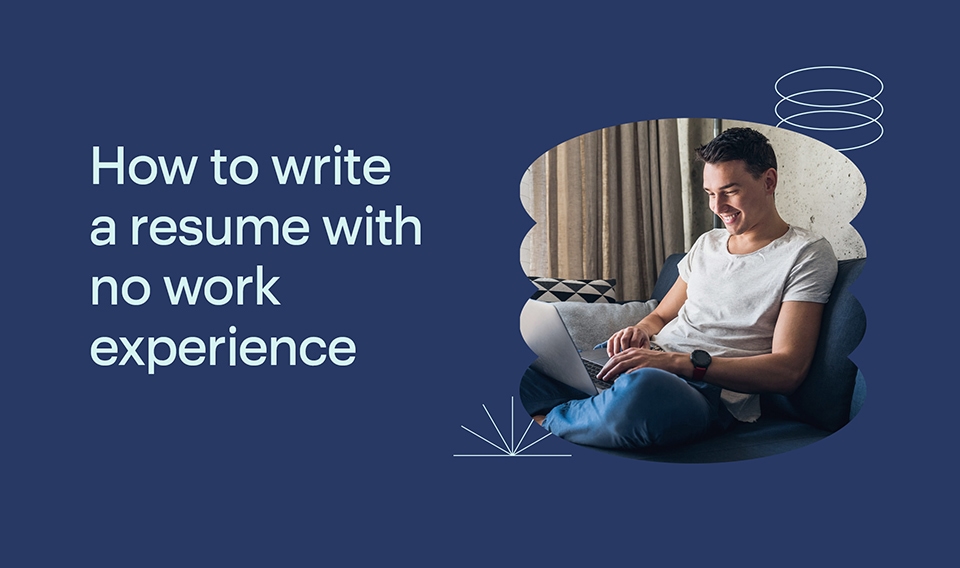
Writing your resume with no work experience can be tricky. You need to impress the hiring manager even if you have no relevant experience. When creating your first resume, focus on skills that are unique and valuable. Appropriate experience may include causal jobs, volunteering, or school activities.
Creating your first resume or applying to jobs without experience can be scary. How do you write a resume with no work experience? It may even be your first time having to write a resume, put eye-catching resume objectives, list your job skills , or choose a resume format. But at the end of the day, there is a first for everything, and hiring managers know it.
Do you want to save time and create your resume in just a few minutes? Try our premade Microsoft Word resume templates that will help you save time on designing and formatting so you can focus on highlighting your skills and expertise.
How to write a resume with no experience (with examples)
1. identify your goals for writing a resume with no experience, 2. choose a suitable resume format for a no-experience resume, 3. write a strong resume objective.
- > The objective for the resume with no experience examples:
- > Resume Objective for Students with No Experience
4. Create your education section
5. list your relevant experience , 6. highlight your skills on a resume with no work experience, 7. include your volunteer work .
- > Volunteer work on resume with no experience examples:
8. Tailor your resume for each position even with no experience
9. write and attach a strong cover letter , sample resume with no work experience.
There are several steps you should take before starting to write your resume . One of the most important ones is identifying your career objectives and finding the positions and industries you want to apply for. This is crucial to success because it will help you determine what aspects of your skillset and experience to focus on and what to highlight.
No matter how good of a fit you might be, you won’t see much success if your resume doesn’t stand out. So, remember that your resume should show that you can bring value to the company and are knowledgeable about the position. To achieve this, it’s vital to find out what your potential employer is seeking in an employee in two easy steps:
- Begin researching the job listings that align with your career goals and interests.
- Take note of and write down the keywords that appear repeatedly. These may be requirements, certifications, or skills that most of the job descriptions mention. You will want to include these throughout your resume to truly stand out.
Writing a resume with no work experience can be nerve-wracking, especially if it’s the first time writing a resume altogether. To get started, remember that a resume should always include the following five sections:
- A header with your name, job title, and contact details
- A resume summary/objective that presents your skills and achievements in a short paragraph
- An education section with the degree(s) or diploma(s) you have earned
- Your work experience, which can include even volunteering or similar experiences
- A skills section that summarizes all of your best abilities and talents that are relevant to the job
For a resume with no experience, you can also include extra sections for your hobbies, language skills, or academic projects.
But what’s the best way to organize these sections? That depends on the resume format you choose. There are three popular resume formats: functional, chronological, and hybrid. The functional format highlights skills and achievements and focuses less on work experience. On the other hand, a chronological resume format lists the work experience in reverse chronological order.
Finally, a hybrid format combines the other two, illustrating work experience and skills. While many employers prefer a chronological format, the other two are often better for resumes with no work experience. This way, hiring managers will see your achievements and skills immediately. Whichever format you decide to use, make sure to stick with it throughout your resume.
Read more: “What’s the Best Resume Format for 2024? [Pros vs Cons]
A resume objective is a brief introductory statement that describes your professional goals. Unlike a resume summary , a resume objective is suitable for a resume with no experience because it focuses on the value you could bring in the future. On the other hand, a resume summary presents existing achievements and expertise.
Most of the time, the recruiting manager is flooded with resumes. Thus, they only have a few seconds to scan each one. This paragraph is your opportunity to grab their attention and convey your abilities.
A resume objective should be no longer than three to four sentences and include the following information:
- Your field of study and highest education
- The skills and experiences that are relevant to the position
- Your motivation for applying to this particular position
Just like with contact information, you don’t need to give your resume objective a separate heading. Instead, you can place it under your header.
Example #1: Resume objective for freshers:
Example #2: resume objective for students with no experience.
Read more: “Resume Objective Examples for 2024 [+How-to Guide]
In your education section, show the degrees, training, and certifications that align with your professional goals without appearing over-or under-educated.
To do this, begin by documenting your educational and training background. This should be just an outline of what you’ve collected, so don’t stress about it not being amazing yet.
What should your education section include?
- Degrees and certifications earned
- Name of the degree
- Name of the college, university, or training school
- Years attended
- Optionally, you may also include:
- GPA if it is 3.40 or above
- Specific relevant coursework
- Exchange studies
- Extracurricular interests and online education/training
Creating your experience section may seem daunting since you most likely lack formal work experience. However, you still have much to include in this resume section, even with no work experience. Depending on your background, you can include:
- Academic projects – The easiest experience to include is academic projects. Whether it’s software you made in a programming class, a marketing campaign, or a website you created, they’re all experiences that show you have the skills to succeed. Overall, this is an excellent opportunity to add value to your resume without experience if you are a high school or college student. You can also include interests and hobbies if they relate to the work and have provided you with transferable skills. Extracurricular activities prove you’re dedicated and driven, so don’t be afraid to include them!
- Internships – Next, paid and unpaid college internships are one of the best weapons you have against the phrase “experience necessary.” They provide real-world work experience and help you network and develop contacts that may lead to a career later. So if you’re a college student writing a resume with no experience, include any internships you have undertaken.
To include an internship on your resume, first, write the title and function of your internship. Instead of simply “Intern,” use “Sales Intern” if your internship was in the sales department. Then, write down the name of the firm, the location, and the length of the internship – in that order. After that, provide a bulleted outline of your intern tasks and achievements. Finally, tailor your duties and accomplishments to the position you’re applying for.
Work experience example:
Marketing Internship YXPic, LLC. Miami, FL 2017 – 2019
- Managed firm social media accounts.
- Analyzing different social media outlets for viral content.
- Posted engaging content on the company’s Facebook page, which resulted in a 25% increase in customer interaction.
Lawn mowing and trimming Miami, FL 2015 – 2017
- From early spring until mid-fall, mow, edge, and trim lawns.
- Maintained seven lawns weekly throughout the season.
- Developed customer service skills to earn referrals and get more clients.
- In six months, I went from having 2 to having 10 clients.
- On lawn service, I earned and kept a five-star-rated page on Facebook
When creating your skills section, it’s crucial to focus on relevant, transferrable skills. The first step is to go through the job description and list the key required skills and qualifications you can meet. Employers value both soft and hard skills, so keep that in mind.
Team leadership, verbal communication, and self-management are soft skills that apply to every role. Hard skills , such as industry-related software or a foreign language, are gained through specialized education or training.
Because soft skills are harder to teach, most businesses focus on them when recruiting for entry-level employment. It’s okay if you haven’t yet developed all the hard skills required for a job. Nowadays, most companies will recognize your worth as a possible new employee if you prove to be a fast learner.
Still, make sure that you only include skills that are relevant to the position. For example, if you’re applying for an administrative assistant position, coding or trade skills won’t be very helpful.
Hard skills, soft skills examples:
Hard skills: Microsoft Excel , Cloud Computing , CRM Systems , Email management , POS Software , Programming Languages , Customer service , SEO
Soft skills: Interpersonal Skills , Collaboration , Problem-solving , Communication , Time management , Adaptability , Organizational skills , Active listening
Read more: 30 Top Skills for a Resume (With Examples)
Volunteering demonstrates your commitment and desire to put your skills to use. And nothing makes a recruiter happier than a dedicated employee. You may include it on your resume whether you volunteered at a soup kitchen or helped gather rubbish in the countryside. Most employers consider volunteer experience alongside paid professional experience. Thus, you should always aim to include volunteer work that displays your abilities or where you learned a new relevant skill on your resume.
Volunteer work should be stated in the same way as your employment experience section on your resume. So mention the organization’s name, location, the time you worked there, and a bulleted description of your responsibilities.
Volunteer work on resume with no experience examples:
Freelancing & Volunteering Phoenix, AZ 2017 – 2019
- Designed posters and created a Facebook page to assist a local community in promoting a series of garage sales events.
- Wrote promotional pieces and 20+ professional product evaluations for a small technology website.
- Converted a family member into an Apple customer by convincing him of the benefits of iOS over Android-based on his needs.
- Supervised a team of two regular news and content writers for a musical band’s fan site mentioned in a local newspaper.
- Planned and led games and activities for groups of elementary school students.
- Completed a course on the basics of efficient marketing on Udemy.
Nursing Volunteering Experience American Pulmonary Disease Association 2018 – 2018
- Provided patient education to 8 patients weekly.
- Performed an average of 13 health checks per week.
- Received praise from facility management for outstanding patient contact.
- Oversaw physical therapy sessions for 5 patients bi-weekly.
Customizing your resume for each position you apply for is the last and most essential aspect of developing a strong resume. If you lack experience, your greatest chance of landing an interview is to tailor your resume to the position you seek. Examine their job description to determine the skills they require. Then, take the skills you possess from the list and add them to your skills area. Different job advertisements will include different keywords, work responsibilities, etc. Adapting your application to each employer’s demands and job requirements is the best way to get your application noticed.
Most businesses utilize an applicant tracking system (ATS) to screen and organize resumes. So, when applying for any job, you must include a list of keywords on your resume to combat this. The best place to find these is in the job listing itself or in advertisements for related positions.
About half of applicants include a cover letter with their job application. So even with the lack of professional experience on your resume, you can increase your chances of success by preparing a strong cover letter.
A cover letter is a one-page letter sent with your resume as part of your application. Essentially, your resume describes your experiences, while your cover letter explains how they relate to the position. Here are the steps you need to take to compose an outstanding cover letter:
- Ensure that the format of your cover letter adheres to all professional correspondence formatting requirements.
- Create an engaging introduction to your cover letter that presents you to the readers and motivates them to continue reading.
- Describe your skills and how they may assist the organization.
- Explain why your cultural fit is exceptional.
- Always include a call to action at the end of your cover letter.
Also, ensure that your cover letter is the appropriate length. As with the rest of your resume, your cover letter should be relevant, simple, and brief.
Read more: How to Write a Great Cover Letter in 6 Steps
Example of a resume with no work experience
Sarah Brown 58 South St, Phoenix, AR [email protected] (123) 456-7890
An independent and driven business administration student with demonstrable proficiency in business, procurement, sales, and marketing. I am eager to use my theoretical knowledge and introduce the most current industry standards to the company.
EDUCATION Phoenix High School Phoenix, AR Class of 2020 (3.9 GPA)
EXPERIENCE Sales Intern ABC Company 2021-Present
- Assisted the sales regional sales manager in ad hoc tasks.
- Took notes and shared them with attendees at weekly team meetings.
- Prepared monthly reports for 7 international clients.
- Uncovered a bookkeeping error, saving the department 5% of yearly expenses.
Soup Kitchen Volunteer Phoenix, AR 2020 – 2021
- Acted as weekend/holiday volunteer manager at a local soup kitchen.
- Organized volunteer shifts and monitored the input of donated food.
- Aided with preparing and delivering meals on Sundays and major holidays, including Thanksgiving, Christmas, and Easter.
Pet Sitter Phoenix, AR 2018-2020
- Established and operated a profitable pet sitting service.
- Offered services including dog walking, feeding, and yard maintenance to locals in a 5-mile radius.
- Acquired and maintained 13 clients, arranged and attended visits, coordinated appointments, and managed client relationships.
- Collaboration
- Bookkeeping
- Attention to detail
- Microsoft Office
AWARDS & ACHIEVEMENTS
- National BA Honor Society
- Volunteer Club President and Treasurer of the Phoenix High Cheerleading team
Writing your first resume can be daunting, especially if you have no work experience. So, get ready to edit and tweak your resume until you get the desired results. Using these simple tips, you will create a resume demonstrating your strengths and getting you noticed. This is your chance to show prospective employers how you’ve prepared for the job and why employing you would benefit their company.
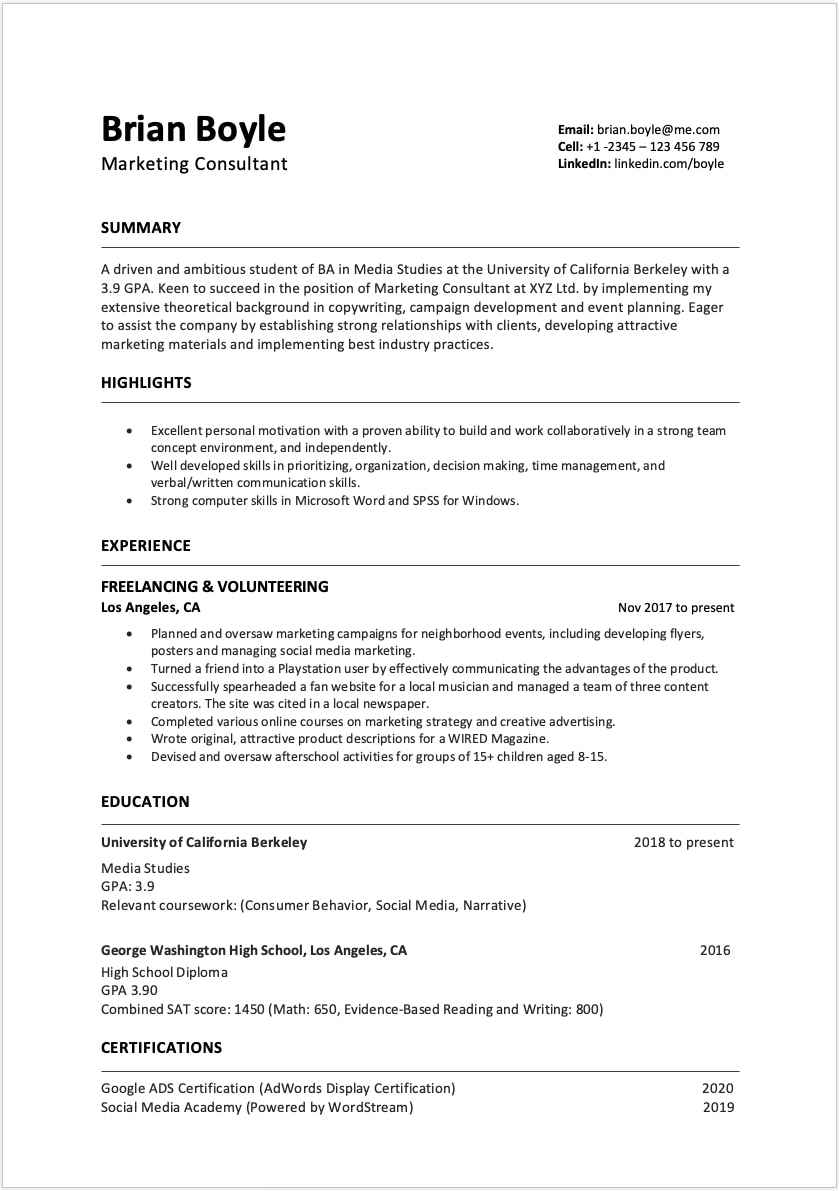
Popular related posts:
- 15 Best Skills for a Resume (With Examples)
- Thank You Email After Interview: Examples, Dos, and Don’ts
- 7 Ways to Improve Your Cover Letter Today
- Resume Objective Examples for 2024 [+How-to Guide]
- Cover Letter Format: A Step by Step Guide for 2024
- How To Write a Cover Letter With No Experience in 9 Steps
Get Expert Resume Writing Help
No time to polish your resume and cover letter? Send it to our team of resume writing experts.
- No products in the cart.
- Resume Writing Service
- Free Resume Review
- Resume Templates
- Career Advice

CVs & Résumés
- Jan 11, 2024
How to Write a Résumé with No Relevant Experience (Example)
You can still put your best foot forward.
Mike Dalley
HR and Learning & Development Expert
Reviewed by Chris Leitch

We will all have times in our careers when we need to consider applying for jobs with little to no experience. Often, this is when we’re starting out in our careers, but also you might be thinking about relocating or changing jobs.
Applying for a job with no relevant experience is challenging, but it can be done. The process starts with a great résumé, and this article will cover what goes into one. We’ll discuss how to write a résumé with no experience, what to focus on, résumé tips, and also a sample résumé for your inspiration.
Should you apply for a job when you have no relevant experience?
There are plenty of valid and perfectly acceptable reasons for applying for jobs when you have no relevant experience.
For starters, if you’re a college graduate or looking for entry-level jobs , then you will likely have no experience at all to share with employers. Secondly, if you’re considering changing careers, then you might also have no relevant experience to share.
In many cases, employers love to hear from candidates with little to no experience. Such candidates can bring fresh perspectives and new ideas. They will often come with a wide variety of transferable skills that can be applied to many different jobs or educational achievements that can be applied to new industries.
Candidates who show a great attitude, enthusiasm and a willingness to learn can bring many benefits to the workplace, and all it takes is to ensure your résumé stands out from the crowd when the time comes to apply.
What should you include in your résumé?
A résumé should never be a list of skills and experience, and when writing a résumé for a job when you have no relevant experience, this is doubly so.
A good résumé starts with a strong personal statement, as this is where you want to grab the hiring manager’s attention and encourage them to keep reading. After this, focus the résumé on transferable skills: abilities that can be used in a variety of settings, such as communication skills , administrative ability, or technical credentials like programming ability or word processing capability.
Also include your academic achievements and qualifications, as these also hold relevance to a wide variety of situations. Talk about coursework and projects, as these can highlight transferable skills too. Also, if you have held volunteering roles or undertaken community work, these can also add an extra dimension to your application.
What’s the best résumé format?
If you have no relevant experience, steer away from a traditional chronological résumé format , which is geared to showcase work history. Instead, consider both functional and combination résumé layouts. Both are well-known and understood by recruiters.
Combination résumés balance soft skills and qualifications with an abbreviated work history section. These are good to use when you have some work history but also want to highlight academic achievements.
Functional résumés focus on categorizing skills, putting them into sections, and explaining how you have used these skills. These résumés are best to use when you have little work experience or are changing careers.
Résumé writing tips when you have no relevant experience
Carefully preparing your résumé is critical when it comes to applying for a job with no experience. Here are 10 tips to help you do just that:
1. Start with a strong objective or summary
The key to any résumé is to pique the reader’s interest.
If you have no relevant experience, then the most important thing to start with is to create an eye-catching personal statement or objective that illustrates why you want the job and what skills, education or achievements mean that you are qualified for it.
Ensure this section is tailored to the job you’re applying for (using keywords from the vacancies or job descriptions), and keep the language punchy and positive.
A good summary section should only be a few lines long. If you feel you want to add more, consider attaching a cover letter to your application as well.
2. Emphasize what you can do, not what you can’t do
When applying for a role with no relevant experience, it’s important to think positively and reference in your application everything that you can bring to the organization.
Avoid using phrases like “Although I have not worked in this field before” or “I might not have the experience you need, but I can…” as this language is passive and presents a negative “you” that might discourage recruiters from considering your application further.
Instead, ensure you reference in your résumé everything that is relevant and transferable to the role, and explain these points positively.
3. Pick and choose what to include
Focusing on what not to include in a résumé is just as important as focusing on what goes into it.
When applying for a job with no relevant experience, sometimes certain elements of a traditional résumé can be left out. This can include specific work experience that is not relevant to the job or even some qualifications that will not be applicable to the role you are applying for.
Certain résumé types , such as functional and combination formats, are structured in such a way to support you in omitting the right information so that your application is laser-focused on the things that will matter and add value to your application.
4. Proofread
When writing a résumé with no relevant experience, it's too easy to focus on the wrong information or go off on a tangent, writing about things that might not matter, just because we think more information is better.
When you have written your résumé, either proofread it yourself the day after you have written it or ask someone with a fresh pair of eyes to go over the document and see whether it makes sense and if it is concise and focuses on the job.
Go through the drafting and proofreading stages a couple of times until you are sure that you have a résumé that isn’t waffling and is highlighting the right things about your credentials.
5. Hire a professional writer
When you’re applying for a role with little to no experience, creating a résumé that will resonate with recruiters is challenging. The role of a professional résumé writer is for them to support you and write a professional modern résumé that is ATS compliant and gives you the best chance of success.
Professional résumé writers can be a great investment. They will meet with you to understand your career needs, and once it's written, you can use it over and over again.
6. Use action verbs
Action verbs can really make your résumé come to life. They are especially useful in functional or combination résumés, as they can make your skills and achievements jump off the page. They also convey experience, even if you don’t have much. Examples of action verbs include “led”, “executed”, “increased”, “managed”, “facilitated” and “analyzed”.
Using a combination of action verbs gives the best impact in a résumé, as does using them to start off bullet points . Make them even more powerful by tailoring them to job descriptions and ensuring you are using them in the same tense throughout the résumé.
7. Emphasize achievements
When writing about your skills and education in your résumé, it's important to make them jump off the page.
Tying achievements into your résumé brings it to life and shows recruiters that you not only have credentials, but you have put these to work as well. You can also talk about your achievements when writing about your extracurricular activities .
Where possible, when adding your achievements into a résumé, relate them to the organization or industry you are applying to for maximum impact. Give particularly important achievements emphasis by highlighting them in your personal statement.
8. Tailor your résumé for each application
Tailoring your résumé for each application ensures that recruiters see the context and reasoning behind your application. This can be done by talking about your motivations, education and skills, and referring to the industry or the job description at the same time.
Similarly, you might want to only include relevant skills or education that are aligned to particular roles.
Tailoring your résumé also ensures it’s ATS friendly. Aligning verbiage to words and phrases in the job description means that the résumé’s information is parsed effectively, making it pass automated screening systems.
9. Emphasize your skills section
When you have little to no relevant experience when applying for a job, your skills section is your best friend. When emphasizing your skills section, bump it to the top of your résumé, under your objective or personal statement.
But don’t just list your skills: explain them, detailing accomplishments and aligning them to the job you’re applying for.
Furthermore, highlight two or three of your strongest or most relevant skills in your personal statement. This drives home to recruiters your competencies and what you are strongest at.
10. Get the formatting right
When applying for a job using a résumé, the document is making your all-important first impression to your potential employer. Therefore, you must ensure it’s professionally laid out and expertly written.
Sure, professional résumé writers can help with this, but expert formatting only requires following a few fundamental rules .
Format your résumé consistently and spell check it too. Make sure the relevant information is meaningful, concise and accurate. Finally, ensure you present yourself positively and professionally in the résumé, as this will make recruiters sit up and take notice of your application.
Résumé example
Below, you will find an example combination résumé for someone with a finance background wanting to work in sales.
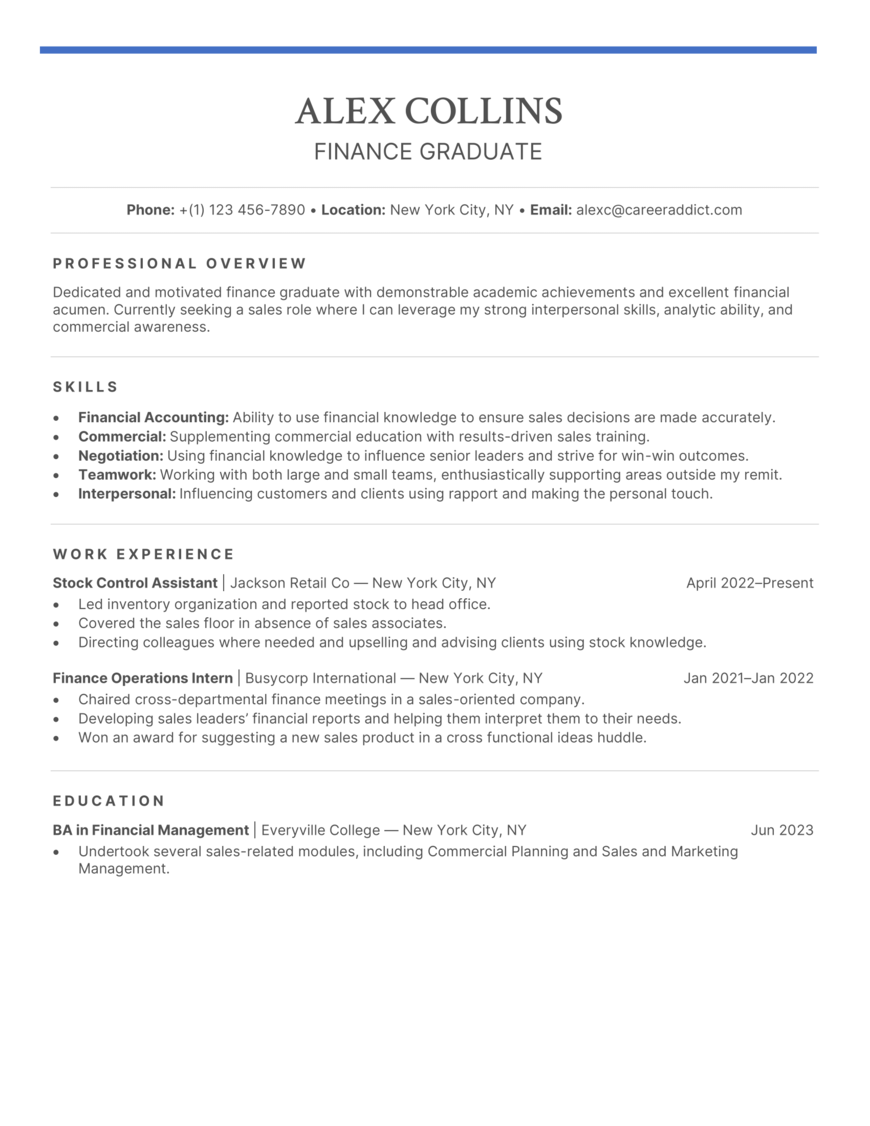
Get the ATS-Friendly template
Final thoughts
When you have little to no experience, a great résumé focuses on all the positive things you can bring to an organization in place of a work history. Typical résumés in this regard are functional or combination-based and will focus heavily on relevant skills and the education section.
Ensure that your résumé is created with care and detail, and tailored to the role you want. Ensure that it positively showcases all that you have to offer, and that everything relevant is included and everything that doesn’t need to be there is minimized or omitted. This will ensure your application is seen as relevant and aligned to the role you are applying for, giving you the best chance of success.
Got a question? Let us know in the comments section below.
Originally published on June 5, 2015.
Work Experience
Résumé Writing

Write a resume with no experience
When you’re looking to land your first job, your resume needs to impress employers.
If you have little or no work experience, this can be tough.
But, with the right structure and approach, anyone can write an interview-winning resume.
This detailed guide, which includes a resume example, will show you how to write a resume with no experience, that will still impress recruiters, and take you one step closer to landing that first job.
- Resume examples
- Structuring and formatting your resume
- Writing your resume summary
- Your education
- Vital skills for your resume
Resume templates
Resume with no experience example
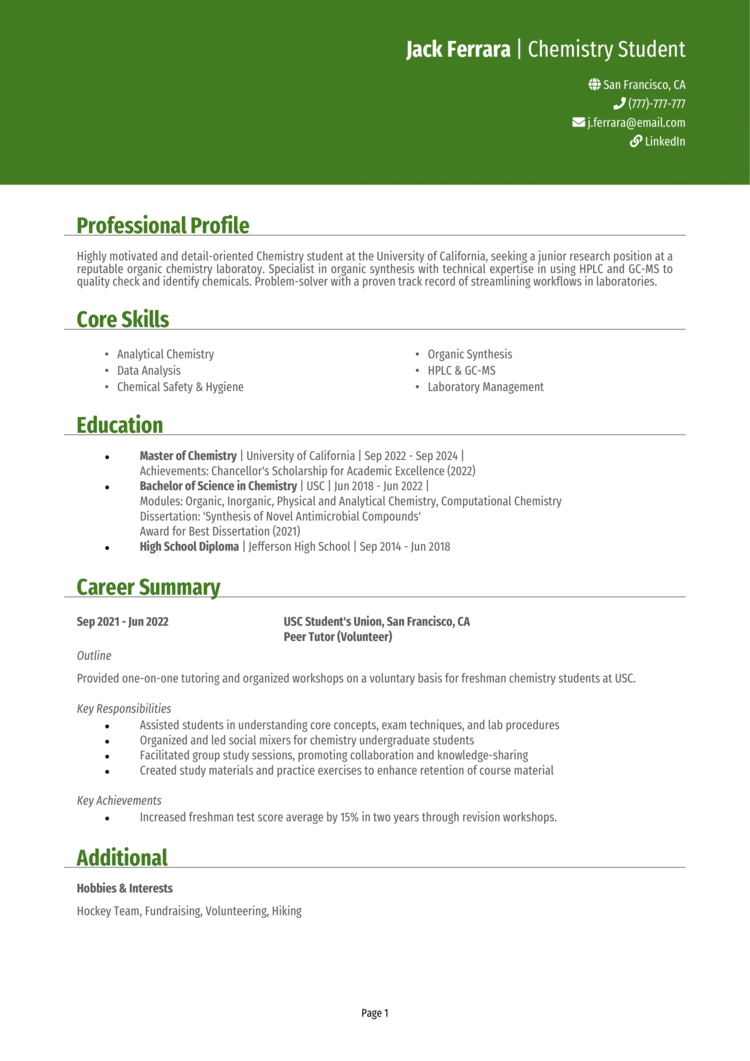
This resume example shows you the basic format of a resume, and the type of content you can include when you have no experience.
I will now walk you through how to produce your own effective resume.
You can watch the video below or read through the rest of the guide on this page.

Top tips for writing a resume with no experience
- Although you may have no formal work experience, be creative and fill your resume with anything that can demonstrate your workplace skills
- Use hobbies, interests, after-school clubs, sports teams and volunteering to highlight transferable skills
- Head your resume with a punchy summary or personal statement to sell yourself to employers and explain why they should hire you
- Make your hard skill such as languages, IT software and written communication highly visible
- Provide lots of detail on what you have learnt in school to make up for your lack of experience
Resume structure & format
The key to getting recruiters to notice your resume, is having a structure that enables ease of reading and allows them to quickly navigate your educational background and relevant skills.
Using sections to clearly identify your transferable skills, assisting you in securing an interview.
This infographic will support you in creating a simple-but-effective format and show you what sections to include in your resume
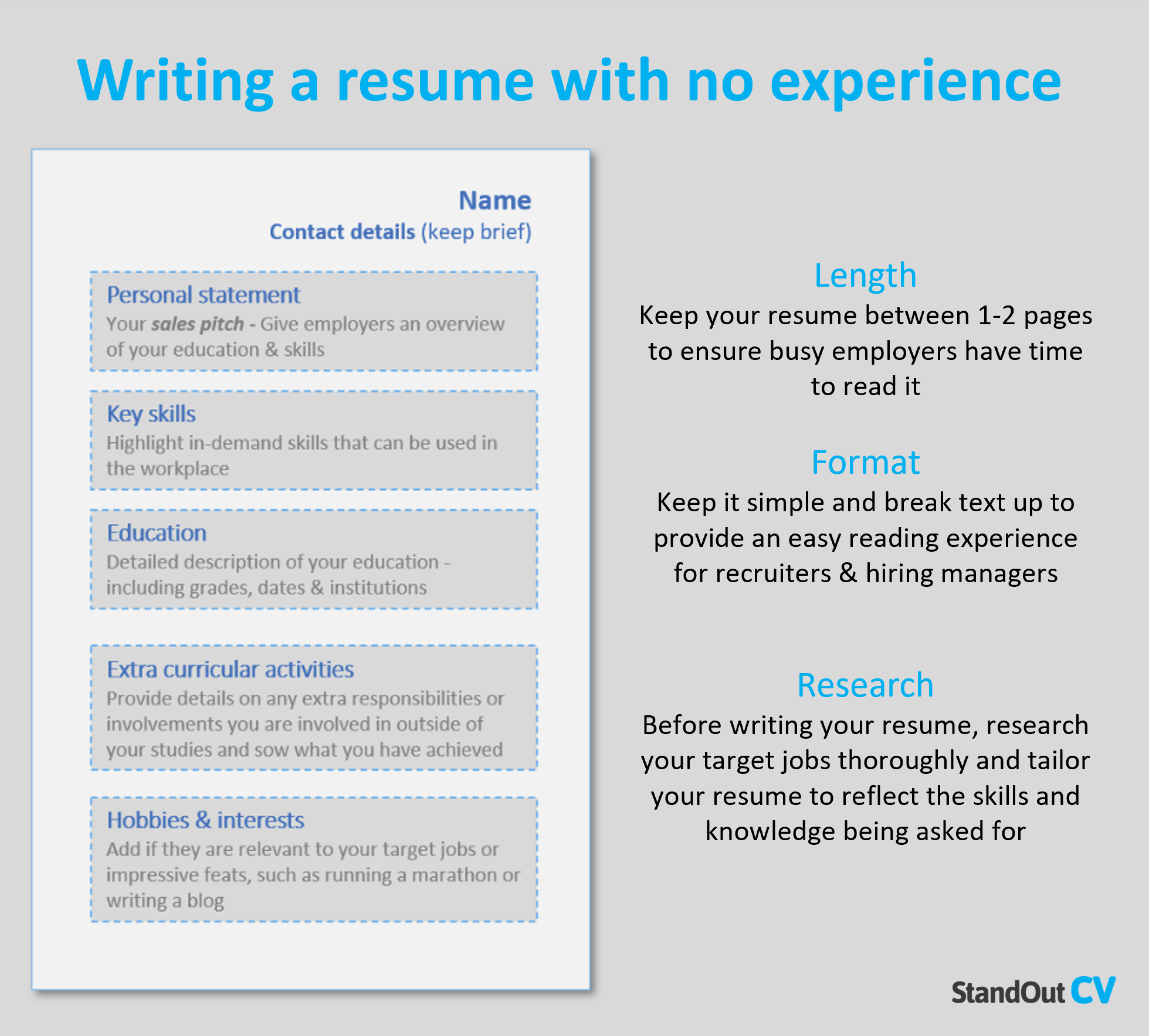
Formatting Tips
- Use bold headers, bullet points and sections to break up information and support recruiters in easily navigating your resume
- Don’t over-design your resume with imagery such as company logos or headshots and instead keep to a subdued color pallet and a clear font
- Maintain a resume length of 2 sides of A4, don’t look to add irrelevant information to fill space and be comfortable with submitting a resume that is 1 to 2 sides
Structuring your resume
Highlight essential information within your resume by breaking up large blocks of text and working to a format that focuses on your relevancy for the sector you’re looking to apply to.
Stick to the below format when putting together your resume:
- Contact details – Make your contact details easily accessible at the top of the page
- Summary – Start your resume will a short paragraph summarizing your skills and qualifications, engaging recruiters to read further
- Education – Display your qualifications, especially those most applicable to the industry you’re looking to apply to
- Work experience – If you have any, detail voluntary experience or any part time employment
- Interests and hobbies – Look to add hobbies that document your transferable skills, providing added value to your resume
You can always use a resume template , if you want to make the structuring process easier and quicker.
Resume contact details
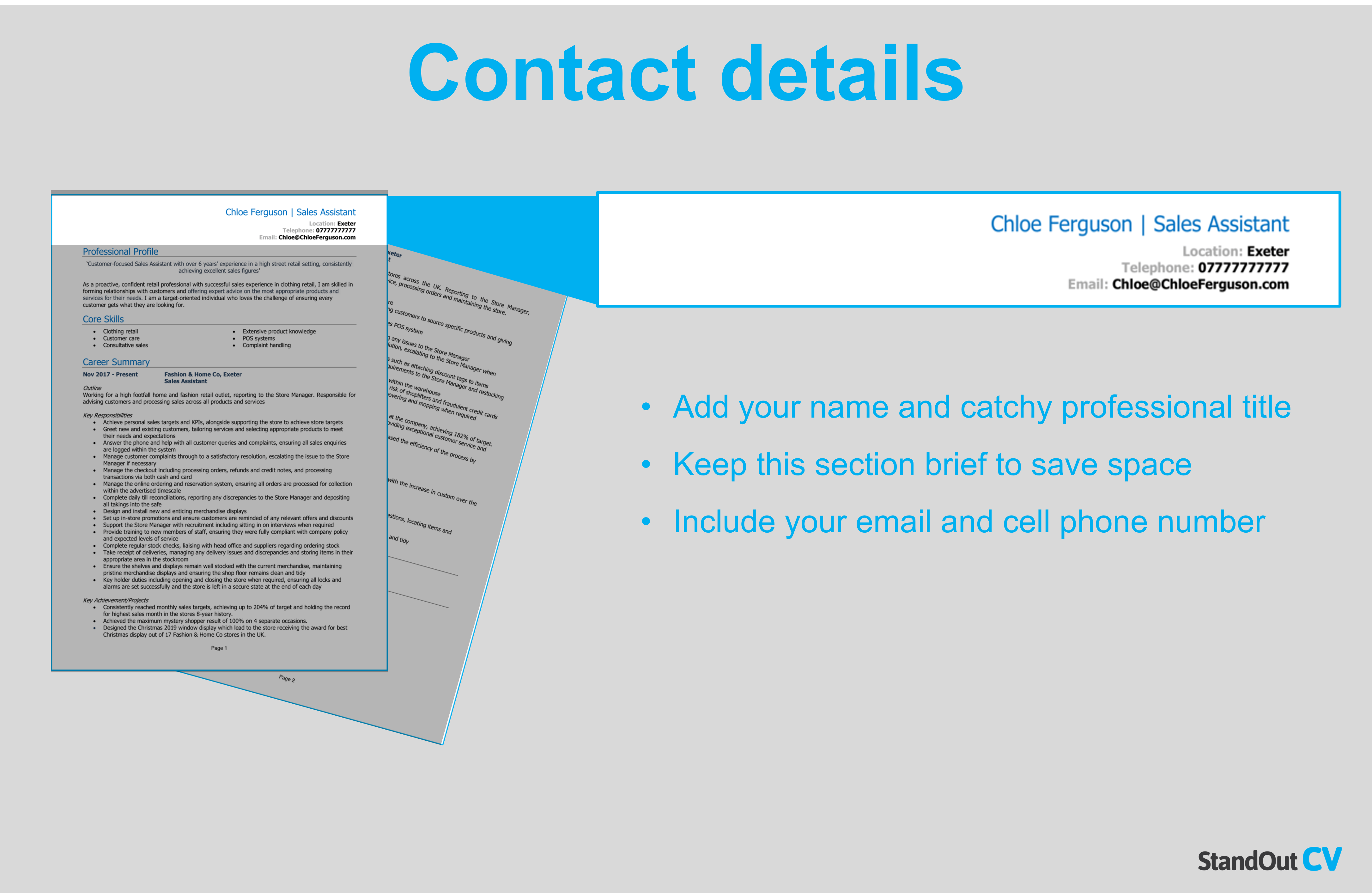
Keep your contact information to the top of your resume, allowing recruiters to easily reach you.
Stick to the essential information as seen below:
- Phone number
- Email address
Remove supplementary information such as marital status, profile pictures or date of birth that aren’t required in your application.
Quick tip: You can save space and add some design flair to your resume by adding some icons to symbolize the contact details in your header.
Resume summary
Start your resume with an attention-grabbing introduction, summarizing why you’re the ideal candidate for the positions you are applying to – in a punchy summary .
Give recruiters an insight into your background and core skills, making your educational history a focal point, displaying your interest into your preferred field – give them some good reasons to consider you.
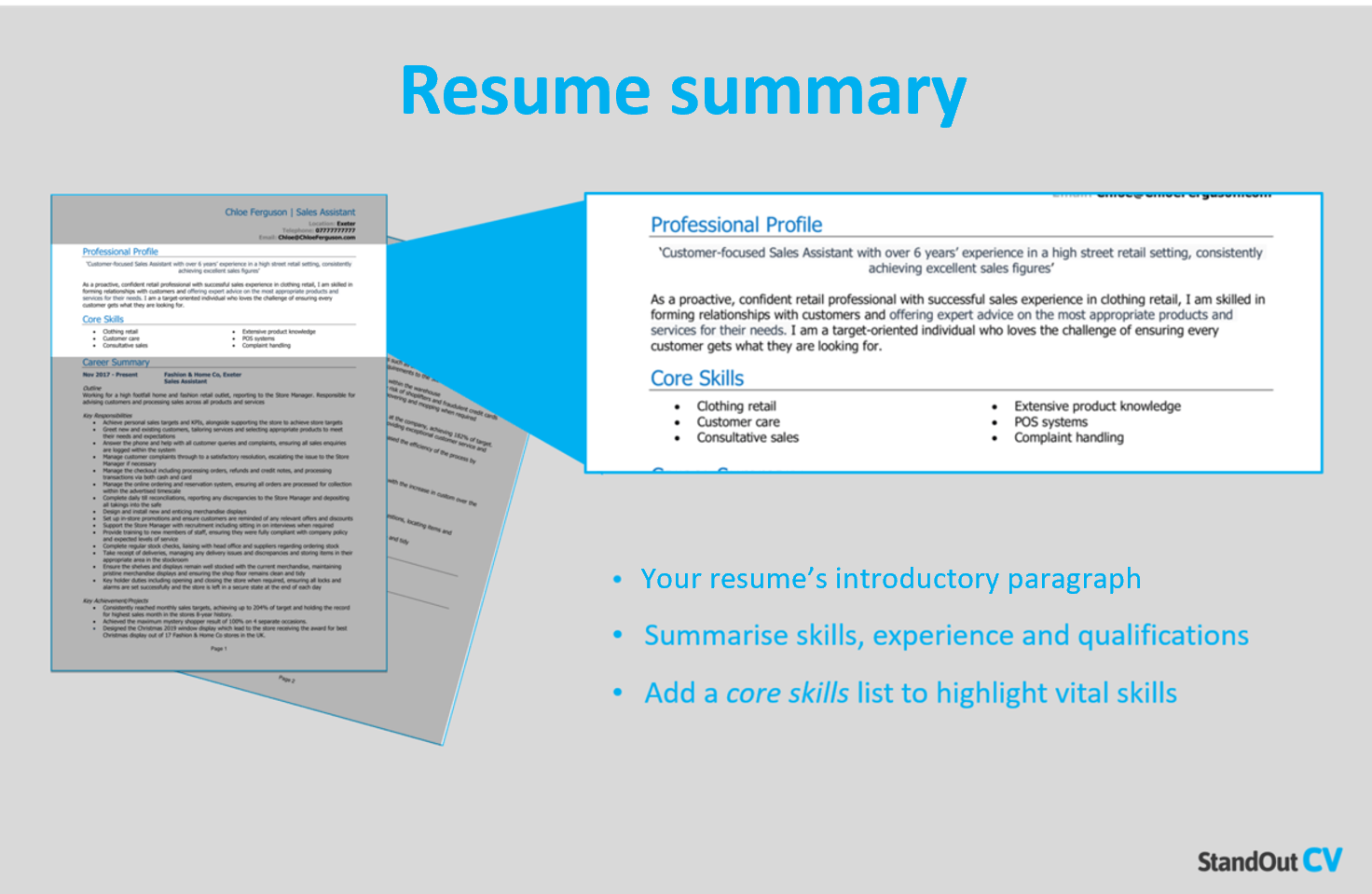
These tips will support you in producing your resume summary :
- Research your chosen industry prior to creating your summary, making yourself custom-fit to the sector, adopting sector specific keywords
- Your summary should be between 5-10 lines; you’ll be able to elaborate elsewhere in your resume
- Avoid cliché and overused statements such as “I am punctual” or “I am hardworking” and instead, try to include key requirements from the job adverts you are applying to
What to include in your resume summary?
- Qualifications – Make your education a focal point, considering qualifications most imperative to the industry you’re pursuing
- Core skills – Document any transferable or marketable skills you’ve acquired in school or university, reflecting on strengths such as interpersonal skills , problem solving, or any skills that can translate into the workplace
- Passions – Why are you interested in pursuing your chosen career? What makes you a good fit?
Core skills & achievement section
Underneath your resume summary, add a skills section that consists of your core skills, using two to three columns of bullet points to list these strengths.
Allowing recruiters at first glance to establish your most applicable soft and hard skills, which relate to the industry you’re pursuing.

Before putting together this section, look to research the industry you’re applying to, adding keywords that make you custom fit to that sector.
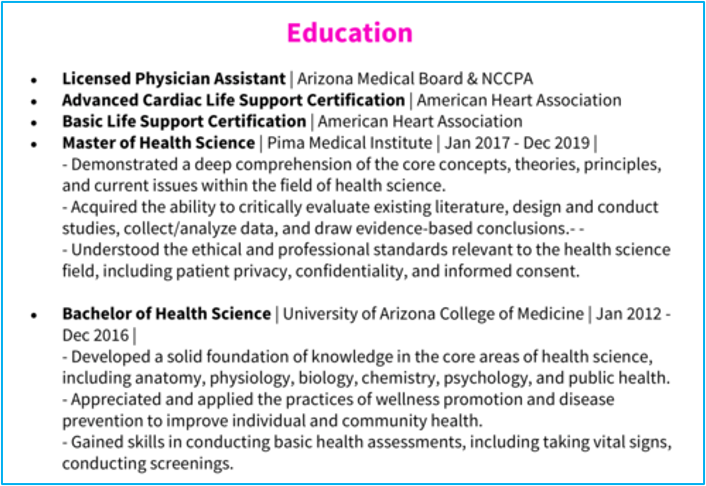
When you’ve limited or no work experience, use your educational history as a focal point of the resume.
Represent the qualifications you have achieved as well as describing examples of coursework completed and including any specific accomplishments from your educational history.
Break up this information by clearly heading the type of qualification achieved, the dates obtained and the school or college you attended.
Use bullet points to list the qualifications you secured.
Clubs and Memberships
Within your education section look to incorporate the clubs you were part of and your role within that group.
For example, whether you were the captain of a football team or a prefect at school, even considering adding any charity work you may have done.
When writing about these; try to draw out relevant skills such as teamwork, leadership, communication etc.
See also: Graduate resume – Student resume
Work experience
Although you may have no formal work experience – be creative and add anything that could be demonstrate workplace skills, such as:
- Big projects
- Work experience placements
- A weekend job
- Volunteering
- Club or sports team membership
Quick tip: If you have no work experience, pick up a volunteer role so that you have something impressive to add to the resume.
Structuring your roles
If you have anything you could add as work experience – add to your resume like the below example.
Structure the information within your roles, by breaking up large blocks of text and using bullet points, and defined sections.

Give an overview of your voluntary position, what were your duties or what skills you obtained from this experience.
“Working in a busy café supporting the kitchen and front of house staff to ensure customers have a clean and safe environment .”
Key responsibilities
Use bullet points to document any duties you had within a position.
- Interacting with the waiting and kitchen staff to collect dishes and cutlery
- Supporting kitchen preparations during opening and closing of the café
Key achievements
Document any key achievements whilst in these positions, add relevant examples integrating any facts and figures to verify these where applicable.
- Achieved employee of the month, 2 months in a row
Interests and hobbies
When you have no experience, your hobbies could help boost your application , documenting your transferable skills gained within them.
Emphasize involvement in any clubs or teams, describing the contribution you had and providing any result driven examples.
Impressive hobbies for your resume could include:
- Being in a sports team
- Being a member of a club (book club, chess club)
- Writing a blog
- Building models or machines
- Running a marathon
- Taking part in school schemes
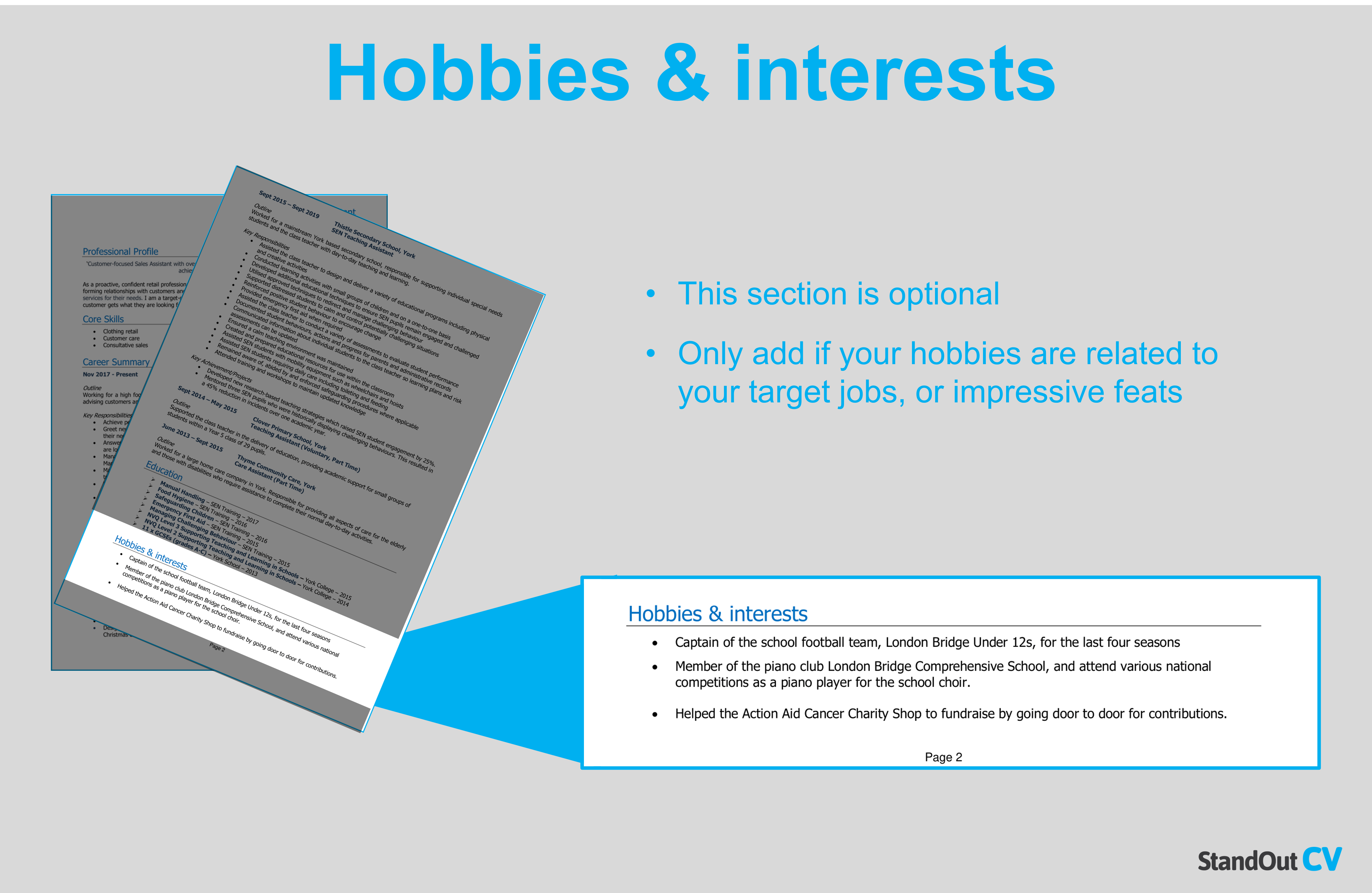
Look to display your personal pursuits, even if these interests don’t directly correlate to the industry you’re applying to, reveal how you can use the experience or skills gained within the industry you’re pursuing.
For example, if you’re looking to gain employment in technology then exhibit your passion for working with computers and the skills you’ve gained such as the ability to solve problems and work methodically.
Essential skills for your resume
Portray the skills you have obtained throughout your experience in education, placements or extra curriculum activities, explaining how these can transition into a work environment.
Look to include these fundamental skills:
Communication – the ability to speak with people of a variety of levels, whether teachers, professors, customers or colleagues
Organizational Skills – the ability to juggle studies whilst taking on voluntary work.
Teamwork – the capacity to work within a team to overcome obstacles and achieve common goals, whether in a school project or extra-circular team
Commitment and Drive – showcase your passion and commitment towards your chosen career path.
Customer Service – a talent for putting customers first and going the extra mile.
Writing your resume with no experience
When you have no work experience, your resume is your first impression in the recruitment process and your opportunity to display what makes you an ideal candidate.
Highlighting all aspects of your educational background as well as the skills that make you applicable for the industry you’re looking to transition into.
By using this guide, you’ll be able to produce a well-structured resume that will assist you in obtaining your dream career.
Good luck in your next application!
Explore Jobs
- Jobs Near Me
- Remote Jobs
- Full Time Jobs
- Part Time Jobs
- Entry Level Jobs
- Work From Home Jobs
Find Specific Jobs
- $15 Per Hour Jobs
- $20 Per Hour Jobs
- Hiring Immediately Jobs
- High School Jobs
- H1b Visa Jobs
Explore Careers
- Business And Financial
- Architecture And Engineering
- Computer And Mathematical
Explore Professions
- What They Do
- Certifications
- Demographics
Best Companies
- Health Care
- Fortune 500
Explore Companies
- CEO And Executies
- Resume Builder
- Career Advice
- Explore Majors
- Questions And Answers
- Interview Questions
How To Write Your First Resume With No Work Experience
- How To Write A Resume
- How To Build A Resume
- Specific Resume Words
- Action Verbs On A resume
- Words To Describe Yourself
- Resume Outline
- How To Make A Resume
- How To Make A Resume On Word
- How To Write A Resume Profile
- How To Write A Resume With No Experience
- General Resume Examples
- Resume With No Experience
- Student Resume
- College Resume
- Entry Level Resume
- Military Resume
- Internship Resume
- First Resume
- College Application Resume
- 2 Page Resume
- Blank Resume Template
- College Freshman Resume
- Work History
- Resume Templates
- Stay-At-Home Parent Resume
- Consulting Resume
- Resume Tips
- Best Resume Writing Services
- Things To Avoid On A Resume
- Resume Paper To Use
- What To Include In A Resume
- How To Write A Bio
- How To Write A Personal Statement
- Lied on Your Resume?
- Avoid Age Discrimination
- Words and Phrases You Shouldn't Include in Your Resume
- How Many Skills Should You List On A Resume
- Send A Resume As A Pdf
- Resume Critique
- Make A Resume Stand Out
- Resume Spelling
- Resume Past Or Present Tense
- How To List Projects On A resume
- Best Resume Action Words
- How To Quantify Your Resume
- Resume Bullet Points
- Are Resume Writers Worth It
- How Many Jobs To List On Resume
- Please Find Attached My Resume
- How To List Contract Work On Your Resume
- How To Put Research On Your Resume
- How To Upload Your Resume To LinkedIn
- Resume Mistakes
- How To Show Promotions On Your Resume
- Magna Cum Laude On A Resume
- Resume-Writing Rules
- Lying On Your Resume
- Tailor Your Resume
- When And How To Use A Two-Page Resume
- What To Remove From Your Resume
- How To Fit Your Resume On One Page
How Far Back Should A Resume Go?
- What Is A CV?
- CV Vs Resume
- CV Templates
- CV Examples
Find a Job You Really Want In
You may think your lack of work experience pulls you out of the running for most jobs. While having limited or no work experience may narrow your job search down, it doesn’t eliminate you entirely. Just because someone has a lot of experience, doesn’t mean they will have stellar application materials.
Whether you’re right out of college or have no work experience, we’ll go over how to write your first resume with no work experience, we’ll go over what counts as work experience, and provide an example resume with no work experience to help get you started on yours.
Key Takeaways:
You will want to focus on your education and any experiences you have when you don’t have any work history.
If you do not have a college education, list your most recent education experience, like the date of your high school graduation or when you received your GED.
It’s important not to lie on your resume to make it seem like you have more experience than you do because it can come back to haunt you.
Tailoring your resume and using keywords is a great way for your resume to stand out.
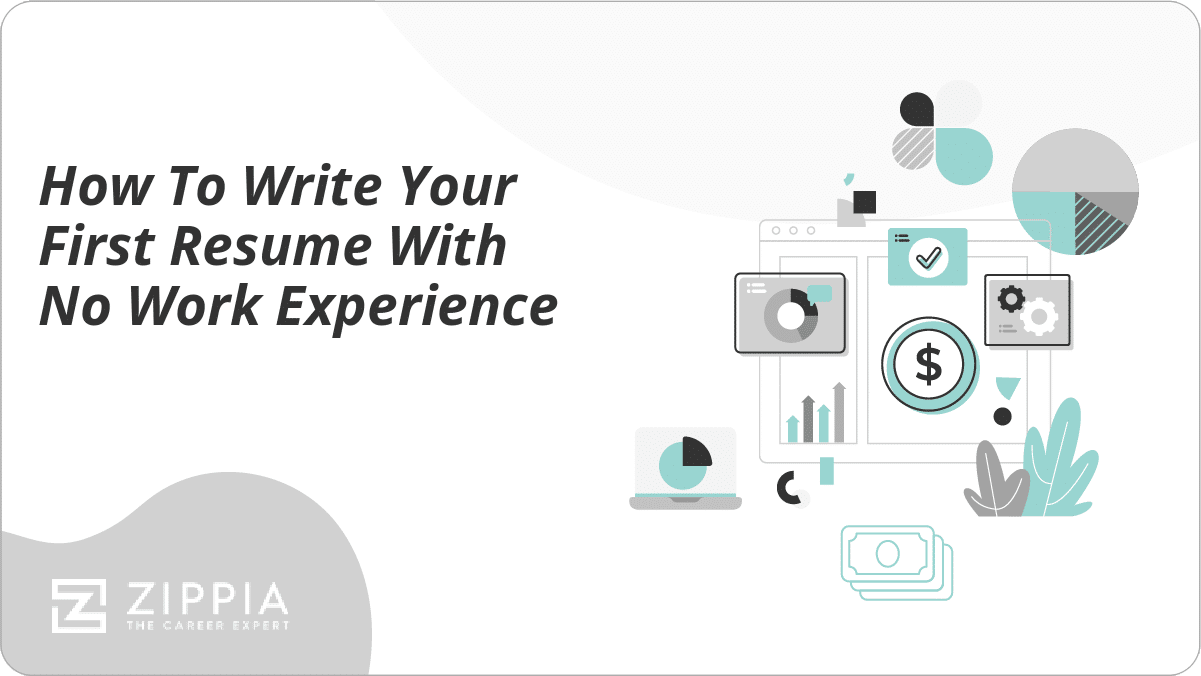
How to write a resume for a first job with no experience
First resume with no experience example, what counts as work experience for your resume, what do you put on your resume if you don’t have a college education, how a career objective is different than a career summary, should i send a cover letter, tips for writing your first resume with no experience, writing a resume with no work experience faq, final thoughts.
- Sign Up For More Advice and Jobs
When you write a resume with little or no experience you will have to craft it differently, and you will want to focus on your education and skills section. Here is a more detailed list of how to write a resume for a first job with no experience:
Contact information. The first thing you want to add is your contact information. You should include:
First and last name
Phone number
Email address
A link to a professional profile
It’s important to keep in mind that if you have been using a school email, or your email isn’t professional, create a new one. Once you have graduated that email won’t be active anymore and no employer wants to see an email from when you were in middle school.
Include a career objective. This is a statement that summarizes what you have to offer the company and why the position fits well into your career goals.
Education. This is the section you really want to emphasize. On a regular resume you would include your work experience, but since you don’t have any, this section should be at the top.
If you have a college degree or a technical degree, the experience you have gained from that alone is important to emphasize on a resume. And since those experiences are likely recent, you have fresh, up-to-date knowledge about the field, which is a great asset. Here’s what to include in this section.
Name of degree
Name of institute or university
Location of institute or university
Graduation date
GPA (optional)
Relevant coursework (optional)
Honors (optional)
Work experience. Now since you don’t have much work experience you can add any relevant experience for the job. This could include internships, part-time work, or any organizations that you have been in. We will go over more on what you can consider work experience later on.
Skills. Your resume’s skills section is where you can really line up your background with the job, even if you don’t have any formal experience. First, review the job description and highlight all of the action verbs and skills. The two types of skills to include and highlight on your resume are:
Hard skills are generally things that you must be taught to do through schooling or on-the-job training. These skills are measurable.
Soft skills are the intangible interpersonal qualities that make you pleasant to work alongside. They cannot be taught, but you can certainly improve your soft skills through experience.
For a resume with no work experience, you likely have more soft skills than hard skills. That’s okay — just be sure that you’re highlighting the soft skills that the employer values most, based on what you find in the job description (time management, collaboration, and communication are popular ones).
Awards and certifications (optional). This is the place to add anything you think might show off some of your skills to the employer. This can replace any degrees that you might not have completed yet. Having them shows that you are eager to continue learning and you have some experience.
Here is an example of writing a first time resume with no experience. Be sure to tailor your resume to each job you are applying to.
John Smith [email protected] 123-456-7890 September 12, 2023 OBJECTIVE Recent graduate with a degree in English seeking a position as a High School English teacher . Strong skills in written and verbal communication and the ability to work in a team environment. EDUCATION Penn State University Major: English Graduation Date: May 2023 GPA: 3.4 Honors: Deans List Fall 2020 through Spring 2023 SKILLS Strong written and verbal communication skills developed through coursework and extracurricular activities. Ability to work effectively in a team environment, as demonstrated in group projects and team sports. Proficient at identifying and solving problems logically and efficiently. Excellent time management skills honed through balancing schoolwork, extracurricular activities, and personal commitments.
Past experiences or short-term work can count as work experience for your resume. Here is a more detailed list of what both of those include:
Past experiences. There are all kinds of acceptable forms of work experience you can put in a section titled “experience” versus “work history.” It’s all about the framing, folks. Some of these include:
Internships
Volunteering
If you are still feeling uncomfortable about the blank space under your experience section, start filling it up. Yes, you read that right — find some new experience to put in the experience section.
Short-term work. If you are facing a resume deadline that is quickly approaching, gathering experience might not be feasible. If you know you will be applying for a job in the next few months and don’t have any experience, then it’s the perfect time to be on the lookout for short-term work opportunities .
There are many short-term opportunities that are open to freelancers. Anyone can become a freelancer . It is essentially a position in which you get paid to do contract work with no benefits and rarely guaranteed hours.
But that’s okay — because you don’t need all the perks of a full-time job yet. Think of doing freelance work as your stepping stone to a full-time job or internship . So work a few extra hours to bulk up some small gigs to add to the experience section.
Other options include volunteering , writing articles, and internships. Anything to help make it look like you’ve been putting some effort into getting real-world experience for this type of job.
If you are in college currently and have not graduated, include your expected graduation date on the resume.
Maybe you have a college education or a high school diploma, but you are worried about your GPA. If you do not have a competitive GPA (a GPA of 3.5+) you can opt to not include your GPA on your resume . If you are many years past your graduation date, you can also consider not including your GPA.
When writing a resume for a first job with little or no experience, you will want to write a career objective instead of a resume summary statement . You are probably wondering what the difference is between the two. And yes, there is definitely a difference.
A career summary is a statement that summarizes your work history section and gives some details about what type of worker you are and how you will fit the role. A career objective, on the other hand, is a statement that summarizes what you have to offer the company and why the position fits well into your career goals.
Examples of Career Objectives:
Career objective example
A dedicated worker with a BA in Marketing from the University of Connecticut. Looking to join the XYZ Inc. marketing team to aid in developing digital marketing campaigns that drive traffic and increase conversions. Background in consumer psychology and collaborative projects, including creating materials for UCONN’s writing center.
Highly motivated graphic designer hoping to obtain an entry-level position to leverage skills with Adobe Suite. Trained in modern graphic design elements and integration.
Recent graduate with a degree in Finance seeking a position at a reputable financial institution. Strong skills in mathematical modeling, market research, and personal finance tools like Quickbooks and Excel.
The only time you shouldn’t send a cover letter is if the company specifically asks applicants not to. A cover letter can help boost your application’s chances of success if you don’t have much work experience.
A resume answers the “who, what, where, when” while your cover letter answers the “how” and “why.” A cover letter should show the hiring manager how you’ll do the job better than the competition, as well as show off your intrinsic motivation
You should tailor to the job for each cover letter you send. Do some research on the company’s culture , mission, and values, and try to show how you’re the perfect cultural fit.
Just keep your cover letter to under one page long and about 200-400 words ( shorter is usually better ).
You should proofread your resume and don’t lie or exaggerate any of your skills. Here are some more tips to keep in mind when making your resume:
Proofread. It’s so important to proofread before you submit your resume. Take an extra few minutes and look over for any spelling or grammar mistakes. Make sure all of your dates and information are correct.
It can come across as unprofessional to submit a resume with mistakes. You can even have a friend look it over for anything you might have missed.
Don’t lie. Don’t lie about anything on your resume. If you don’t have any work experience or didn’t join any clubs while in school, it’s okay. Everyone has to start somewhere. If you do end up lying, be prepared for your boss to find out and potentially fire you.
Tailor to each job. Take a few minutes are reread the job description to include any relevant skills to your resume. Doing this will help your resume get noticed by a hiring manager and show that you are the right candidate for the position.
Pick a simple format. You want to make sure your resume is easy to read. A hiring manager usually only takes about six to seven seconds to read a resume before moving on. You don’t want them to spend that time trying to figure out what your text says.
Use keywords. Take some time and look over the job description and look for keywords. It’s a great way to tailor your resume to each job while highlighting the skills that they are looking for.
Apply for the roles that fit your skills. When you don’t have experience, you want to find jobs that fit your skills. This means focusing on entry-level jobs or internships. These jobs are often looking for candidates with little or no experience.
How do you say you have no experience but are willing to learn?
An example of saying you have no experience but are willing to learn is “While I don’t have the necessary experience, I believe my enthusiasm and willingness to learn makes me a strong candidate for this position.” This answer shows the interviewer that you are excited and enthusiastic about the position and you are highlighting your willingness to learn.
Can you still get a job without experience in the field?
Yes, you can still get a job without having experience in the field. When applying for jobs without experience, you want to apply for entry-level positions and highlight all of your transferable skills. You should also consider any volunteer work or internships that you have done.
What can be used on your resume when you don’t have experience?
When you don’t have experience for a job, you can use the following on your resume:
Past experience such as internships or volunteering.
Short term work such as freelancing.
Extracurricular activities such as clubs and sports
Many hiring managers want someone who has the experience to prove a candidate has a good work ethic, but not too much experience that they can’t be molded to the job. Luckily for you, with the tips listed in this article, you will be able to show hiring managers that you are just that person.
It can be scary to apply with other candidates who have a lot more experience, but when it comes to applying for jobs, one of the best skills you can learn is how to frame yourself as the perfect candidate.
Emphasize what you can bring to the position. Be honest but don’t sell yourself short. Highlight what you have accomplished and your enthusiasm for the position and you will be one step closer to landing the perfect job. In the meantime, check out Zippia’s resources for finding your first job.
Champlain College Online – Writing a Resume When You Have No Relevant Experience
How useful was this post?
Click on a star to rate it!
Average rating / 5. Vote count:
No votes so far! Be the first to rate this post.

Heidi Cope is a former writer for the Zippia Career Advice blog. Her writing focused primarily on Zippia's suite of rankings and general career advice. After leaving Zippia, Heidi joined The Mighty as a writer and editor, among other positions. She received her BS from UNC Charlotte in German Studies.
Recent Job Searches
- Registered Nurse Jobs Resume Location
- Truck Driver Jobs Resume Location
- Call Center Representative Jobs Resume Location
- Customer Service Representative Jobs Resume
- Delivery Driver Jobs Resume Location
- Warehouse Worker Jobs Resume Location
- Account Executive Jobs Resume Location
- Sales Associate Jobs Resume Location
- Licensed Practical Nurse Jobs Resume Location
- Company Driver Jobs Resume
Related posts
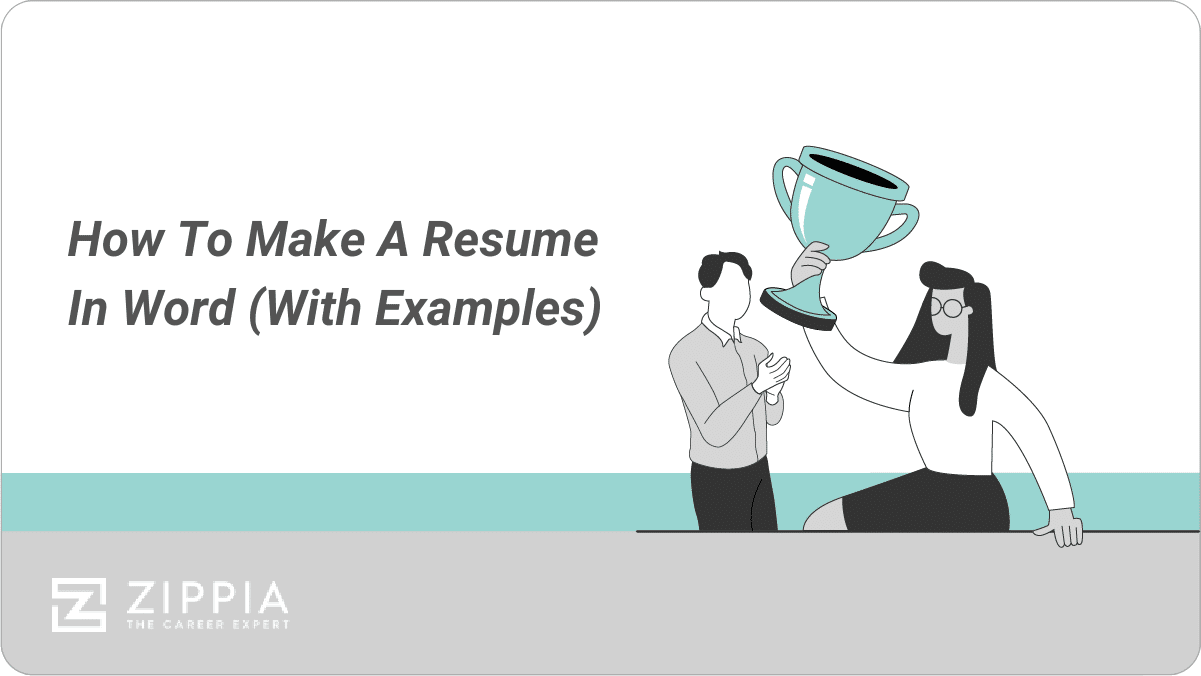
How To Make A Resume In Word (With Examples)

A Peak into American Hero Dr. Fauci’s Resume
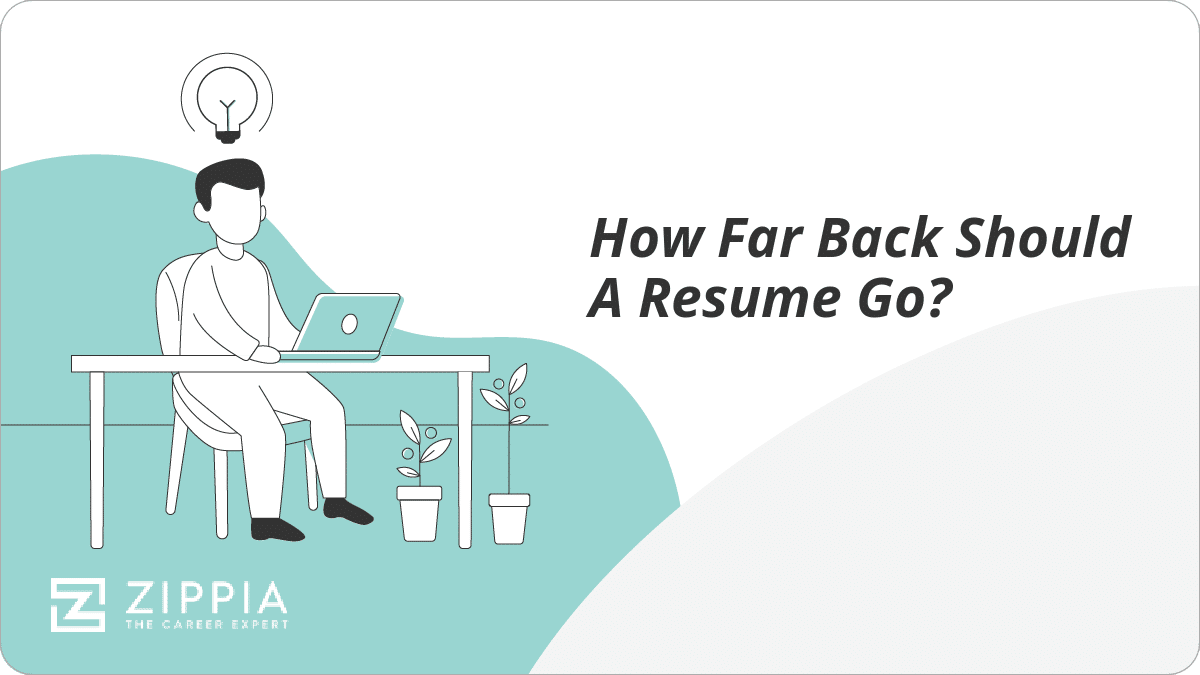
9 Things To Remove from Your Resume ASAP
- Career Advice >
- Resume For First Job No Experience
How to Write a Resume for Today’s Job Market
To get more job interviews, you must create a resume that is optimized for applicant tracking systems (ATS). Learn how in this step-by-step guide.
Customers Interviewed by:
Learning how to write a resume is a crucial skill for job seekers—it’s how you market yourself to potential employers.
A well-crafted resume summarizes your professional experience, skills, and achievements. It should grab the hiring manager’s attention and show them them why:
- You’re the perfect match for the job.
- The skills you have will make the company money.
- You’re qualified to solve the company’s problems.
- You’ll be worth your salary.
- Your accomplishments can be measured and verified.
But in today’s job market, it’s not enough to write an effective resume. You must also tailor each one to the job you’re applying for. Why? Because most companies today use applicant tracking systems, or ATS, to sort and filter the large volume of resumes they receive.
If you’re resume doesn’t contain the specific keywords hiring managers are searching for, it won’t be found—even if you’re qualified for the job!
In this guide, you’ll learn how to write a resume that stands out in today’s job market. We’ll show you how to present yourself as the ideal candidate, highlight the skills that will benefit potential employers, and ensure your resume is compatible with ATS.

How to write a resume that gets interviews
Here’s a quick overview of the basic steps for writing a professional resume. Follow these steps to make your resume clear, concise, and appealing.
Gather all relevant data about your work experience, skills, achievements, and education.
Select a format that’s right for you, whether it’s chronological, functional, or hybrid., clearly list your name, phone number, email, and key social media profiles., create a compelling headline that includes the job title you’re applying for., write a brief statement that summarizes your key achievements and value you offer., list the skills you have that align closely with the job requirements., detail your past job roles, responsibilities, and accomplishments., include your educational degrees, certifications, and relevant training., showcase any relevant honors, awards, and volunteer work., tailor your resume by focusing on the experiences and skills that are most relevant to the job..
Before you start working on your resume, remember that your resume is not your biography. You’re not telling the story of your life. Instead, your resume should be a targeted document meant to showcase the skills and experiences that match the job you want .
This means that if something is not relevant to your targeted job, leave it out . With this in mind, let’s start building your resume!
1. Gather your essential information before you start
Before diving into the actual resume writing, it’s crucial to collect all the necessary information you’ll need. This preparatory step ensures that the resume writing process is smooth and that you don’t miss any important details.
- Significant achievements : List standout accomplishments from previous roles that demonstrate your contributions and successes.
- Skills : Compile a list of your soft, hard, and technical skills that align with those required by the job you’re targeting.
- Employment history : Provide detailed information about past employers, including their names, your dates of employment, locations, job titles, and a clear description of your duties.
- Education : Document your academic qualifications like college degrees, certifications, or licenses that prove your expertise in relevant fields.
- Volunteer work : Include any voluntary engagements where you developed skills pertinent to the job you are seeking.
- Awards and honors : Mention any notable recognitions you’ve received that underscore your exceptional talents and commitment.
When you gather your information, include everything you can think of. You can cut information that’s not relevant to a specific job later.
2. Choose a resume format that’s right for you
A resume format is the way you organize, or lay out, your information. There is no one-size fits all resume format. Instead, there are three different types of formats to choose from – chronological, functional, and hybrid. Which format you choose depends on your particular situation.
The chronological resume format
This is the most traditional resume format, especially for job seekers with lots of relevant experience.
The chronological resume format lists your work history in reverse chronological order , with your most recent jobs listed first. Your skills and education should come after your work history in this format.
- Have a strong work history showing steady career growth without significant employment gaps.
- Are staying in the same field and want to highlight your experience and advancements within that field.
- Want to highlight career progression and professional achievements over time.
The functional resume format
This resume format focuses on your skills rather than your work history. It helps you downplay your lack of experience in a particular field.
In this format, your skills and education should be emphasized over your work history.
- Are changing careers and want to emphasize transferable skills over past job titles.
- Have gaps in employment and want to focus on skills rather than work experience.
- Are new to the workforce and want to highlight skills, coursework, and internships.
NOTE : Generally speaking, we don’t recommend the functional resume format . Recruiters want to see some kind of work history. Instead of the functional format, try the next resume format—the hybrid.
The hybrid resume format
A hybrid resume is a combination of the chronological resume and the functional resume. It showcases both your work history and your skills.
In this format, your skills comes before your work history. But your work history is still the heart of your resume, just like in the chronological format.
- Have lots of skills that are relevant to the job you are targeting.
- Are climbing the career ladder within the same field.
- Are changing roles within the same industry and want to highlight your relevant skills.
We like the hybrid resume because it offers the best of both worlds, combining the strengths of the chronological and the functional resume formats.

3. Put your contact information at the top of your resume
This section might appear simple, but it’s important. If hiring managers can’t contact you, you won’t get an interview.
- Phone number
- Location (City, State, Zip Code)
- Email Address
- LinkedIn profile URL
It’s surprising how often job seekers forget a crucial piece of contact information. Double-check to make sure it’s as easy as possible for recruiters to contact you for a job interview.
Here’s an example:

Contact information do’s and don’ts
- Include your full name, including your middle initial.
- Include a link to your professional website or online portfolio.
- Create a strong LinkedIn profile and be sure to include the URL on your resume.
- Don’t write your full address; only your city, state, and zip code.
- Don’t include a work phone number; only your personal number.
- Don’t add a photo of yourself . This can lead to bias or discrimination.
4. Create a compelling resume headline
Your resume headline comes right after your contact information. At the very least, your headline should clearly identify the title of the job you’re applying for.
Is putting the job title in the headline necessary? Yes! “Think of your resume as a maze,” says resume expert Laura DeCarlo . “It has to have a visible entrance or no one would ever get started.” Without a headline, “the prospective employer won’t know for which position you are applying.”
Your headline can also include years of experience and key qualifications. Here’s an example:

Resume headline do’s and don’ts
- Tailor your headline to each job you apply for.
- Keep your headline under ten words to make sure it packs a punch.
- Position yourself as an expert in your field.
- Don’t use clichés such as “hard worker” or “team player.” Be specific.
- Don’t be too salesy. Focus on giving a snapshot of your skills and experience.
- Don’t make your headline too long. Cut to the chase.
5. Write your resume summary
A resume summary is a brief paragraph that provides an overview of your qualifications for the role you’re applying for. Most expert resume writers today highly recommend using a summary.
“One of the most common mistakes I see in resumes is the absence of a targeted introductory paragraph at the beginning of the resume,” says career coach Suzanne Berger . “Keep in mind that recruiters or hiring managers only spend 10 to 20 seconds reviewing your resume, so it is important to make an impact from the start.”
As you can see from the following example, your summary goes right under your resume headline:

Your resume summary should include a concise overview of your key qualifications, professional achievements, and skills that are relevant to the job you are applying for.
Here’s a formula you can use to write your summary, followed by an example:
[Your Professional Title] with [Years of Experience] years of experience. Proven track record in [Top Achievement 1] and [Top Achievement 2] . Skilled in [Skill 1] , [Skill 2] , and [Skill 3] . Known for [Unique Value or Strength] .
Marketing Manager with 8 years of experience . Proven track record in increasing online engagement by 40% and boosting lead generation by 30% . Skilled in content creation, data analysis, and strategic planning . Known for exceptional organizational skills and the ability to manage and inspire teams to exceed corporate objectives .
Resume summary do’s and don’ts
- Use numbers to show that you are able to produce tangible outcomes.
- Incorporate keywords from the job description whenever possible.
- Write your resume summary last because you’ll then have a fuller picture of your experiences and skills.
- Don’t just list your job duties; instead focus on your accomplishments.
- Don’t use personal pronouns (I, me, or my).
- Don’t make your summary too long; keep it to no more than 3-4 sentences.
6. Create your skills section
When we talk about keywords, we are mostly talking about skills .
There are two main types of skills— hard and soft . Hard skills are specific abilities you learn through education or training, like using certain software or speaking a foreign language. Soft skills are more about how you work and interact with others, such as teamwork, communication , and flexibility.

You should place your skills section under your resume summary. List your skill set using bullet points, either in columns or in a bullet-point format. Try to include 10 to 20 key skills in this section.

IMPORTANT! The way the same skill is worded in a job description can vary from company to company. This is why it’s crucial to tailor each resume to the job you’re applying to.
For example, here are three different ways of listing essentially the same skill:
- Customer Service
- Client Relations
- Customer Support
If the job description lists “customer support” and you have “customer service” on your resume, the hiring manager might not find your resume when searching through the ATS database — even though you do have that skill.
To make sure you’re using the right keyword skills, run your resume through Jobscan’s resume scanner . It compares your resume to the job description and tells you which skills to use.
You’ll also receive a resume score which tells you how closely your resume matches the job description. The higher your score the more likely you are to get an interview. Here’s an example of the report you’ll receive from the resume scanner:

The skills in red are missing from the resume. Add them to increase the resume score. You can read more about Jobscan’s resume scanner and how to try it for free here .
7. Create a compelling work history section
Now it’s time to get to the heart of your resume – the work experience section. This is the section employers will spend the most time looking at when they consider your resume.
Why is this section so critical? Because it’s where you provide the proof to support what you said about yourself in your resume headline, summary, and skills section.
Each job should include the following information and be listed in reverse-chronological order (latest job first).
- Company name and location – Include the full name of the company you worked for followed by the city and state of its location.
- Job title – Be as specific as possible to ensure that employers know exactly what your role was within the company.
- Start and end dates – Include the month and year for each position. If you only list the year, it may appear as though you are omitting information.
- Achievements and responsibilities – These can be listed using bullet points. Include hard numbers and metrics wherever possible.
One of the biggest mistakes people make when writing a resume is only listing their job responsibilities. These are tasks that you’re expected to perform as part of your job.
Listing your job responsibilities gives a potential employer an idea of what you did day-to-day. But it doesn’t reveal how well you did it.
This is why it’s important to highlight your specific accomplishments. For example, if you increased sales, reduced costs, or implemented new processes or technologies, be sure to mention these accomplishments.
Here’s an example of a work experience section with measurable achievements :

To write strong bullet points for your work experience section, use Jobscan’s AI-powered bullet point generator. It creates bullet points based on the skills in the job description, highlighting your relevant qualifications. Try it for free here .
Work experience do’s and don’ts
- Use numbers to quantify your achievements whenever possible.
- Use action verbs to describe how you did something.
- Use the mm/yyyy format for resume dates .
- Don’t list more than 10 years of work experience unless it’s highly relevant.
- Don’t use the passive phrase “responsible for.” Instead, use active voice.
- Don’t list every single task you worked on; include only the most relevant.
8. Create your education and certification section
Your education section should appear after your work experience. If you’re applying to a job that requires extensive education (like medicine, law, or academia), you’ll need to be more detailed. But most job seekers can get away with providing only the following information on their resume:
- Name of the degree/certification: Write the full name of the degree or certification. Use commonly accepted abbreviations (e.g., B.A. in English, MBA, PMP).
- Institution name: Include the name of the university or institution that awarded the degree or certification.
- Location (optional): List the city and state if the location is relevant to the job or if the institution is well-known.
- Graduation date: Mention the month and year of graduation. For certifications, you can also include an expiration date if applicable.
Here’s an example of an education section on a resume:

Education section do’s and don’ts
- Bold your degree so that it stands out.
- List your education in reverse-chronological order.
- Include any relevant coursework, skills training, licenses, and certifications .
- Don’t mention your high school if you have a college degree.
- Don’t disclose your GPA unless you graduated recently and had a very impressive academic career (3.5 GPA plus).
- Don’t list an advanced degree if the job doesn’t require it.
9. Showcase honors, awards, and volunteer work
The key to this section is to only include honors and awards that are relevant to the job you’re applying to.
This can get a little tricky because if you do have honors or awards that are highly relevant, consider including them in your summary section. Otherwise, hiring managers might miss them if you only list them at the bottom of your resume.
If you have any volunteer experience , it’s generally a good idea to add it to your resume.
According to a LinkedIn survey , 20% of employers say they have hired a candidate because of their volunteer experience. The survey also showed that job seekers who volunteer are 27% more likely to be hired than non-volunteers!
- The name of the organization.
- The dates of your service.
- A brief description of your duties and responsibilities.
Here’s an example of what this section of your resume can look like:

10. How can you tailor your resume to a specific job position?
Tailoring your resume to each specific job is not just recommended; it’s imperative . This is because most companies today use ATS computer software to manage and filter the enormous amount of resumes they receive.
When you submit your resume, it goes into an ATS database . Hiring managers search the ATS database for suitable resumes by typing keywords, or skills, into the ATS search bar. If your resume contains these keywords it will be found. If it doesn’t contain the right keywords, your resume will remain in the ATS database, unseen.

To tailor your resume, you must first read the job description. This is where you’ll find the keywords to add to your resume. Make sure you add those keywords exactly as they are written in the job description .
Unfortunately, tailoring each resume to the job description takes time and effort. The best way to speed up this process is to use an online tool like Jobscan’s resume scanner .
Just paste in your resume and the job description and click scan. You’ll receive a match report telling you how closely your resume matches the job ad. The report also tells you exactly which keywords to add to your resume to optimize it for the ATS. Try the scanner for free below:
Effective resume formatting tips
Properly formatting your resume makes it easy for hiring managers to find what they’re looking for. At the same time, good formatting helps the ATS understand your resume.
Remember, if the ATS can’t read your resume you won’t get the job!
Choose a professional, easy-to-read font like Arial, Calibri, or Times New Roman in size 10 to 12 for text and 14 to 16 for headings.
Clearly distinguish section headings with a larger font size, bold text, or underlining to guide the reader’s eye effectively through your resume., set your margins to at least 0.7 inches all around, ensuring that your resume looks balanced and does not appear overcrowded., avoid complex graphics, tables, headers, and footers, which can confuse ats software., break up blocks of text. a paragraph should never be longer than 5 lines., use standard headings like “work experience,” “education,” and “skills.” these are immediately recognizable to both hiring managers and ats., use the same style of bullets, text alignment, and line spacing throughout your document., align your text to the left. right-aligned or justified text can create irregular spacing between words, making your resume harder to read., save your resume file as a pdf to preserve your formatting across different platforms., proofread carefully one grammatical error can ruin your chances of getting a job., how to write a resume for students with no experience.
Creating a good resume without any work experience might seem tough, but you can still make a strong impression on employers by highlighting your skills and activities. Here’s how:
- Focus on your education : Put your education section at the top. Include details like your degree, major, relevant coursework, academic honors, and GPA if it’s above average.
- Include extracurricular activities : List any activities outside of class, like clubs, sports, or student government. Mention any leadership roles or responsibilities you’ve had.
- Add volunteer work and internships : Don’t forget to include volunteer positions, internships, or community service. These experiences show your willingness to work and learn.
- Highlight projects and academic achievements : Talk about any major projects or research you’ve done, especially if they relate to the job you want. Describe what you did and what you achieved.
- Skills section : Make a list of your skills, including technical skills (like computer software) and soft skills (like teamwork and communication).
- Professional summary : Start with a short summary that explains your career goals and your best qualities. Make it clear why you’d be a great fit for the job.
Here’s a sample of a resume for students with no experience:

How to match your cover letter to your resume
Matching your cover letter with your resume helps create a polished and cohesive application. Here’s how:
- Consistent formatting : Use the same font, header, and layout from your resume for your cover letter. This helps create a professional and unified appearance.
- Use similar language : Pick out key skills and phrases from your resume and include them in your cover letter. This reinforces your qualifications and aligns your application with the job requirements.
- Expand on key points : Choose one or two major achievements listed on your resume and elaborate on them in your cover letter. Explain how these experiences have equipped you for the job.
- Keep the tone the same : If your resume is formal, your cover letter should be too. If it’s more casual, your cover letter can be less formal as well.
- Address the job’s needs : Demonstrate how your experiences make you a good fit for the job. Show that you understand what the job involves and explain why you’re the right candidate.
- End with a call to action : Conclude by expressing your enthusiasm for the role and suggesting they look at your resume for more details. Ask them to contact you for an interview.
When you’re done writing your cover letter, run it through Jobscan’s cover letter checker . This tool will tell you how to improve your cover letter.
Hate writing cover letters? Use Jobscan’s cover letter builder . This tool uses AI technology to generate an ATS-friendly cover letter with just one click.
10 standout resume examples to inspire you
These samples showcase a variety of styles and formats suited for different industries and career stages, giving you ideas on how to write a resume.
1. Sales manager resume example

2. Accountant resume example

3. Recruiter resume example

4. Bookkeeper resume sample

5. Digital marketing resume example

6. Teacher resume example

7. Customer service resume example

8. Office assistant resume example

9. Operations manager resume example

10. Technical writer resume example

Key takeaways
- Optimize for ATS : Today’s resumes must be tailored to pass through Applicant Tracking Systems (ATS) by including specific keywords related to the job you’re applying for. This ensures your resume is seen by hiring managers.
- Tailored Resumes : Each resume should be customized to the job description, emphasizing relevant experiences and skills. This enhances your chances of standing out in a competitive job market.
- Resume Formats : Choose between chronological, functional, or hybrid formats based on your career history and the job requirements. Chronological is suitable for those with a strong, relevant job history; functional is best for career changers or those with gaps in employment; hybrid combines the strengths of both.
- Essential Elements : A resume should include a clear headline, a compelling summary, a detailed work history, relevant skills, and educational credentials. Each section should be crafted to showcase your qualifications and fit for the role.
- Skills and Keywords : Highlight both hard and soft skills that are directly relevant to the job. Using precise keywords from the job description in your resume ensures compatibility with ATS and increases the likelihood of your resume being selected.
- Quantifiable Achievements : Where possible, use metrics to quantify your accomplishments. This provides concrete evidence of your capabilities and impact in previous roles.
- Additional Sections : Including volunteer work, awards, and certifications can differentiate your resume. Ensure these are relevant to the job to keep the resume focused and impactful.
- Resume Building Tools : Utilize tools like resume builders and scanners (e.g., Jobscan) to construct a resume that matches job descriptions and optimizes for ATS, saving time and improving effectiveness.
- Format and Proofread : Proper formatting and thorough proofreading are essential to maintain professionalism. Ensure the resume is easy to read and free from errors, which can detract from your credibility.
Beginners can use the chronological format if they have some work experience, even if it’s part-time jobs, internships, or volunteer work. However, if a beginner has little to no work experience, a functional format might be better. Include essential resume sections like contact information, a summary, education, and any relevant work experience or skills. Tailor your resume to the job by incorporating keywords from the job description. If you lack work experience, emphasize volunteer work, internships, and extracurricular activities that demonstrate your skills and commitment. Always proofread for errors before submitting your resume.
To make your resume stand out to recruiters, start by tailoring it specifically for each job application, incorporating keywords from the job description to align closely with the requirements. Highlight your achievements by quantifying them with specific numbers and outcomes, such as “increased sales by 20%” or “reduced processing time by 30%,” to demonstrate measurable success. Begin with a compelling professional summary that succinctly outlines your key qualifications and what you bring to the role, clearly establishing why you are the ideal candidate. Ensure your resume has a clean and professional layout, with logical sections and easy-to-read fonts, to facilitate quick review and make a strong first impression.
1) Gather information 2) Choose a format 3) Write contact information 4) Craft a headline and summary 5) Detail your experience and education 6) Highlight skills 7) Add additional sections 8) Tailor for the job 9) Proofread and edit 10) Finalize and save
To create a resume with no work experience , start with a functional format that emphasizes your skills and education. Begin with a strong summary statement that highlights your career goals and key skills. Place your education section prominently, including any relevant coursework or projects. List both hard and soft skills applicable to the job, and include any internships, volunteer work, or extracurricular activities that demonstrate your abilities and work ethic. Mention any significant projects or achievements, especially those relevant to your desired job. Also, include any professional affiliations that show your interest in the industry. Ensure the resume is well-organized and clearly formatted to highlight your qualifications effectively.
Use Jobscan’s resume builder , which is specifically designed to help you craft an AI resume that is both appealing to hiring managers and optimized for Applicant Tracking Systems (ATS). This tool provides templates and real-time content suggestions, helping you tailor your resume effectively for each job application. You can also use ChatGPT to write a resume for free . Just be sure to edit and personalize the results you get.
1) Log into your Google account, go to Google Docs, and either start a new document or use the template gallery. Jobscan also offers free Google Docs resume templates . 2) Select a resume template that fits the job you’re applying for from the template gallery. 3) Replace the template’s placeholder text with your personal information, including contact details, educational background, work experience, and skills. 4) Tailor the content to the job by adding relevant keywords from the job description and adjusting the format—like fonts and spacing—for clarity and appeal. 5) Double-check your resume for any errors and consider having someone else review it too. 6) Once satisfied, download your resume as a PDF or DOCX file , or share it directly via email or a shareable link.
1) Start the program and select “New” from the file menu to access templates. 2) Type “resume” in the template search bar to see available resume designs. 3) Choose a template that suits your needs, then replace the placeholder text with your personal details, including work experience, education, and skills. 4) Adjust the content to match the job description, using relevant keywords and highlighting your qualifications. 5) Modify font size, style, and colors to ensure the resume is clean and professional. 6) Check for any errors, and consider having someone else review it. 7) Save your resume as a PDF to maintain formatting and make sharing easy. 8) Print for physical submissions or save digitally for online applications.
In 2024, resumes should be designed for clarity and ATS compatibility . Start with a professional layout that includes plenty of white space and a logical structure. The top should have your contact information—just your name, phone number, email, and LinkedIn URL , omitting a full address for privacy. Follow this with a concise professional summary, then list your work experience, skills, and education. The format should ensure easy readability for both human recruiters and Applicant Tracking Systems, emphasizing a clean design without complex graphics or tables that could confuse the ATS software.
Choosing the right resume format depends on your career background: Chronological: Lists your work history in reverse chronological order, ideal for those with a solid work history. Functional: Focuses on skills rather than work history, suitable for career changers or those with gaps in employment. Combination: Mixes elements of both chronological and functional formats, highlighting skills followed by work history in reverse order. Good for those with significant skills and experiences.
The number of jobs you should include on your resume depends on your experience level and relevance to the role. Typically, if you’re early in your career with less than 10 years of experience, aim for 2-3 recent and relevant positions. For mid-career professionals, around 3-4 positions spanning the last 10-15 years is common. Experienced professionals may include the most pertinent roles from their extensive history, focusing on the past 10-15 years. Ensure each listed job directly relates to the position you’re applying for, prioritizing relevancy over quantity to present a focused and impactful resume.
A resume should typically be one to two pages long, with rare exceptions for highly experienced individuals or those in certain industries. Aim to keep it concise and focused on highlighting your most relevant qualifications and experiences for the position you’re applying for.
AI and machine learning have revolutionized resume screening by automating the process. Applicant Tracking Systems (ATS) use these technologies to quickly analyze resumes, searching for relevant keywords and qualifications. This saves recruiters time and ensures a more efficient screening process, helping them identify top candidates more effectively.
When writing a resume summary with no experience, focus on your education, relevant skills, and career goals. Highlight any coursework, projects, or extracurricular activities that demonstrate skills applicable to the job. Emphasize your enthusiasm, work ethic, and eagerness to learn. Keep it concise and impactful, showcasing how your background aligns with the position and company’s needs.
Crafting a simple resume involves starting with your contact information, followed by a brief summary statement. List your work experience, education, and relevant skills, ensuring consistency in formatting. Consider including optional sections like volunteer experience or honors/awards. Proofread carefully and tailor your resume to each job application.

Robert Henderson, CPRW, is a career advice writer and a resume expert at Jobscan.
Related Articles

June 18, 2024

June 17, 2024

June 12, 2024

June 11, 2024

June 4, 2024

Join 2 million job seekers who get bi-weekly job search tips
Get insider knowledge and ready-to-use job-seeking tips and hacks delivered to your inbox.
30+ Resume Objective Examples (Plus, Tips on How to Write Yours)

Resume objectives are a bit controversial. Some career experts see them as outdated, while others believe job seekers can still use them to their advantage. Although resume objective statements have slowly been replaced by resume summaries, they remain useful in certain situations—and that's why you should know how to write one, just in case.
For instance, if you're changing careers and your previous work experience doesn't quite match the new role you're after, an objective statement could help communicate your professional goals to the hiring manager. Likewise, if you're a recent graduate or looking to relocate, you could use this section of your resume to highlight these intentions.
We've gathered 32 resume objective examples—plus, some tips on how to craft one that grabs the hiring manager's attention.
What is a resume objective
A resume objective is a brief statement outlining your short-term career goals, usually one to two sentences long. It should be tailored to the specific job or industry you're pursuing and is placed at the top of your resume, just below the header.
What is a good objective for a resume, and when are they welcomed? That's what we'll show you in a moment.
When you should use a resume objective
Resume objectives aren't quite the norm these days, so they should be only used when you need to clarify why you're applying for that particular role or company. Here are three situations where using an objective statement is a good idea:
- If you're doing a career pivot: A resume objective can guide recruiters on your career goals and prevent you from being disqualified when transitioning to a new field.
- If you're changing locations: Applying for jobs outside your current state or city can leave recruiters uncertain about your location; a resume objective can clearly express your willingness to relocate.
- If you're a recent graduate: Since you likely have little to no work experience to show, a resume objective can give a glimpse into who you are and what you aim to achieve.
- If you've worked in a variety of roles: When your work history is all over the place, a resume objective statement can be a helpful tool to highlight your most relevant skills, experiences, and what you're looking for in your next role .
Resume objective vs. resume summary
A resume objective outlines your career goals and what you aim to achieve in a position, while a resume summary focuses on skills, accomplishments, education, and relevant experiences for the role.
“Think of the resume objective as your career aspiration and the summary as your professional snapshot,” says Angela Tait, People Operations Specialist and Founder of Tait Consulting . “The objective sets your sights forward, while the summary looks at your past and present achievements.”
How to write a resume objective
If you decide to write a resume objective, it'll be the first thing recruiters see on your resume, right after your name and contact information. This means their first impression will be based on how well-written your objective statement is. Here are key tips to do it right:
1. Mention your area of expertise
“Start by mentioning your area of expertise and the role you are applying for,” Tait says. This way, you let the employer know right away about your background and what you want to achieve professionally.
2. Show how you can add value to the company
Your objective statement—and your whole resume, actually—should be tailored to each job opening. “Personalize your resume objective by stating how you can add value to the company you're applying to,” Tait says. “For instance, ‘ Seeking to leverage my expertise in digital marketing to drive brand growth and engagement at XYZ Corp.’”
3. Highlight skills relevant to the role
Once again, to write an effective resume objective, keep in mind the role you're going for. “Focus on how your skills and interests align with that specific job opportunity,” says Conor Hughes, certified in Strategic Human Resource Management (SHRM) and HR Consultant at SMB Guide .
For example, for a software developer, skills in programming with languages like Java, C++, and Python are pretty important. Meanwhile, a graphic designer should highlight technical skills in creating and editing visual projects using tools like Photoshop, Illustrator, and Figma.
4. Optimize your statement for ATS machines
These days, most resumes get scanned by an ATS robot before reaching human recruiters. So, it's crucial to optimize your objective statement for these ATS machines. How? “Use keywords from the job description to show you have the relevant abilities they're looking for,” Hughes says.
If a job posting specifies “experience in copywriting” and “SEO optimization” as requirements, you should incorporate these exact keywords in your objective statement—and wherever else they fit on your resume. Using just “SEO” or only “copywriting” might not be enough; precision is key.
Need some help? Here's how to read the job description the right way —so you can stop sending resumes into the void.
5. Make it as concise as possible
Recruiters go through resumes really fast—that's one of the reasons two-page resumes aren't usually recommended. When writing your resume objective, keep it concise. “To one or two sentences max,” Hughes says. Remember, the goal is to give enough information about why you're applying for that role, not to share your whole life history.
32 resume objective examples to guide you
Now that we've covered the basics, here are 32 good examples of objectives for resumes categorized by job title and different professional situations, like career pivoting and entry-level positions. Use these examples as a guide, and don't forget to inject your own personality and core information.
General resume objectives examples
1. career change.
Copywriter with five years of experience, now transitioning into the UX Writing field, looking to leverage my writing and content creation skills to create digital experiences that drive business growth. Strong background in content strategy and data-driven decision making.
Find UX writer jobs on The Muse »
2. Relocation
Experienced customer service representative relocating to New York in July, seeking employment with an established customer support agency. I bring my strong communication skills , conflict resolution and customer retention ability developed in seven years working in the industry.
Find customer service jobs on The Muse »
3. Entry-level
Creative marketing graduate seeking a social media assistant entry-level position at a fast-growing marketing agency. My goal is to apply my strong storytelling and creative writing skills to create impactful content for clients and foster professional development.
Find marketing jobs on The Muse »
Compassionate and enthusiastic elementary school teacher with four years of experience teaching young students. Seeking to leverage my creative ideas, multitasking and organizational skills to create a safe and stimulating environment where children can play and learn.
Find teacher jobs on The Muse »
Registered nurse with three years of experience in patient care , currently specializing in pediatric nursing. Seeking to join the Grey Hospital nursing team and bring my knowledge of patient care and my critical thinking skills to foster a safe and empathic environment for patients.
Find registered nurse jobs on The Muse »
6. Journalist
Seasoned journalist seeking a News Reporter position at the USPN channel. I bring my five years of experience working on live television, interviewing sources, gathering and reporting information in fast-paced environments.
Find journalist jobs on The Muse »
Seeking a litigation paralegal position at The Law Group. I bring my three years of experience in conducting legal research, processing legal documents, and witness preparation for deposition and trial.
Find lawyer jobs on The Muse »
8. Architect
Experienced architect relocating to Houston, Texas in August. In my 10 years of experience in the architecture industry I was able to work both in industrial and residential projects, holding high proficiency in AutoCAD and Photoshop.
Find architect jobs on The Muse »
9. Real estate specialist
Passionate and proactive real estate specialist with solid experience in lease negotiation and facility management. Looking for a similar role to manage a real estate portfolio, implementing strategies to improve profitability and cost effectiveness.
Find real estate jobs on The Muse »
10. Waiter/Waitress
Seeking a waitress position at a local, family-led restaurant where my two years of experience in customer service and hospitality industry would contribute to create an exceptional experience to customers, guests, and clients.
Find waiter/waitress jobs on The Muse »
Resume objective examples for tech professionals
11. software engineer.
Software engineer with 5 years of experience in the banking industry, pivoting to the customer service industry to foster professional growth. Deep knowledge of object oriented programming, experienced with Java, C++, C#, Ruby, Python, and relational database schema design.
Find software engineer jobs on The Muse »
12. Software developer
Computer science graduate seeking an entry-level position as software developer. I bring my experience with Git, Java, and Python, as well as strong documentation abilities and communication skills .
Find software developer jobs on The Muse »
13. Data scientist
Experienced data scientist, seeking a senior position in the e-commerce industry. My goal is to leverage my ability to write complex and efficient SQL queries to extract data and translate business needs into analytical frameworks.
Find data scientist jobs on The Muse »
14. SEO analyst
SEO analyst, passionate about SEO and digital audience growth. 7 years of experience with site migrations, SEO analytics tools (Google Search Console, Chartbeat, Google Analytics, and SEMRush), reporting and sharing data insights, and making data-driven decisions.
Find SEO analyst jobs on The Muse »
15. UI/UX Designer
Mid level UI/UX Designer, seeking employment in a fast-growing tech startup. Solid experience with user-centered design principles, knowledge of responsive design, strong analytical and problem-solving skills.
Find UI/UX Designer jobs on The Muse »
Examples of resume objectives for creative jobs
16. content writer.
Results-driven content writer with two years of experience writing for blogs and websites. Skilled in SEO, creative copywriting, and storytelling, looking forward to applying my skills and creative ideas to help XYZ build an engaged audience.
Find content writer jobs on The Muse »
17. Graphic designer
Creative graphic designer seeking an entry level-position in the education industry. Proficient with InDesign, Illustrator, Photoshop, Figma, and After Effects, quick learner with strong time management skills.
Find graphic designer jobs on The Muse »
18. Video editor
Outcome-oriented video editor, proficient with Final Cut, After Effects, Adobe Premiere, and Photoshop. Seeking employment in the entertainment industry where I intend to apply my extensive experience in storytelling and project management to create engaging stories.
Find video editor jobs on The Muse »
19. Social media manager
Experienced social media professional, seeking a manager position at a high-growth company. I bring my in-depth knowledge of social media strategy and five years of agency experience creating content that is engaging and exciting to the community.
Find social media manager jobs on The Muse »
Resume objective examples for administrative roles
20. front desk.
Highly energetic tourism and hospitality graduate, looking for a front desk clerk position. 1.5 years of experience in customer service. Strong time management and organizational skills, attention to detail, ability to learn quick and adapt in fast paced environments.
Find front desk jobs on The Muse »
21. Receptionist
Looking for a receptionist position in the real estate industry. Three years experience in customer-facing roles, communication and leadership skills, ability to work with tight deadlines focusing on all aspects of a task or project.
Find receptionist jobs on The Muse »
22. Administrative assistant
Seeking an administrative assistant role in the healthcare industry. I bring five years of experience in customer service, advanced Excel skills, and ability to multitask to perform my duties in a timely and efficient manner.
Find administrative assistant jobs on The Muse »
23. Human resources
Human resources graduate, looking for an entry level human resources generalist position with ABC company to apply my strong verbal and written communication skills , analytical abilities, and proficiency in Microsoft applications to provide hands-on assistance to the HR team.
Find human resources jobs on The Muse »
24. Logistics
Logistics supervisor seeking a manager position at AABB company. I bring my extensive experience in global logistics operations and project management to enhance supply chain and logistics efficiency and achieve cost-effectiveness.
Find logistics jobs on The Muse »
25. Executive assistant
Seeking an executive assistant role at XYZ company. I'm an experienced professional with strong interpersonal skills, ability to multitask, and attention to detail to provide timely and high quality administrative office support to senior level leaders.
Find executive assistant jobs on The Muse »
26. Office manager
Experienced administrative assistant seeking an office manager position in a fast-paced work environment to apply my written communication skills, time management, prioritization, and planning abilities and provide exceptional service and foster professional growth.
Find office manager jobs on The Muse »
Resume objective examples for sales jobs
27. sales assistant.
Problem solver and team player sales professional, seeking a sales assistant position in a challenging work environment. I bring my experience supporting high acquisition organizations, willingness to learn, and winning team spirit to support sales teams.
Find sales assistant jobs on The Muse »
28. Sales manager
Dynamic sales manager seeking employment in the pharmaceutical industry to develop strategic sales plans and achieve revenue and market share objectives. Two years of experience in pharmaceutical sales plus three years of experience in general sales, excellent communication and leadership skills.
Find sales manager jobs on The Muse »
29. Cashier
Recent high school graduate looking for a cashier position at a company with a culture of recognition and excellence. One year of experience in retail sales, strong organizational, leadership, and communication skills to represent the company in a professional manner.
Find cashier jobs on The Muse »
Examples of resume objectives for finance careers
30. banking.
Seasoned relationship banker looking to secure an investment banking analyst position at Bank of America. 15 years of experience in the banking industry, advanced knowledge of banking transactions, strong interpersonal skills, and ability to develop and expand relationships with stakeholders.
Find banking jobs on The Muse »
31. Accounting
B.S. graduate in accounting seeking an entry-level accounting associate position to use my growth mindset, desire to learn, and organizational skills to ensure financial goals are achieved and foster professional development.
Find accounting jobs on The Muse »
32. Financial analyst
Chartered Financial Analyst (CFA) looking to secure a senior position in a competitive and results-driven work environment. 10 years of experience in financial analysis in banking and technology industries, advanced Excel and SQL skills, and ability to articulate analysis outcomes and relevant insights.
Find financial analyst jobs on The Muse »
Key takeaways
Resume objectives aren't the favorite of most recruiters, but they still serve a purpose. If you're career pivoting, relocating, applying for your first job, or have a diverse professional background, an objective statement can help the hiring manager understand your career goals and how they align with the job opportunity.
However, in other circumstances, using a resume summary might be more appropriate. (Here are 20 resume summary examples to make writing your own easier .)

- Resume Templates
Choose a free Resume Template and build your resume. Use our intuitive drag-and-drop resume builder and save it as a PDF in minutes. Start building your resume right now.
Double Column
Free, Two Column resume template. The most popular choice for most roles, including programming & marketing.

The classic Harvard template, updated for the 21st century with a refined design that recruiters love and an optimized structure for improved ATS performance.

Elegant template with a beautiful design and compact, easy-to-read layout that highlights your strengths and achievements.
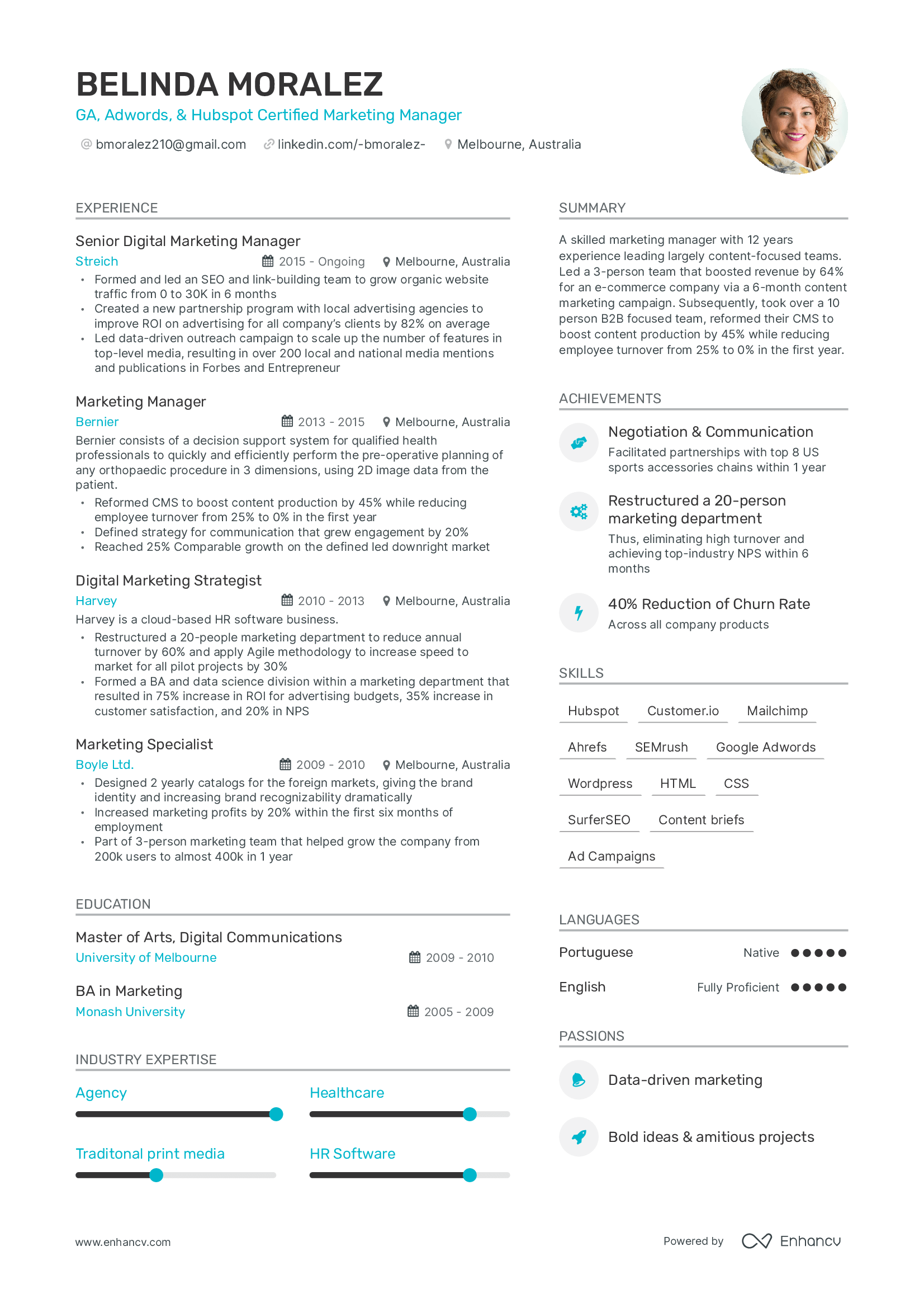
The most popular template for upper management roles, project managers and product owners.
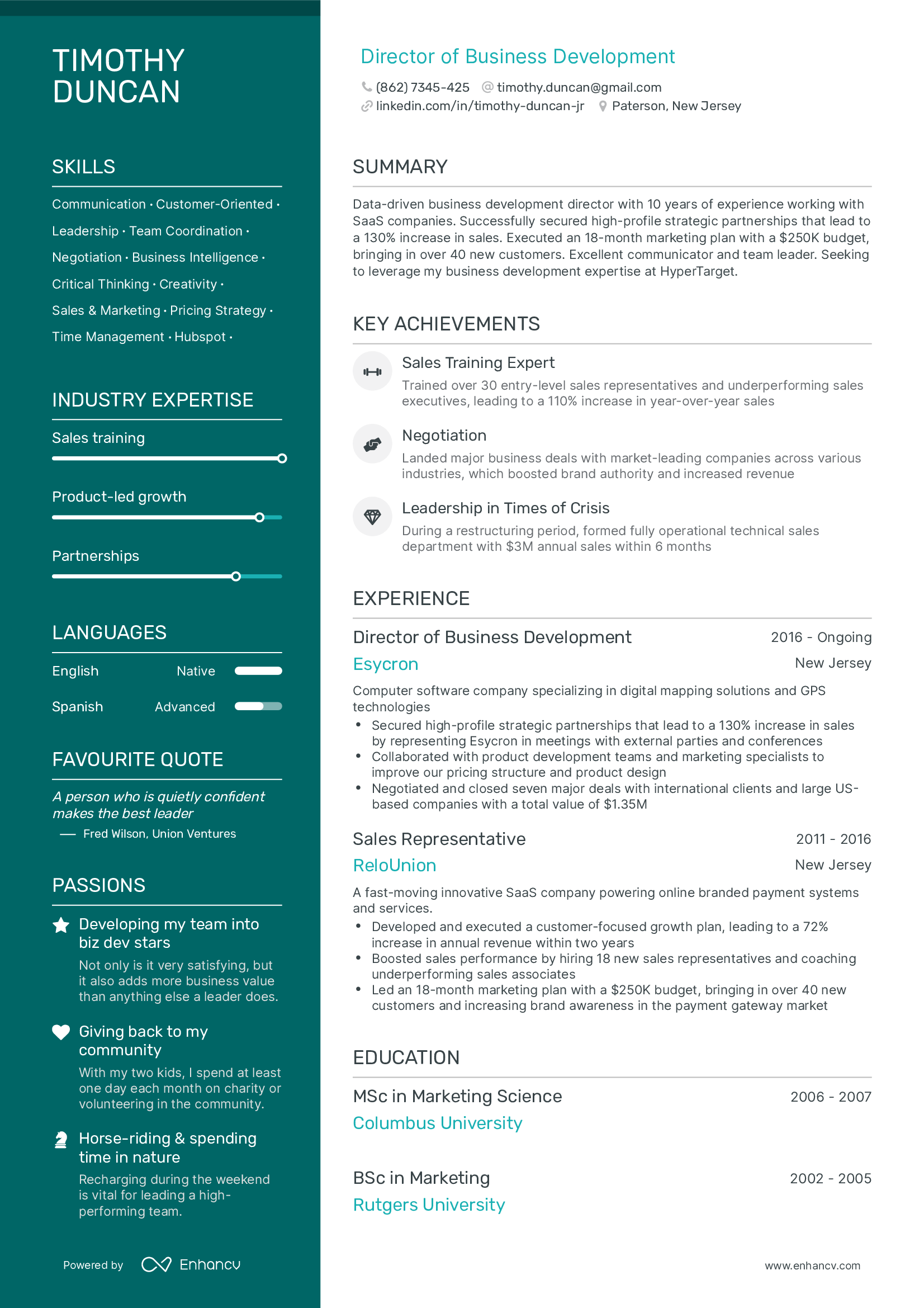
A refined template, especially great for positions where presentation is paramount: business development managers, sales leaders & other customer-facing roles.

A creative template that accents your header and makes recruiters want to read the rest. Built for any industry.

A timeline resume template. Organized neatly with a Timeline to show your career progress. For experienced professionals.

Are you a software engineer or a data scientist with a lot of skills & projects to list on your resume? This template allows you to create a perfect one-page resume.
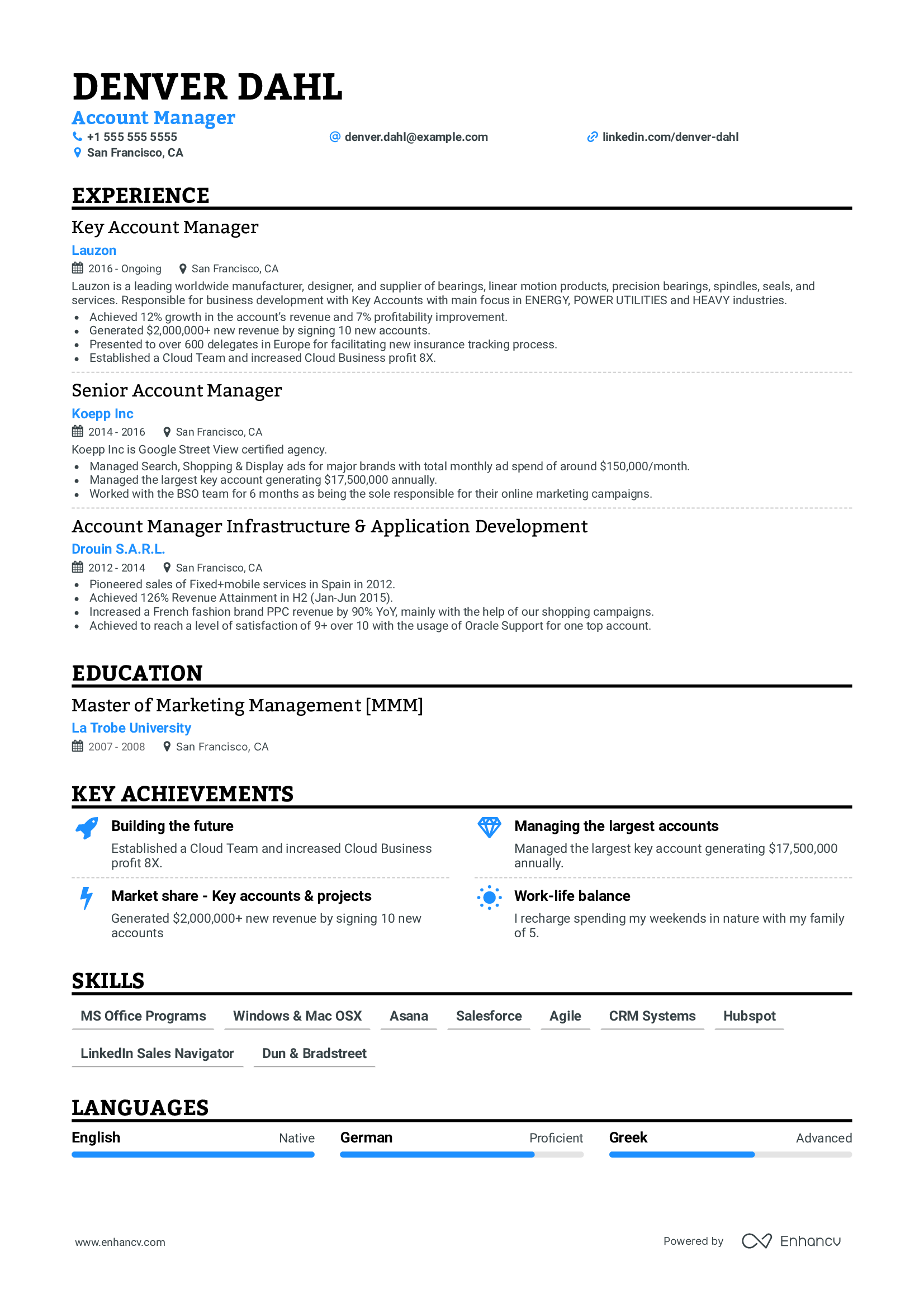
Single Column
Free, simple resume template. Easily readable by both humans and ATS bots.
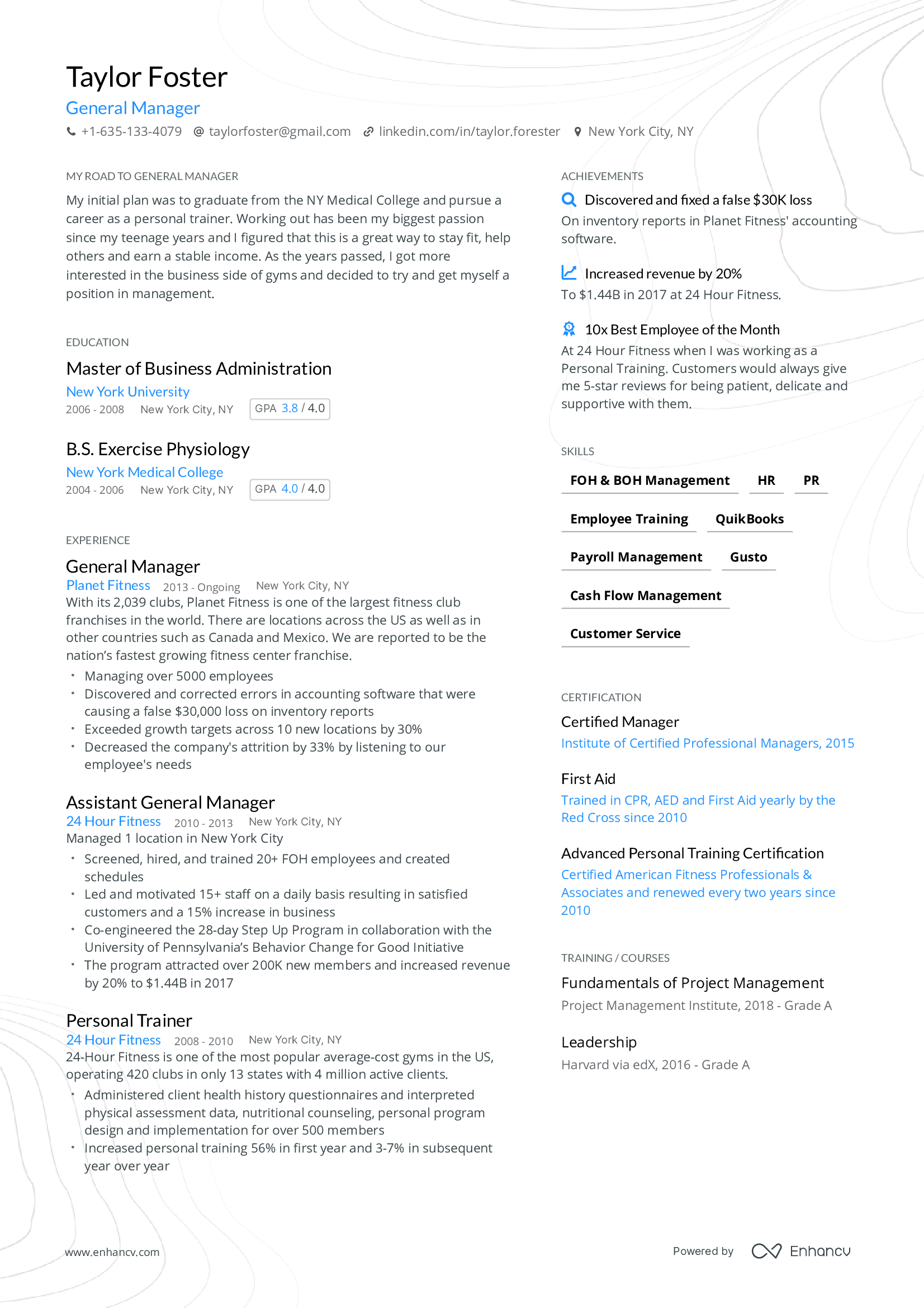
Designed as a one-page resume template for mid-level roles with 3-10 years of experience.
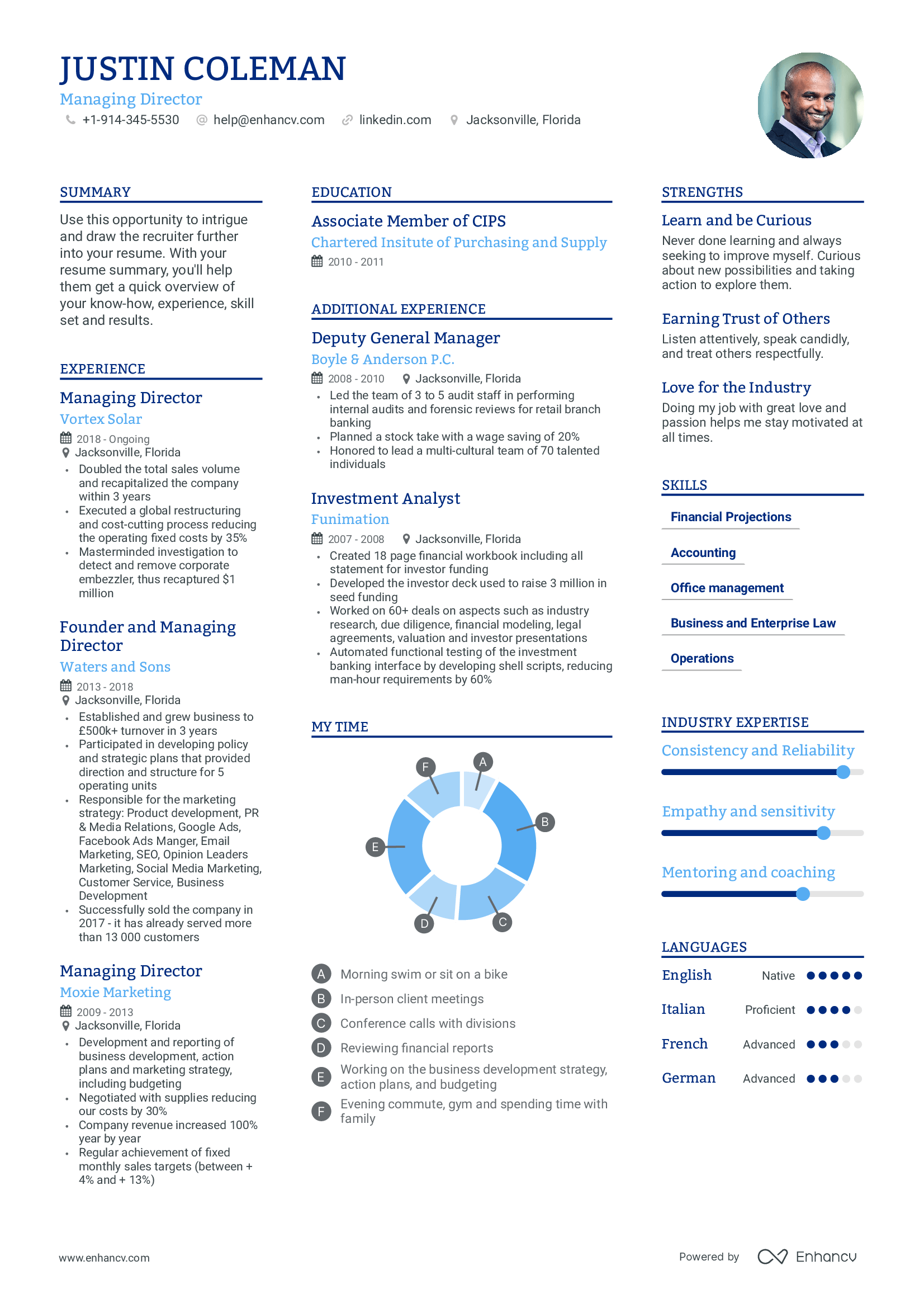
Multicolumn
Multicolumn resume template. Made for executives to fit additional info in a third column.
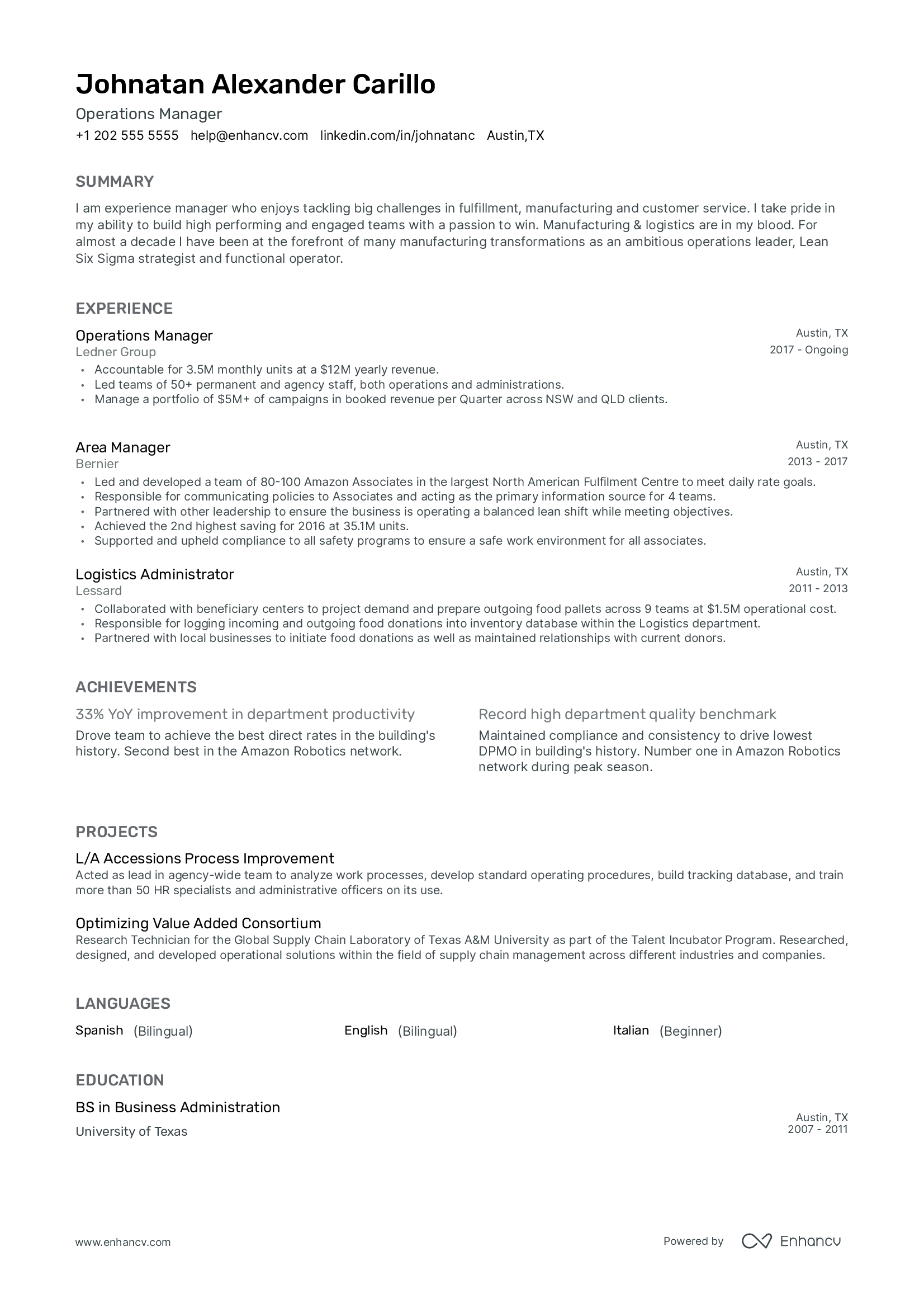
Traditional resume template. Fitting for conservative industries.
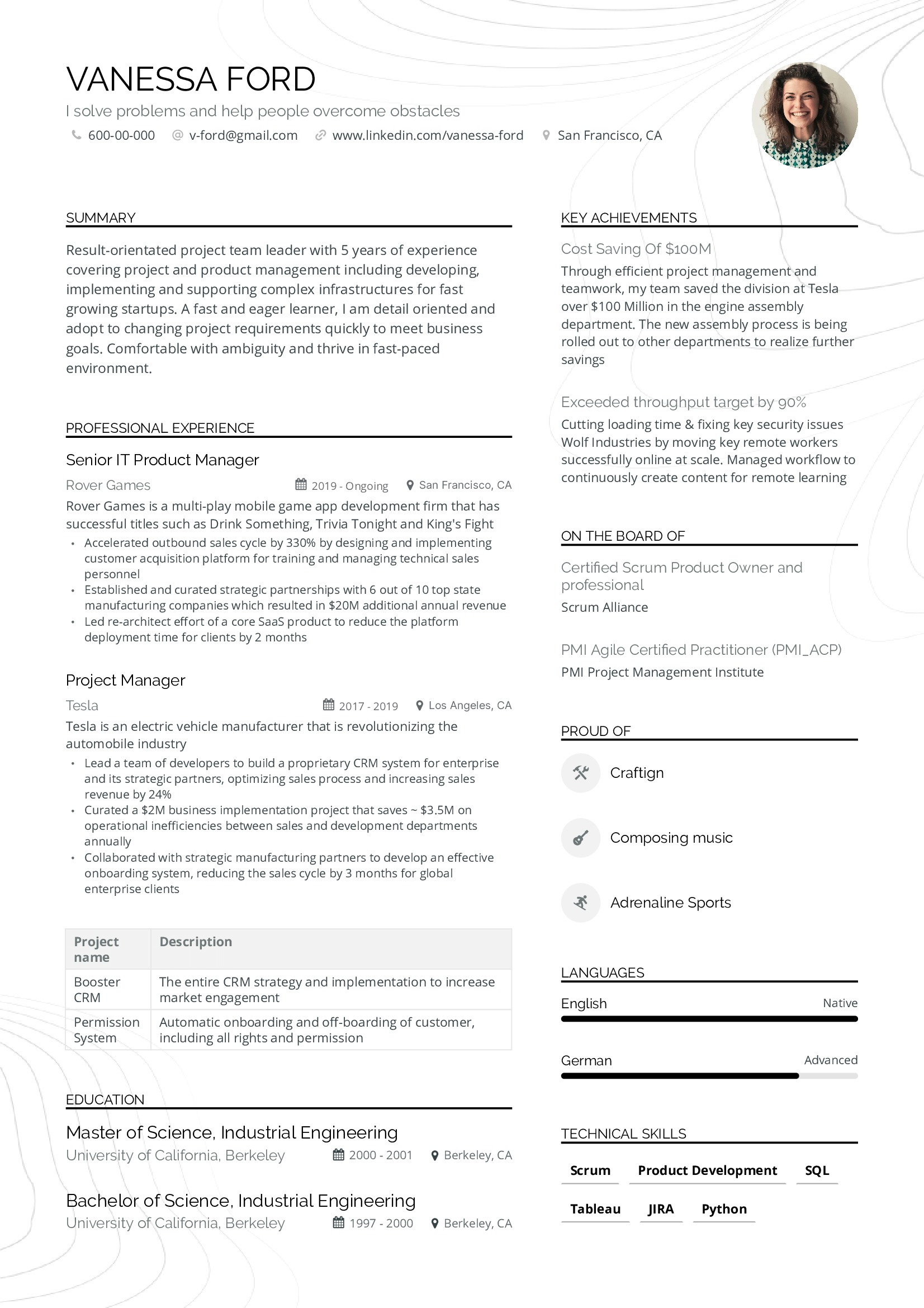
High Performer
Data-focused resume template. Perfect for project and product managers.

Minimalistic resume template. Blends whitespace and content, without clutter.
Resume Templates by job
Unleash the full potential of your career with professionally vetted resume templates. Take a look at samples from real resumes that helped people get hired at top companies in your field, and build a job-winning resume yourself.
Search more resume examples by job
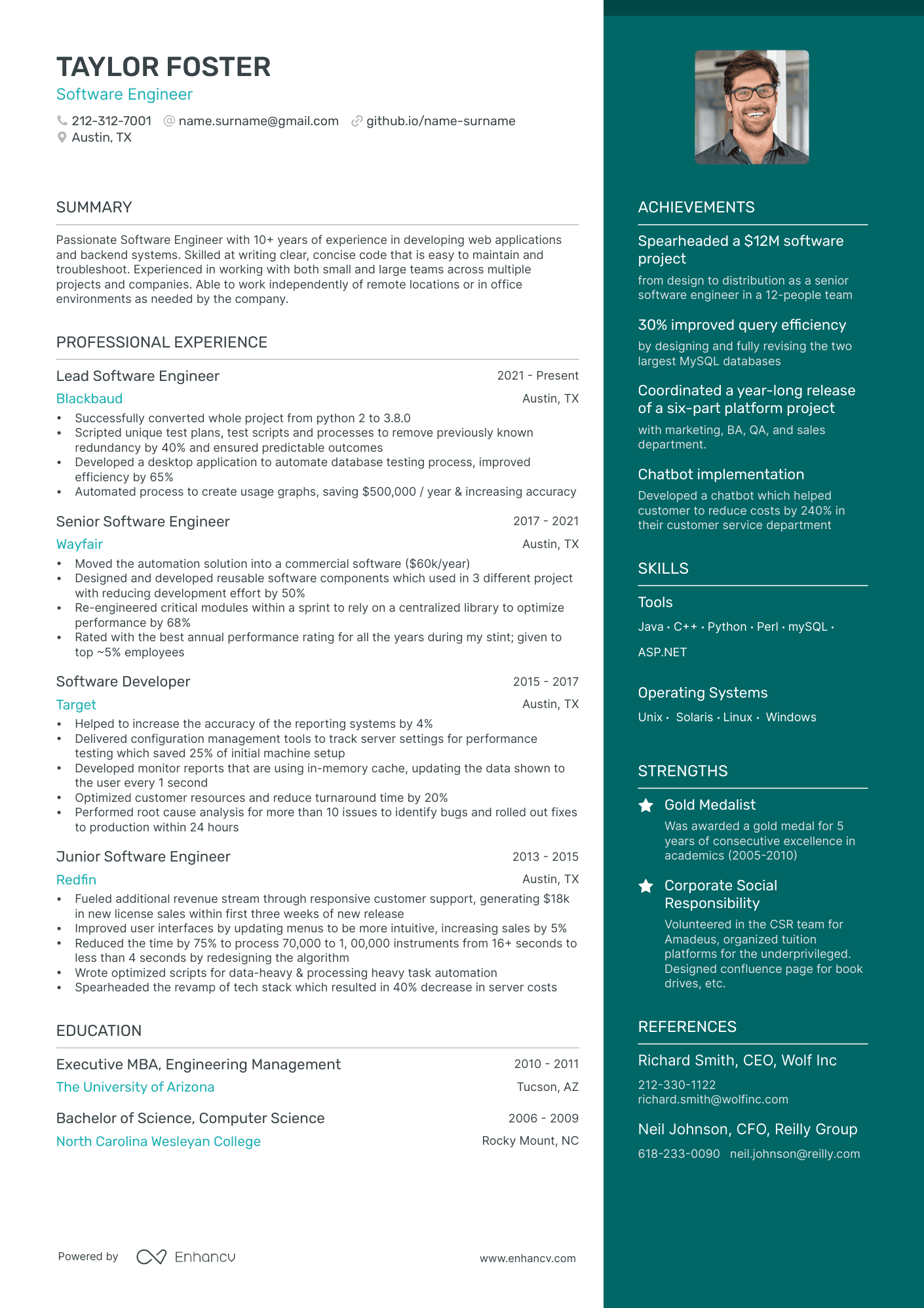
Software Engineer
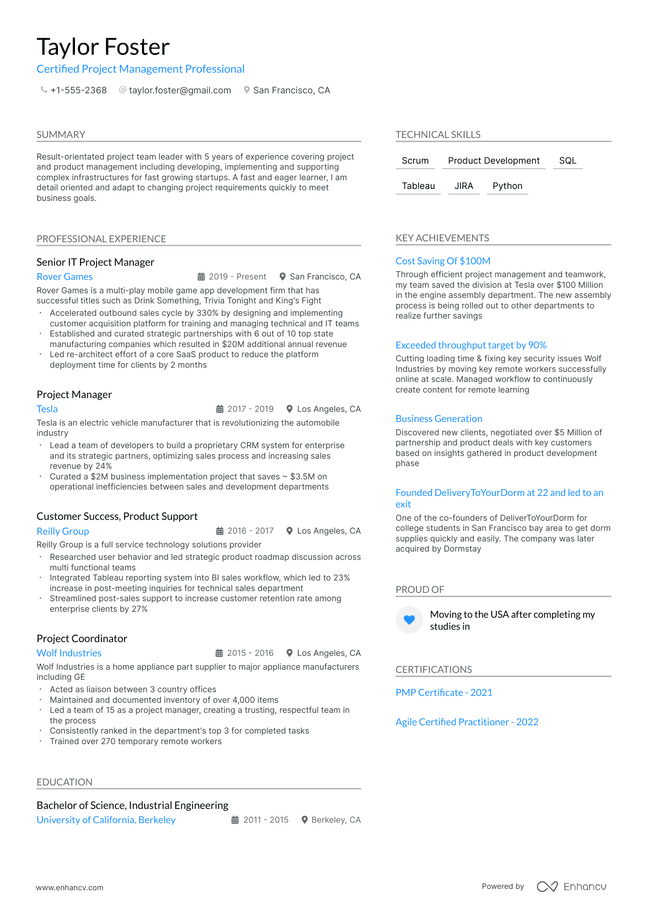
Project Manager

Product Manager

Account Manager
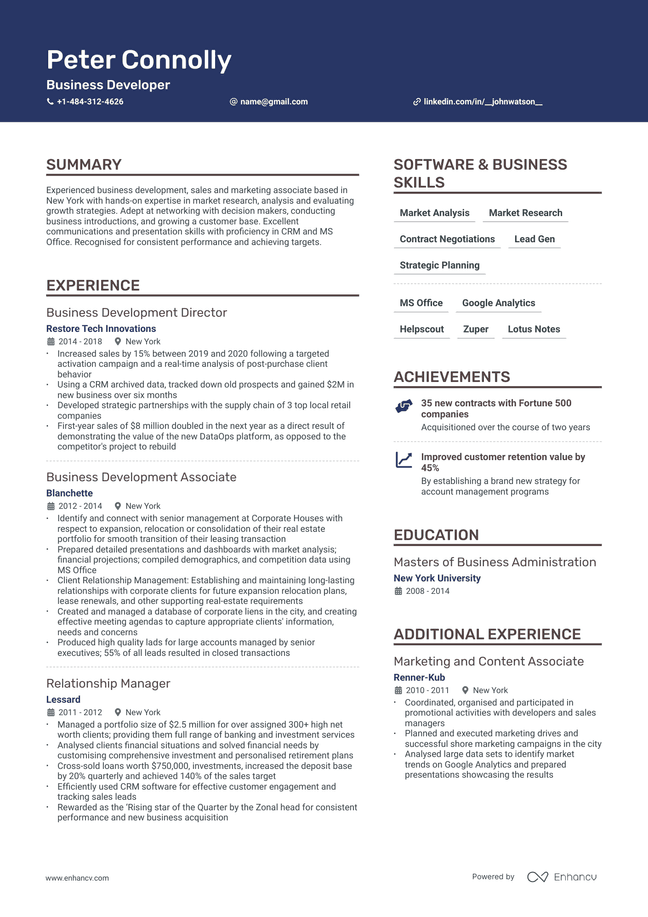
Business Development
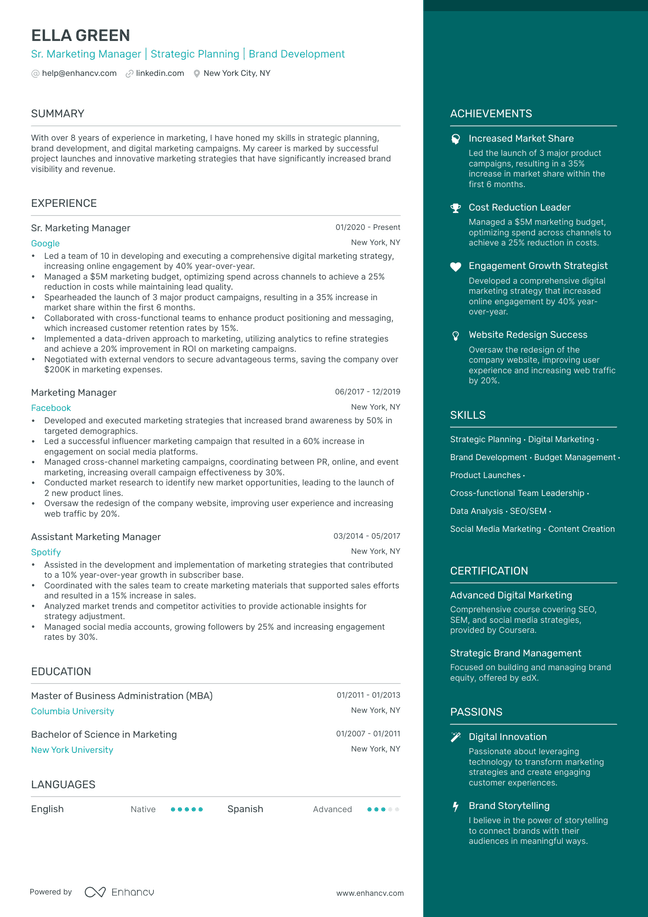
Marketing Manager
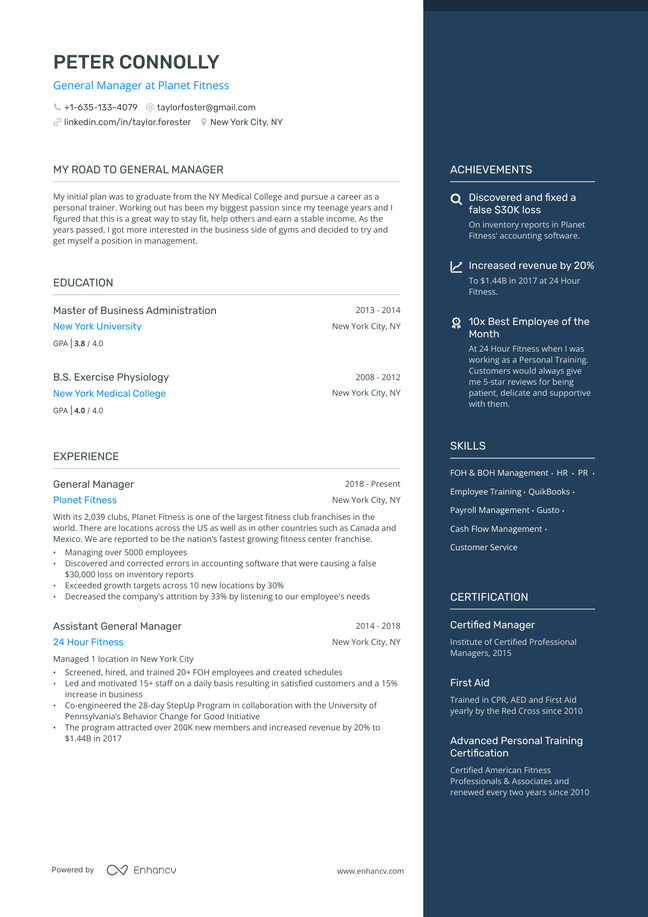
General Manager

Operations Manager

Business Analyst
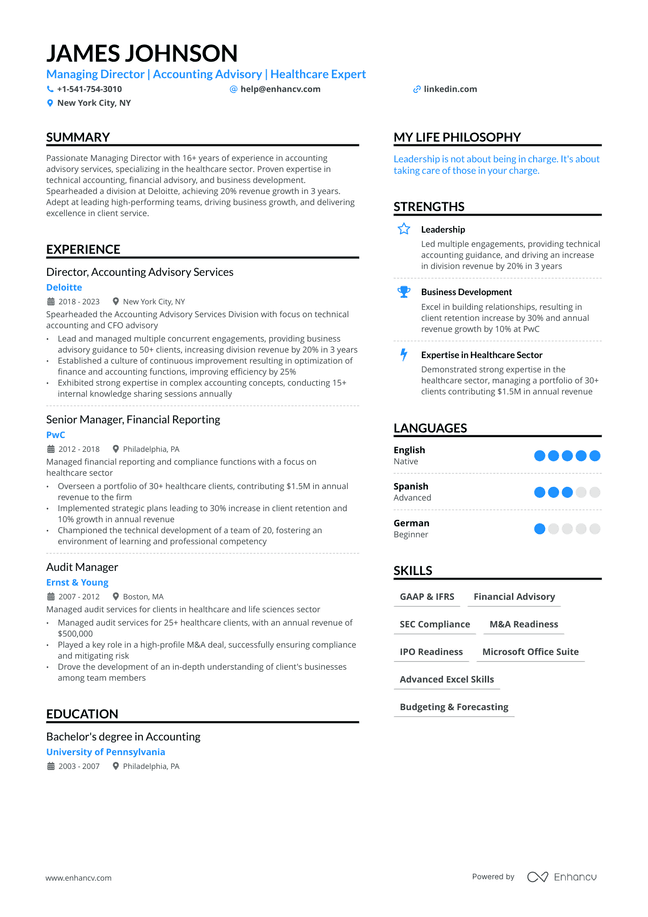
Managing Director
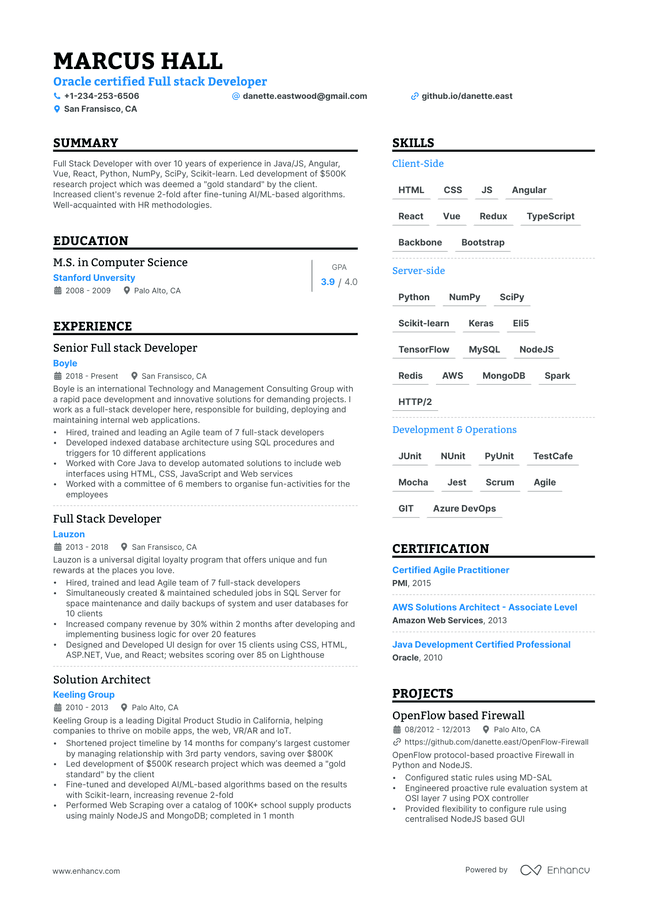
Full-Stack Developer
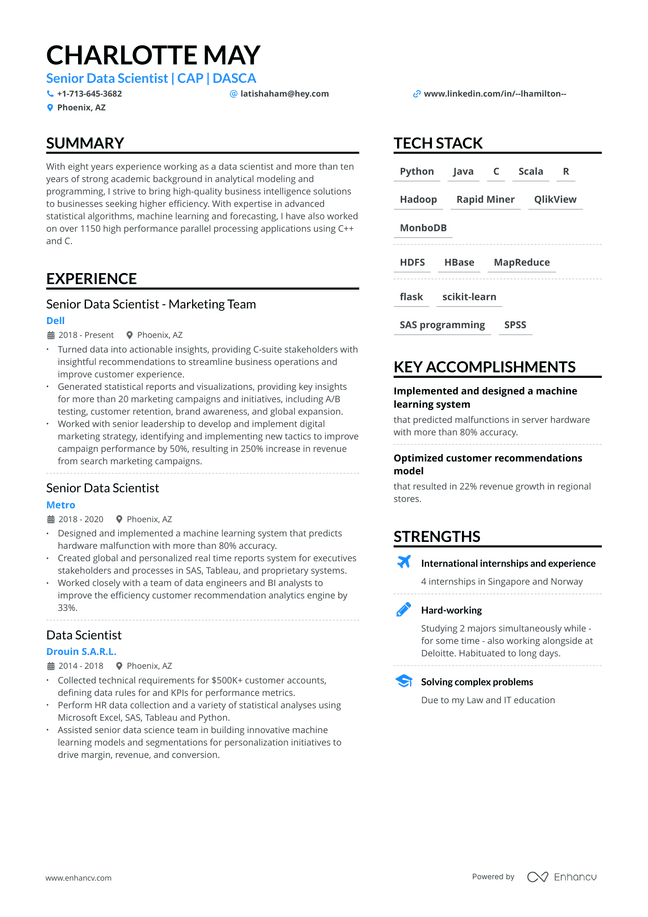
Data Scientist
Resume templates by experience.
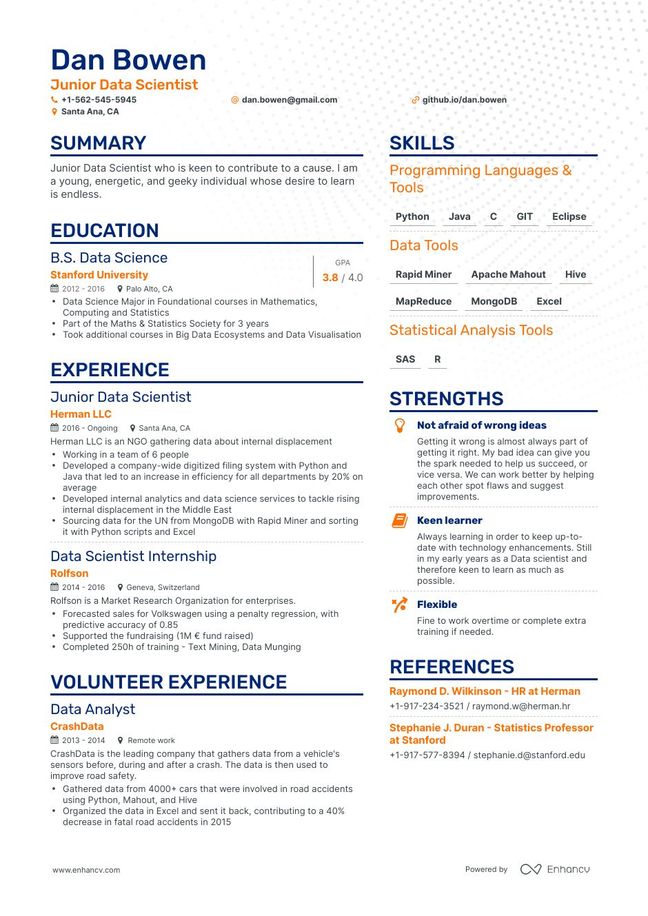
(1-3 years of experience)
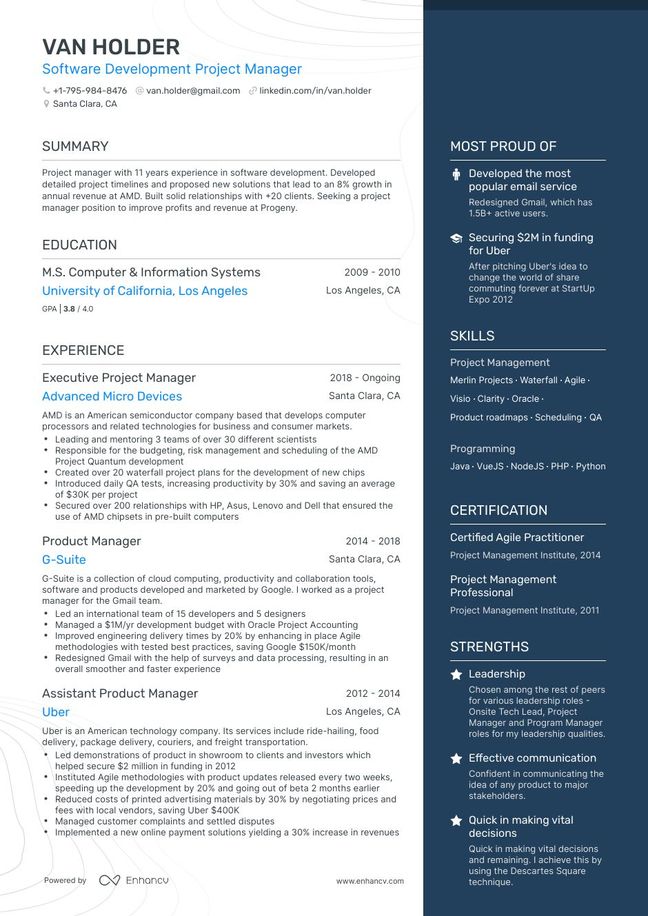
(3-7+ years of experience)
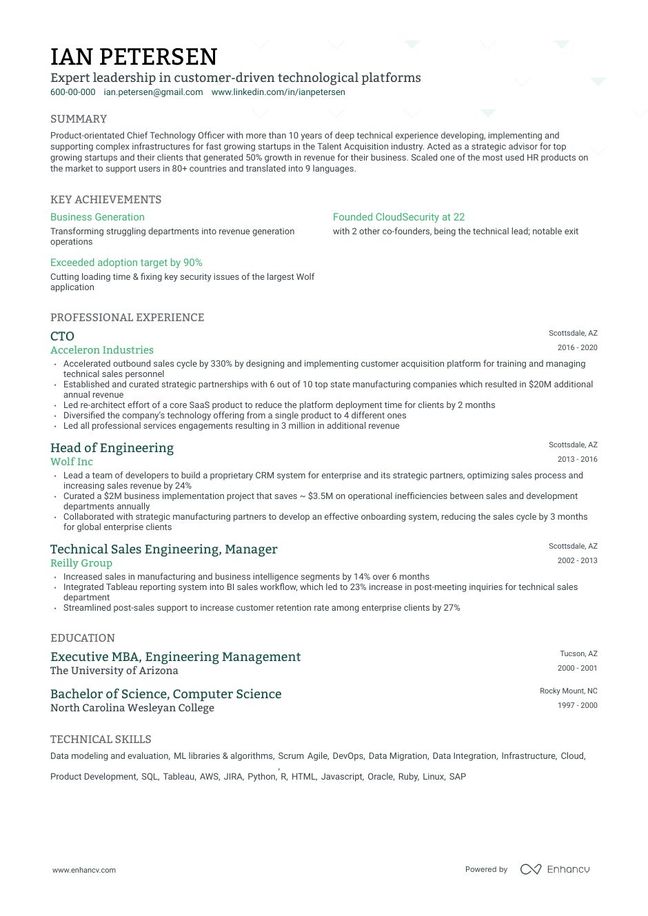
10+ years of experience)
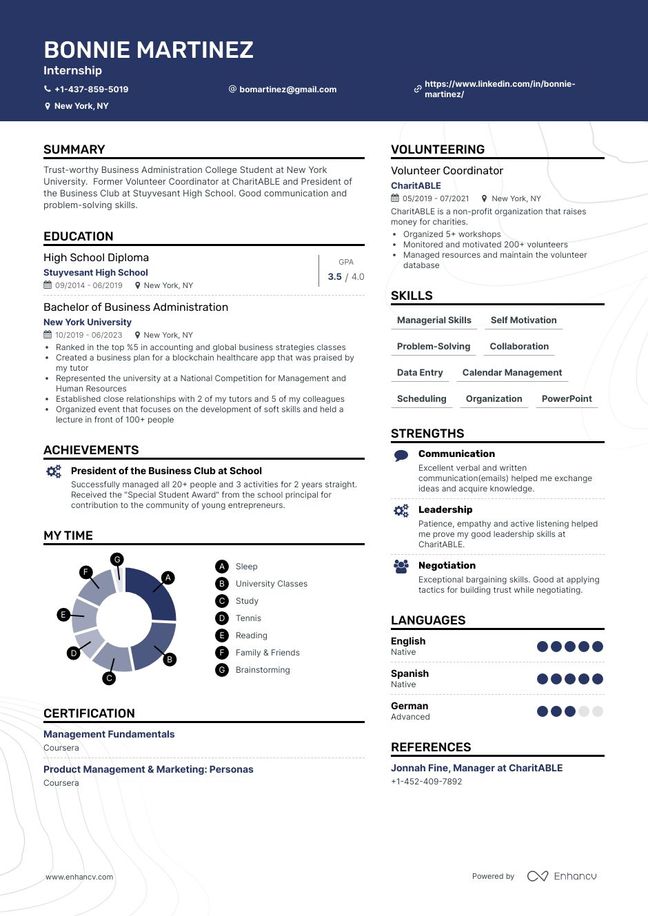
Entry Level
(no prior experience)
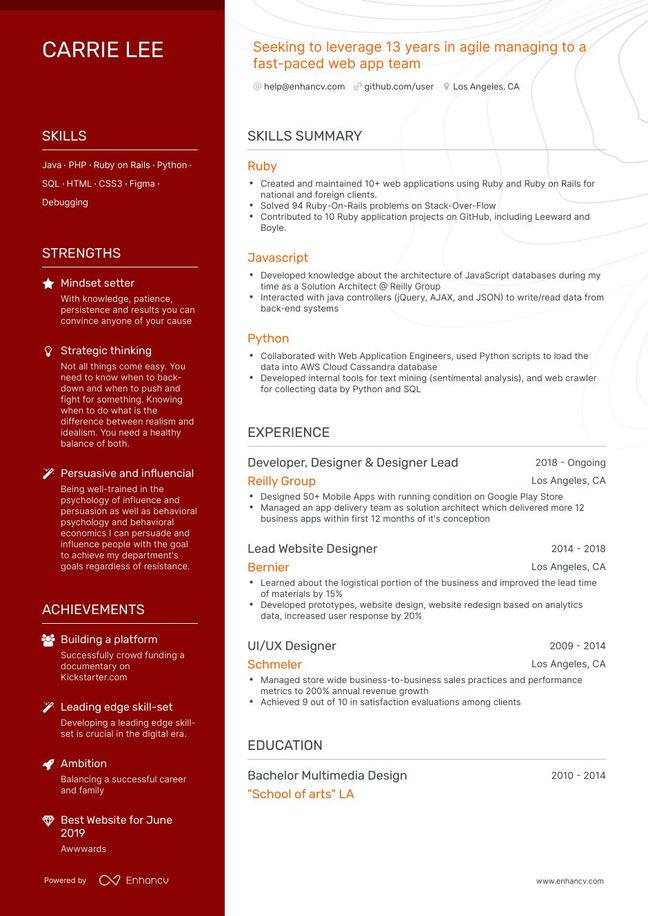
Career Change
Resume templates by format.

Combination Resume Templates

Corporate Resume Templates

Infographic Resume Templates
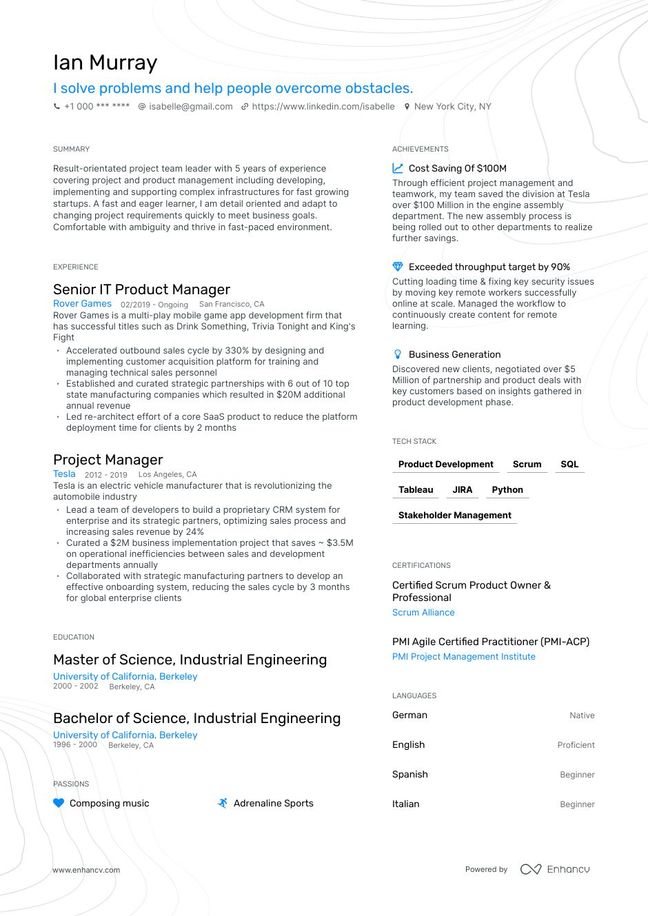
One Page Resume Templates

Timeline Resume Templates

Chronological Resume Templates

Functional Resume Templates

Minimalist Resume Templates

Two Column Resume Templates
- Modern Resume Templates

- Simple Resume Templates
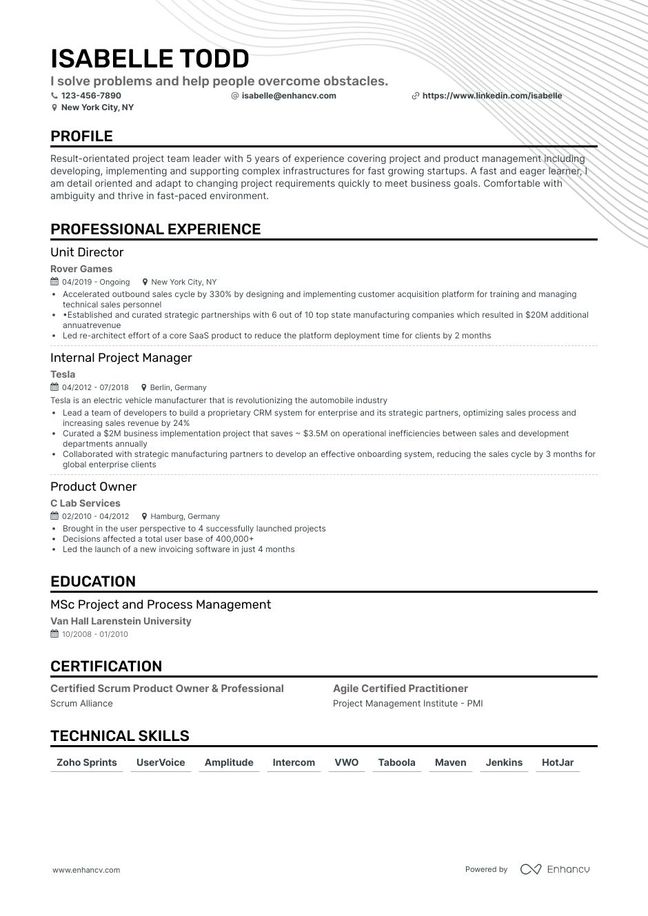
- Create Resume
- Terms of Service
- Privacy Policy
- Cookie Preferences
- Resume Examples
- AI Resume Builder
- Resume Summary Generator
- Resume Formats
- Resume Checker
- Resume Skills
- How to Write a Resume
- Cover Letter Builder
- Cover Letter Examples
- Cover Letter Templates
- Cover Letter Formats
- How to Write a Cover Letter
- Resume Guides
- Cover Letter Guides
- Job Interview Guides
- Job Interview Questions
- Career Resources
- Meet our customers
- Career resources
- English (UK)
- French (FR)
- German (DE)
- Spanish (ES)
- Swedish (SE)
© 2024 . All rights reserved.
Made with love by people who care.
The online resume builder getting folks hired by BBC, Google, Apple, Tesla, and Airbnb.
Build your brand-new resume in as little as 5 minutes. try it for free..
No credit card required
Featured In
Recruiters Love Our Resume Builder. Learn Why Below.
P.S. The video is less than 2 minutes
Resume Templates for Every Career Path.
You can pick one of our handcrafted resume templates above. You can start building your resume in less than 5 seconds, using predefined sections approved by recruiters worldwide. You can also customize it to your own needs and personality and hit 'Download'. It's THAT easy to use, even if you've never made a resume in your life before!
Build Your Resume Fast and Easy.
Novorésumé is lightning fast. There's no software to download. No multi-part sign-up form. No long-winded tutorials. Just a straightforward process.
Why Use The Novorésumé Resume Builder?

Introducing e-learning!
Whether you're job hunting, planning a career shift, or aiming to enhance your professional skills, our e-learning feature is designed to tackle your unique challenges .
- Top-notch content by certified experts
- Address specific challenges using tailor content
- Help us shape the final product
- Receive discounts and exclusive content
Novocareer is the latest addition to our platform, and we're excited to embark on this journey with you. Together, we'll shape and expand the content to meet your evolving needs and aspirations.
Premium Features for Ambitious Job-Seekers
The job market today is competitive – you’ll need every edge to stand out. Here’s how Novorésumé Premium can help you:

The jobseeker's
The guide to getting hired in 2024
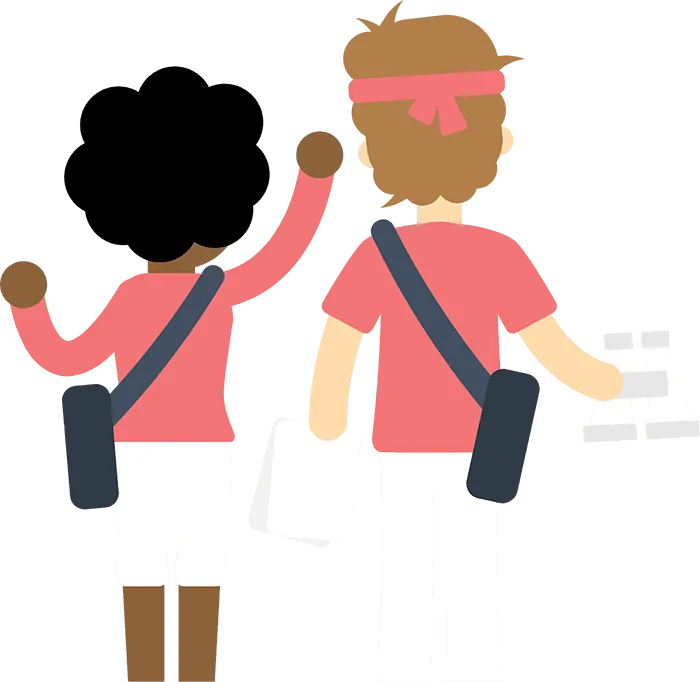
Job Search Masterclass
Don’t have much career experience? Not sure how to write your resume, ace your interview, or land that job? Check out our Job Search Masterclass! We’ll teach you how to do the following:
- Create a Resume That Grabs Recruiters’ Attention Every Single Time
- Ace Your Interview (Even if You’re an Introvert)
- Find a Job You’ll Love (And Actually Get It)
Resume Builder FAQ.
Ready to jump-start your career.

To provide a safer experience, the best content and great communication, we use cookies. Learn how we use them for non-authenticated users.

IMAGES
VIDEO
COMMENTS
Here's how to write a resume when you have no formal work experience, step-by-step: Build My Resume. Our free-to-use resume builder can make you a resume in as little as 5 minutes. Just pick the template you want, and our software will format everything for you. 1. Choose the best format and style for your resume.
Writing a resume with little or no experience doesn't have to be frustrating. Focusing on transferable skills that you've developed is the best way to create a resume that gains the recruiter's attention. Think about nontraditional ways you have gained experience through volunteering, hobbies or school projects. ...
How to format a resume with no experience: Follow the reverse-chronological order (i.e. put the most recent info up top). Add section headings to make your first-job resume easier to navigate. Use professional-looking fonts that are easy on the recruiter's eyes. Stick to the 11-12pt size range for regular text.
Read more: 3 Ways You Can Deal With Change at Work. 8. Public speaking. Even if the job you're applying for doesn't involve much public interaction, public speaking is a great skill to put on a resume with no experience. It signals you're a confident person who can communicate effectively.
Even if you haven't held a formal leadership role, experiences such as leading a project or working in a team can demonstrate these skills. 3. Problem-Solving Skills. Being able to approach problems with creativity and adaptability is a sought-after trait.
Select an appropriate template. 3. Add contact info to the header. When you write a resume without experience, your mission is to get an employer's attention and get called for an interview. That makes your contact info extremely important and something you should highlight at the top of your document in the header.
Ability - aptitude to get up to speed quickly on the job. Keep these two traits in mind while writing your resume and add any relevant experiences that show that you have the attitude and aptitude for the job. 1. Professional summary (even if you have no experience)
7. Write a cover letter. Cover letters boost your chances with your employer, especially at entry-level jobs. This is because it gives you an excellent opportunity to stand out, particularly if you have no work experience. As a new professional, writing your first resume is a thrilling experience.
But first: Here's a job-winning formula for a good resume profile: Start with a personality trait that says you're a great employee, such as "dedicated," "goal-oriented," "personable," etc. Follow with the desired job title, field of study, or education level, e.g., "third-year BBA student" or "personal assistant.".
Use quantifiable metrics to highlight what you accomplished in your past utilizing these skills. If you have no previous work experience, use examples from your academic, sports, or volunteer work. Example: "Implemented new inventory processes that cut overhead costs by 23%.". Add another top transferable skill.
For example, if the job description uses the phrase "team player," ensure you include that similar phrase in your skills or experience section. However, you can go deeper by reprioritizing the skills you share and the tone you set to match the company branding. 8. Show, Don't Tell.
4. Write a summary statement. At the top of your resume, create a summary statement that briefly describes your relevant experience and achievements. In one or two sentences, aim to create a positive impression that helps make the hiring manager want to continue reading.
When writing your resume, be sure to include a section highlighting your skills. This should include any technical skills or language proficiencies that are relevant to the job you are applying for. ... If you have no work experience, highlighting your skills is a great way to make your resume stand out. Here are some tips on how to do that: 1 ...
Updated 17 April 2024. Writing your first resume is a major step in any new professional's career. This is your opportunity to showcase why you're an excellent candidate and how you've prepared yourself to succeed in your first job. When you're entering the job market for the first time and creating a resume with no work experience, you ...
Work experience (which will be substituted with other sections when you have no work experience) Education. 2. Incorporate your contact information. Now that you've chosen the best format for a resume with no experience, it's time to complete each section. The first section of your resume is the header section.
If you have no experience you can point to in your resume, highlight your education, include relevant non-work experience, list your skills, and include a summary. Get started by using a template. 1. Highlight your education. If you have little work experience, emphasizing your education is a great way to showcase your strengths, interests, and ...
Making a resume early in your career feels like a classic catch-22: A good resume highlights relevant work experience, which you don't get until you land a job.. The truth is you don't always need professional experience for entry-level jobs. By highlighting your existing skills, coursework and extracurricular activities, you can craft a resume that will impress employers — even without ...
Pro tip: consider adding a resume headline under your name to give your resume a boost. STEP 5 Highlight your strengths in a no experience resume objective . Every resume needs a summary or objective statement.For a beginner resume, we recommend a resume objective to explain your goals for the job and highlight some of your job-relevant skills.
1. Identify your goals for writing a resume with no experience. 2. Choose a suitable resume format for a no-experience resume. 3. Write a strong resume objective. > The objective for the resume with no experience examples: > Resume Objective for Students with No Experience. 4.
3. Pick and choose what to include. Focusing on what not to include in a résumé is just as important as focusing on what goes into it. When applying for a job with no relevant experience, sometimes certain elements of a traditional résumé can be left out. This can include specific work experience that is not relevant to the job or even some ...
Resume with no experience example. This resume example shows you the basic format of a resume, and the type of content you can include when you have no experience. I will now walk you through how to produce your own effective resume. You can watch the video below or read through the rest of the guide on this page.
Use keywords. Take some time and look over the job description and look for keywords. It's a great way to tailor your resume to each job while highlighting the skills that they are looking for. Apply for the roles that fit your skills. When you don't have experience, you want to find jobs that fit your skills.
When to use this format: You have no obvious gaps in your employment and want to emphasize your career progression. The chronological resume format is the most common type of resume. Think of it as the "default" format - it's what everyone learns to write when they start looking for work.
Before you start working on your resume, remember that your resume is not your biography. You're not telling the story of your life. Instead, your resume should be a targeted document meant to showcase the skills and experiences that match the job you want.. This means that if something is not relevant to your targeted job, leave it out.With this in mind, let's start building your resume!
If you're a recent graduate: Since you likely have little to no work experience to show, a resume objective can give a glimpse into who you are and what you aim to achieve. If you've worked in a variety of roles: When your work history is all over the place, a resume objective statement can be a helpful tool to highlight your most relevant ...
To write a strong resume objective, first research the company and think about how your personal background (experience, skills, education, and interests) makes you the best fit for the role. Once you determine what details will be most compelling to the employer, summarize it in three sentences, like this:
Whether you're an entry-level worker with no experience, a C-Level Exec, or it's your first time creating a resume, the following free resume templates will help you get started. Just click on the one that best will suits your needs, replace the content with your skills and achievements, and hit download. It's that easy!
You can pick one of our handcrafted resume templates above. You can start building your resume in less than 5 seconds, using predefined sections approved by recruiters worldwide. ... Don't have much career experience? Not sure how to write your resume, ace your interview, or land that job? Check out our Job Search Masterclass! We'll teach ...
Contrary to popular belief, you don't need to include every job you've ever had on your resume. The type of experience you should include in your resume will depend on your desired job and unique situation. For instance, how you write a resume with no experience will differ vastly from writing a resume for a retired job seeker.
2. Target your resume to each job description. When writing your work experience section, it's important to tailor it to the job you're applying for.. To do this, you'll need to read the job description carefully to identify which keywords to include on your resume.. Here's a job ad for a customer service position with all the skills and experience-related keywords highlighted: